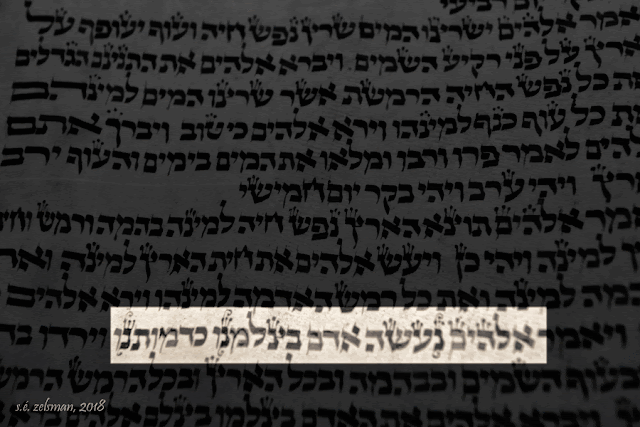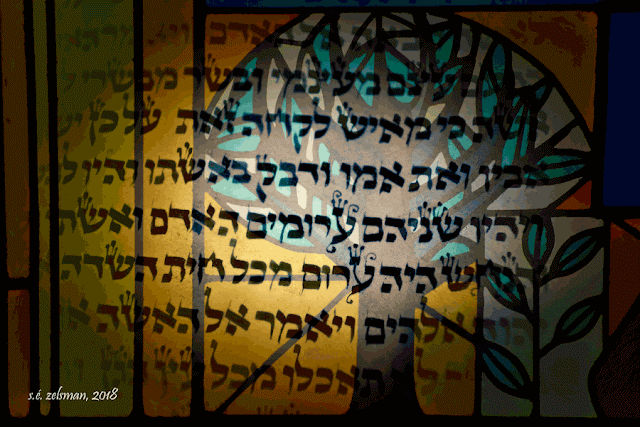czechitout
Czech Torah Project at Beth Emeth Bais Yehuda
March 11, 2019
Songs for the Breathing Walls
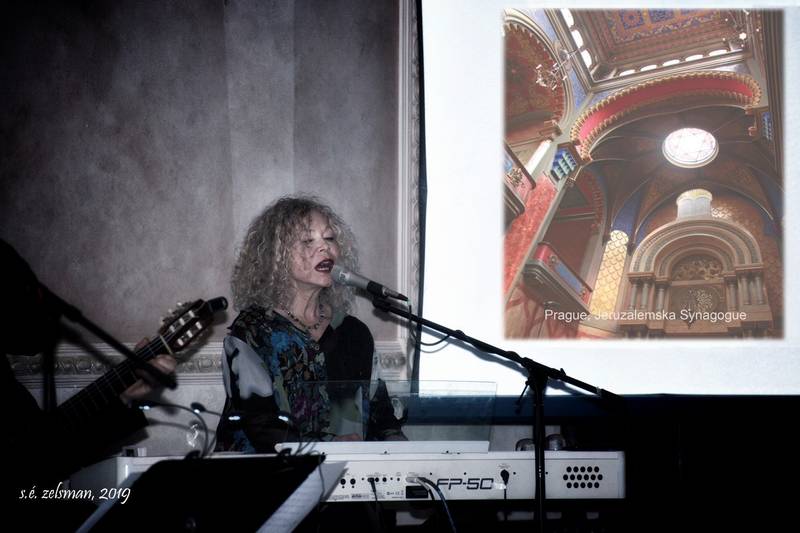
On March 6, 2019, over 75 concertgoers had an opportunity to delve into Czech history and the history of our Czech Torah through songs and images. The concert they attended was led by Lenka Lichtenberg. Lenka is a Canadian composer, vocalist, bandleader and producer and is of Czech-Jewish descent. Lenka’s songs were in Yiddish, English, Czech and Hebrew which brought together the music and history of vibrant Jewish Czech communities most of which perished during the Holocaust.
The multi-media presentation of vibrant images of Czech synagogues both past and present and presented the concertgoers glimpses of the vibrant Jewish history where our own Czech Torah would have thrived.
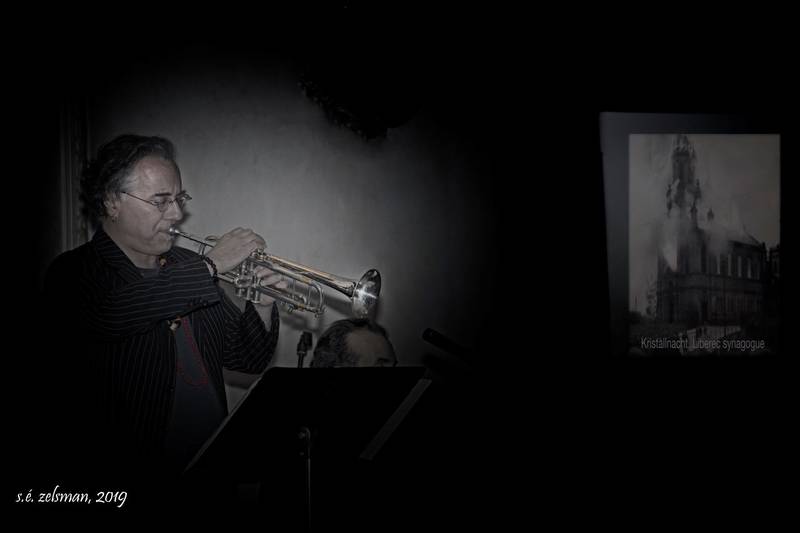
Just as this concert gave voice to the spirit of those Jewish communities, so does the restoration of our beloved Czech Torah.
This program was generously sponsored in memory of Morris Cissie and Marcella and Pauline Indech, ז"ל who perished in Auschwitz, and in memory of the victims of the Weisfogel family, who perished in Treblinka. May their memories always be for a blessing.
Enjoy the photos from the presentation!
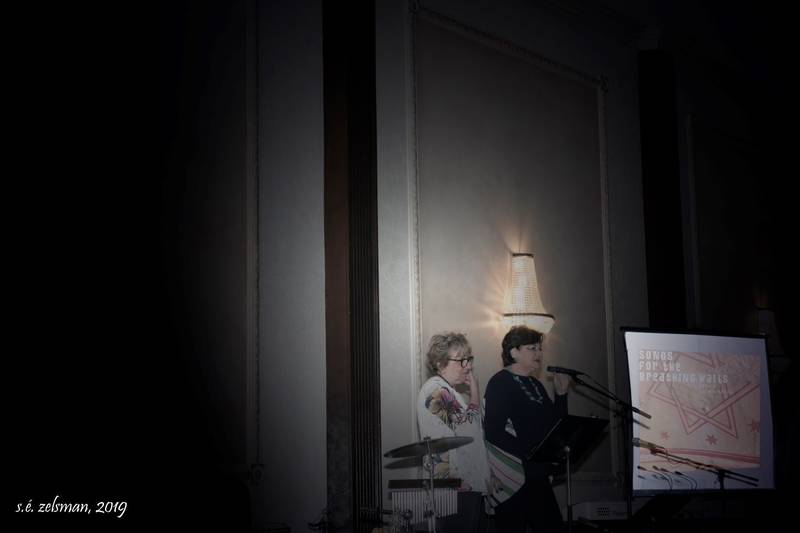
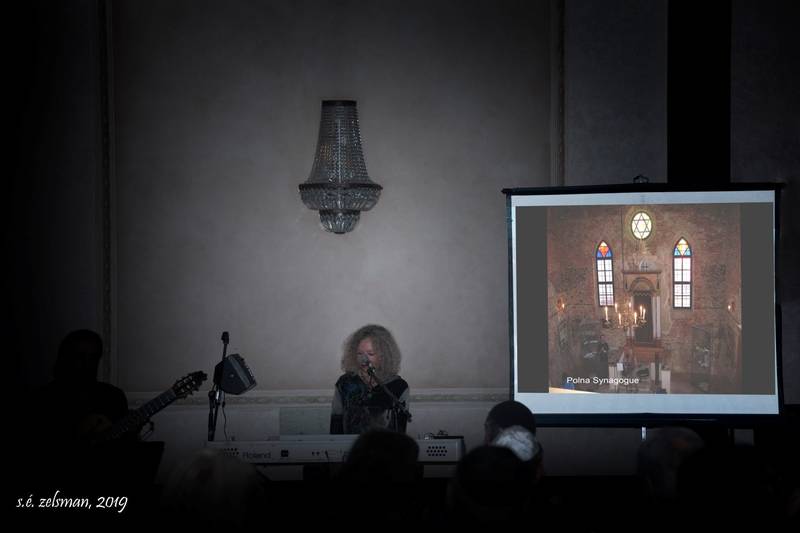
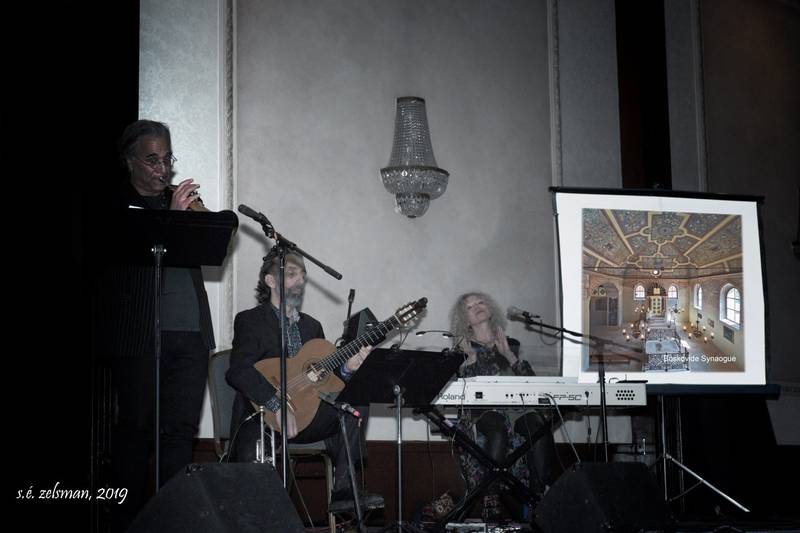
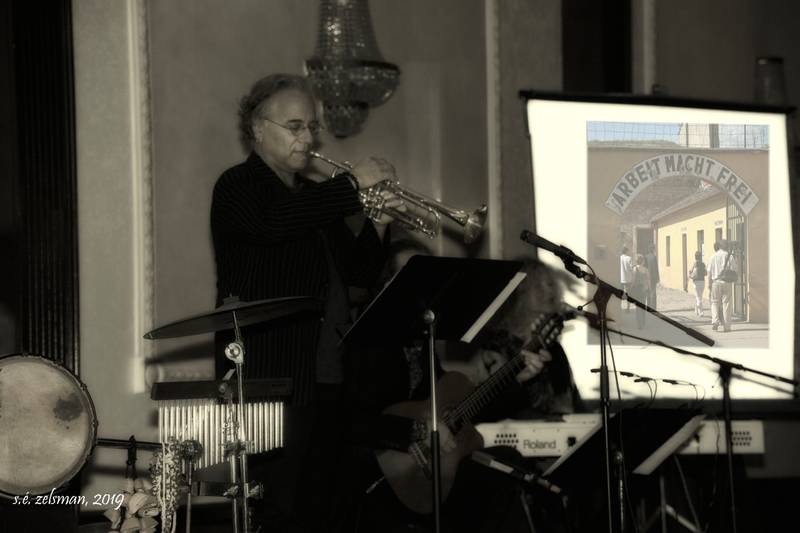
* All images in the multi-media presentation are from Lenka Lichtenberg’s « Songs for the Breathing Walls project » and used by permission here.
---
This article is the eighteenth in a series of short photo essays to help our community members see and learn with us. Please read the first fifteen articles in order for you to learn about the Torah itself and the restoration process. We welcome you in being part of the journey of the Czech Torah Restoration Project at Beth Emeth Bais Yehuda. Please contact the shul office at 4166333838.
January 17, 2019
Bar and Bat Mitzvah Program Special Evening with our Czech Torah
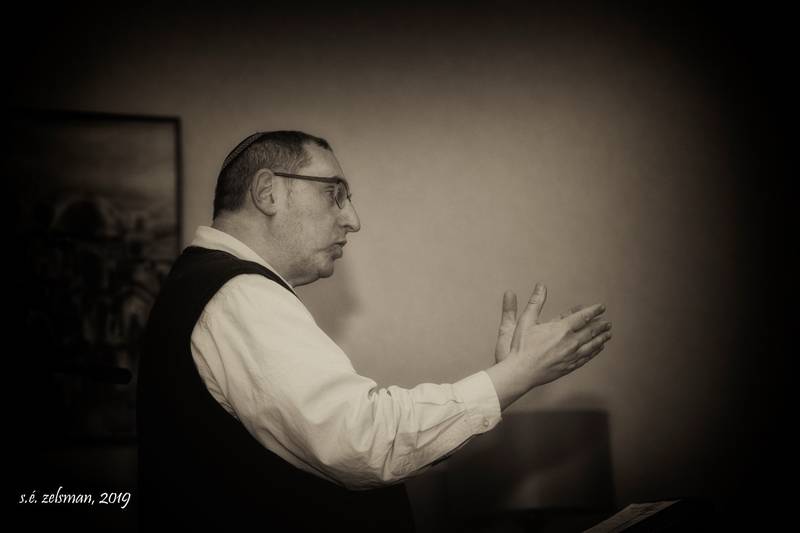
On January 17, 2019, students who participate in our Bar and Bat Mitzvah Program, together with their parents/guardians, enjoyed a very special evening engaging with Rabbi Morrison and Rabbi Grundland to learn about our treasured Czech Torah. Through dialogue and story, our Bar and Bat Mitzvah students were able to make personal connections, learn about the unique history of our Torah and see the Torah up close.
The Czech Torah traveling museum of photos captured throughout the restoration helped our students visualize the distinctive style of our Torah and the careful steps a sofer (scribe) or magiah (proofreader) needs to follow in order to maintain and preserve the kashrut of a Torah.
Their Bar and Bat Mitzvah experience will be further enriched through personal opportunity to research Czech children who perished in the Holocaust. By doing this, our students will honor those who did not survive to celebrate their Bar or Bat Mitzvah during the Holocaust.
Enjoy the photos from the presentation!
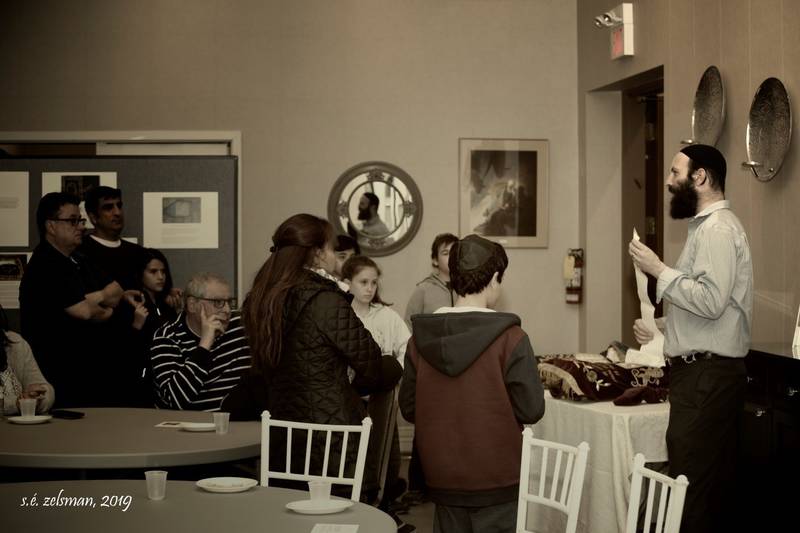
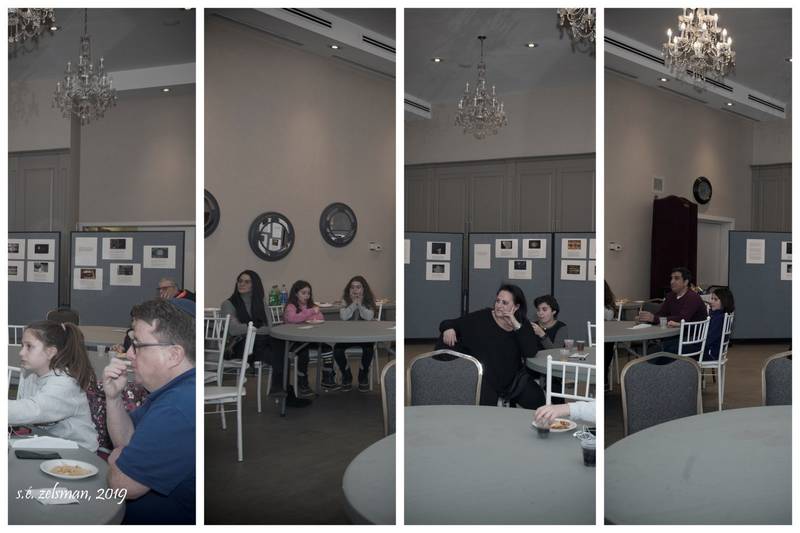
---
This article is the seventeenth in a series of short photo essays to help our community members see and learn with us. Please read the first fifteen articles in order for you to learn about the Torah itself and the restoration process. We welcome you in being part of the journey of the Czech Torah Restoration Project at Beth Emeth Bais Yehuda. Please contact the shul office at 416 6333838.
January 3, 2019
Lenka Lichtenberg: Stories and Music from the Czech Republic
presented by:
Aleph Beit Chadash Hebrew School and Youth and Young Families
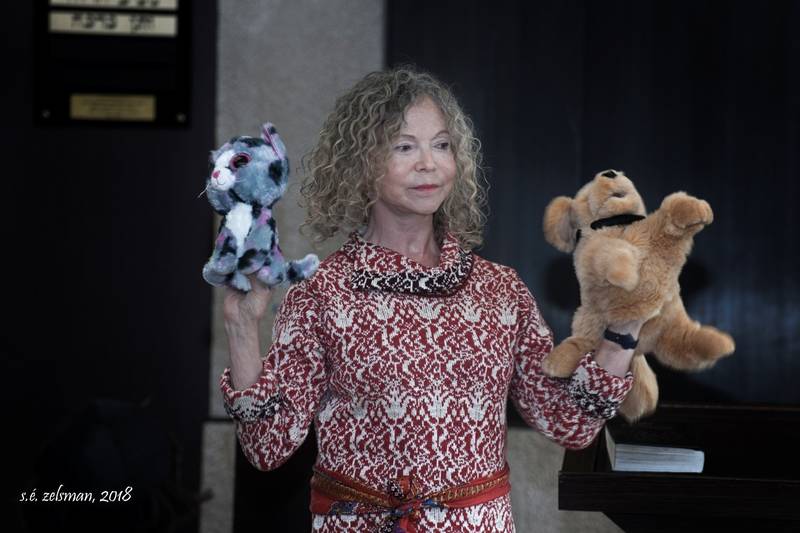
Throughout the restoration process, the Czech Torah Project Committee at Beth Emeth Bais Yehuda is organizing activities to educate our community about the Torah and involve community members of all ages in engaging activities to become part of the new life of this exceptional Torah.
On November 25, 2018, our Aleph Beit Chadash Hebrew School and Youth and Young Families organized an interactive music presentation by Lenka Lichtenberg—musician, composer and singer. Our children, youth and their parents participated in Czech songs, stories, dancing and puppet activities that Lenka taught them. Everyone had an opportunity to see the restored Czech Torah up close and learn about its unique story.
This exciting activity helped our children understand how old our Czech Torah is. They learned how singularly precious the Torah was to the Jewish community of Czechoslovakia who risked their lives to save it and to our synagogue for lovingly restoring it to use once again.
Enjoy the photos from the presentation and be sure to read the first fifteen articles in order for you to learn about the restoration process!
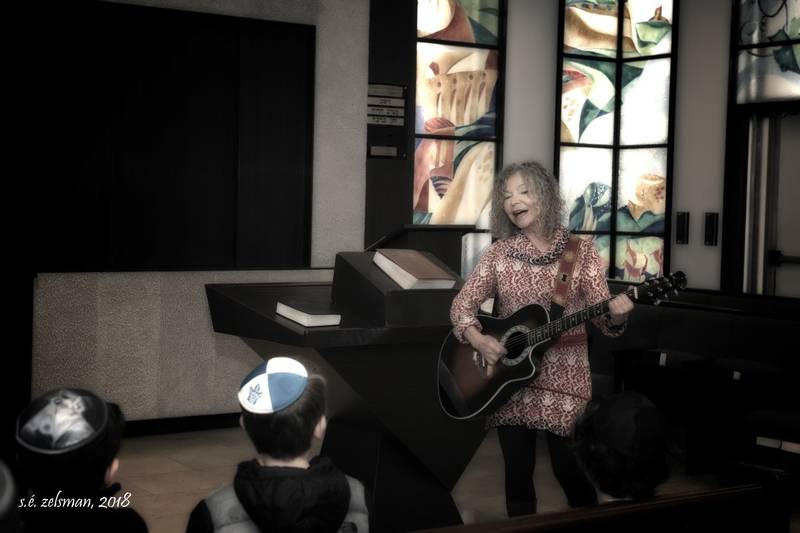
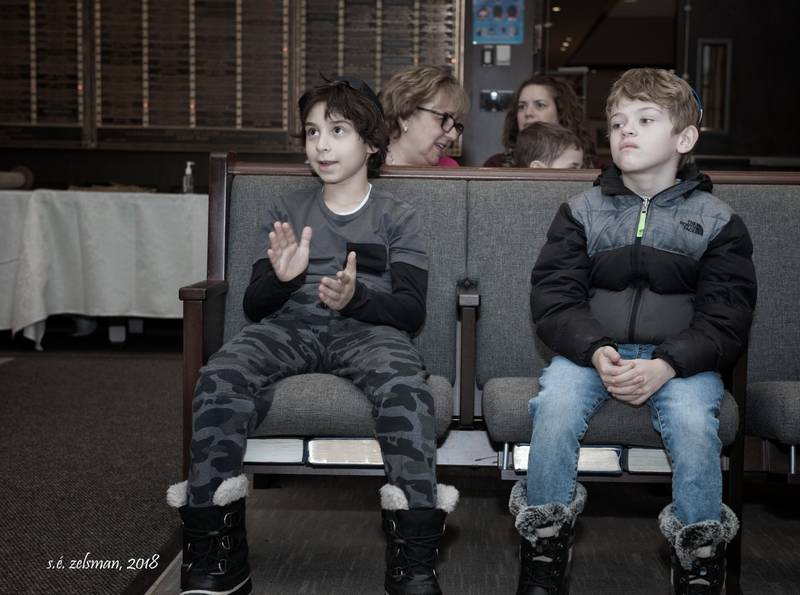
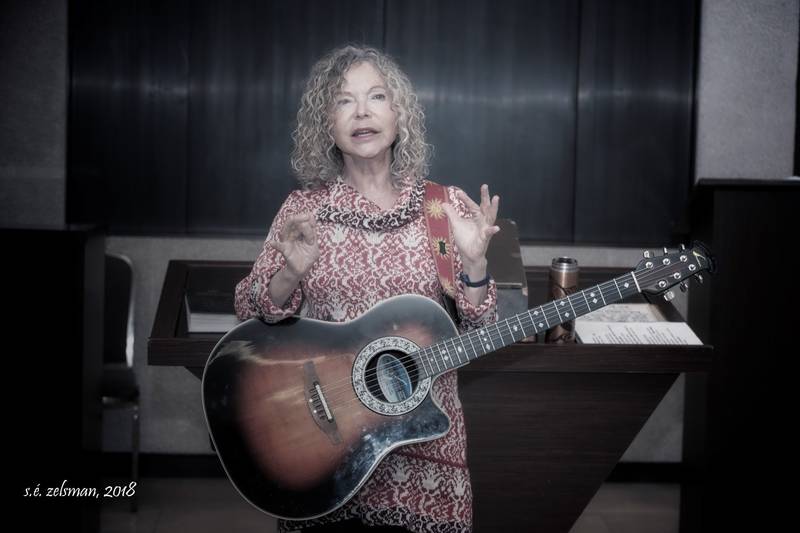
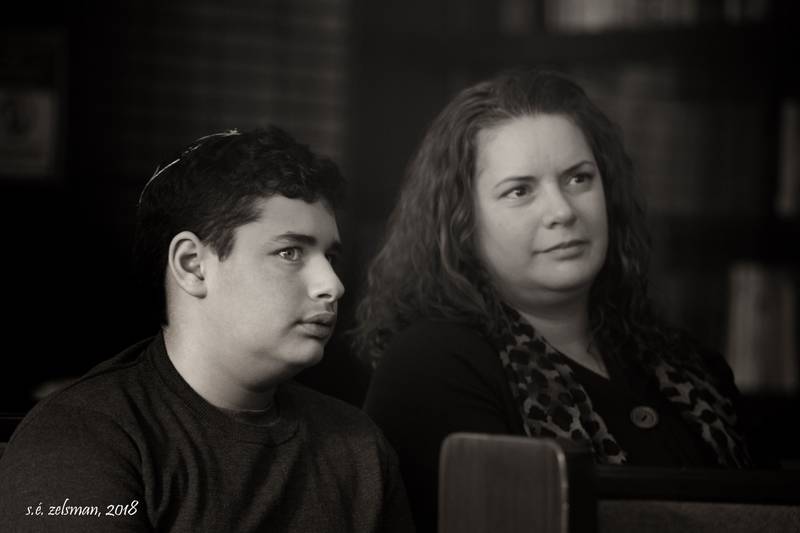
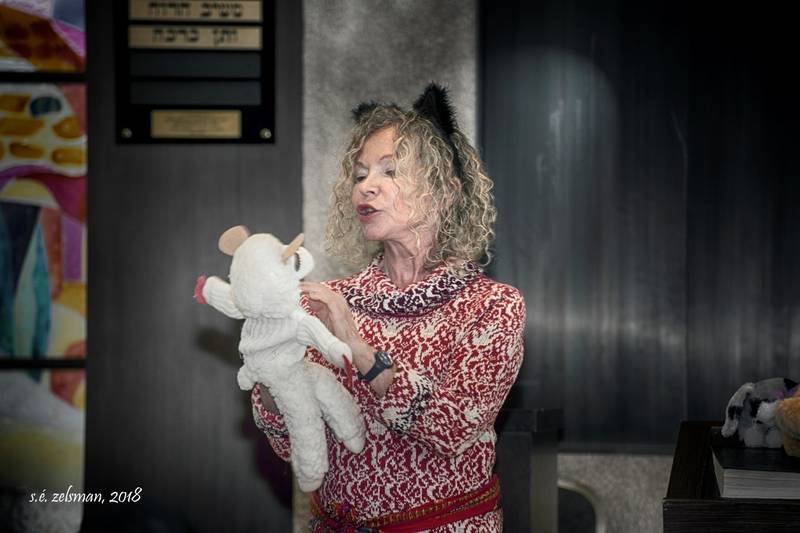
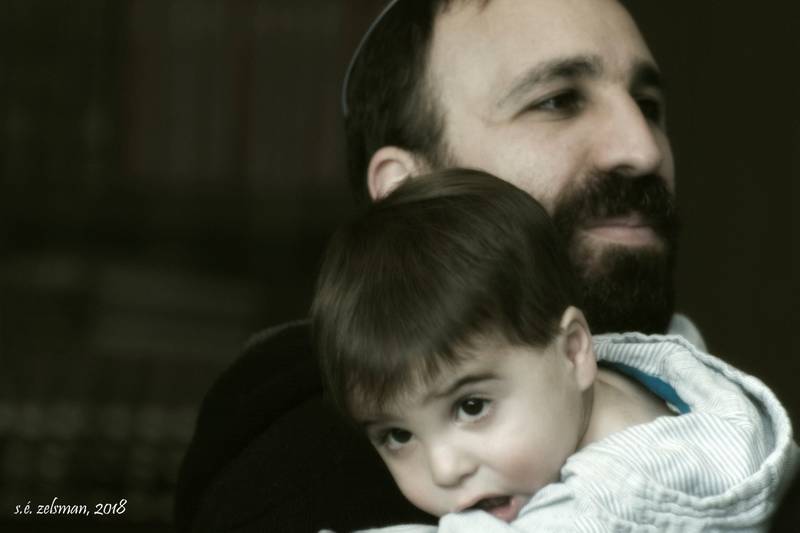
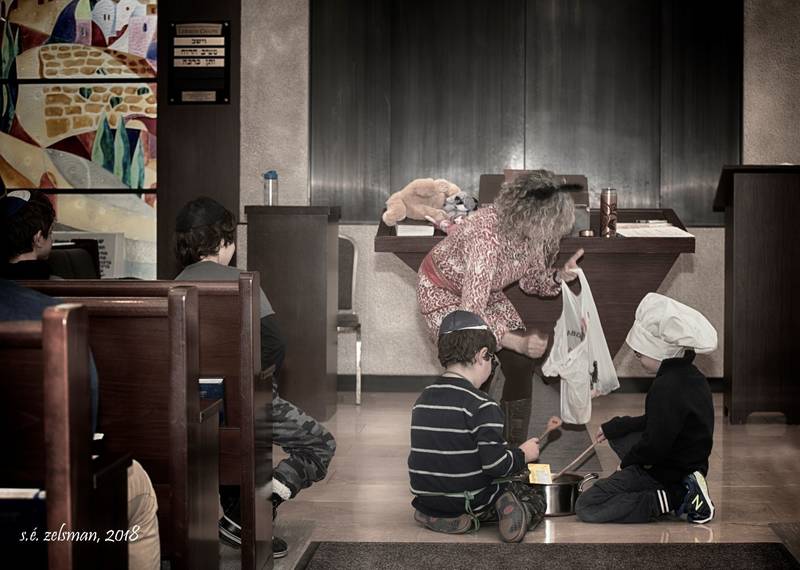
This article is the sixteenth in a series of short photo essays to help our community members see and learn with us. We welcome you in being part of the journey of the Czech Torah Restoration Project at Beth Emeth Bais Yehuda. Please contact the shul office at 416 633 3838.
November 9, 2018
! חזק ! חזק ! ונתחזק
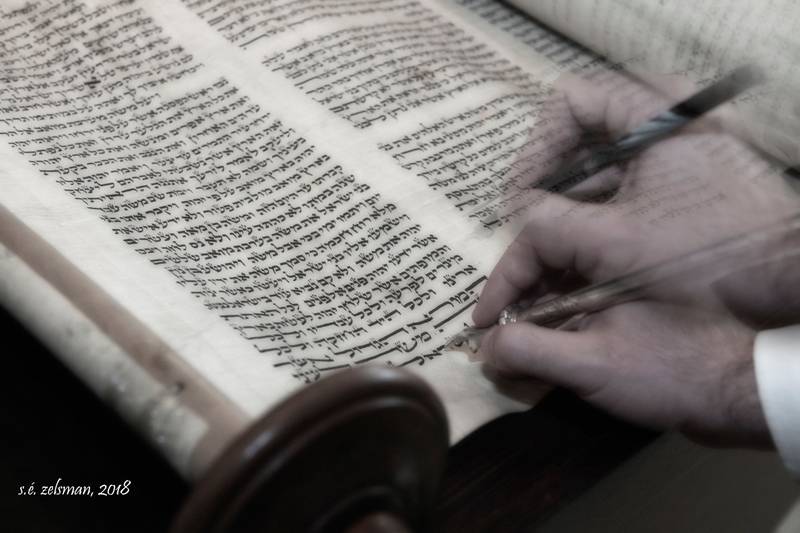
« ! חזק ! חזק ! ונתחזק »
! ונתחזק ! חזק! חזק : Be strong! Be strong! And may we be strengthened! These are the words we recite while standing in complete respect during Shacharit on Shabbat upon completion of each of the five books of the Torah. How appropriate a title are these words since our Magiah (proofreader)—Rabbi Zacks, has completed the restoration of our beautiful Czech Torah and it is now kasher and can be used during services.
You might be wondering on what date Rabbi Zacks completed the restoration. While the date he began the work was given, the date he completed the work will not be mentioned. This is because our Torah is now fully living. It has no final date. Besides, it will always need regular inspection to ensure that it always remains kasher so that we can lovingly read from it. We recall that this Torah was living for centuries and was hidden away from Nazi destruction during the Holocaust. The Jewish community of Prague who stored it risked their lives doing so. The over 1 500 Torah scrolls that they did preserve was done in the hopes that one day, the Jewish community would be strong again and the Torah scrolls would be used once more.
How is this understanding conveyed in the photograph (photo image) above? In the image, you see the Torah scroll opened to the very end of V’Zot HaBracha—the last parsha of the Torah. The Magiah’s hand is photographed twice—once holding the pen with which he makes corrections, and once with the yad (the pointer in the shape of a hand) we use when reading from Torah. The hands are holding the pen and the yad identically over the last word of the Torah which is Yisrael, although this is not readily visible with the superimposing of the hand holding the pen. Your eyes will move naturally from one hand to the other. This was done purposefully so that you get a sense of knowing there is completion, but there is continuation because you go from correction (restoration, care, maintenance) to actual use. The fluidity between both actions shows our love for this Torah—for all Torah. And each time we use this Torah in our shul, we will always be reminded of its history and we will always remember that we have fulfilled the hopes of the Jewish community of Prague.
The translation of the Hebrew words has also been understood as Let us be strong! Let us be strong! And let us strengthen others! This translation is very applicable to the entire theme of the previous 14 articles written about the restoration. First, we know that this determination to survive and thrive was a driving factor of the Jewish Community of Prague during the Holocaust. Second, the eighth and ninth articles of this series were devoted to anti-semitism throughout the ages—with the first written record in the book of Shemot, and to the plight of the children of Theresienstadt—the ghetto outside of Prague. Now, with virulent, violent and murderous anti-Semitism and anti-Israel activism on a massive surge, we need to be strong together, to strengthen each other and strengthen our eternal support of Israel.
Rabbi Zacks who first brought the Czech Torah to our attention understood that. Allan Snow—our shul president, who believed in the preservation of the Czech Torah understood that. Clement Cohen—our shul member who lovingly donated this Torah understood that. Rabbi Morrison who spoke passionately to us about the importance our Czech Torah understood that. Eleanor Minuk--co-chair of the Czech Torah Project Committee, together with the committee members understood that.
It is our hope that you will understand that also, and therefore, enhance your involvement in our shul, engage with our Jewish community and your proud support our homeland, the State of Israel.
---
This article is the fifteenth in a series of short photo essays to help our community members see and learn with us. We welcome you in being part of the journey of the Czech Torah Restoration Project at Beth Emeth Bais Yehuda. Please contact the shul office at 416 633 3838.
November 1, 2018
TWO DISCOVERIES AND A TEST
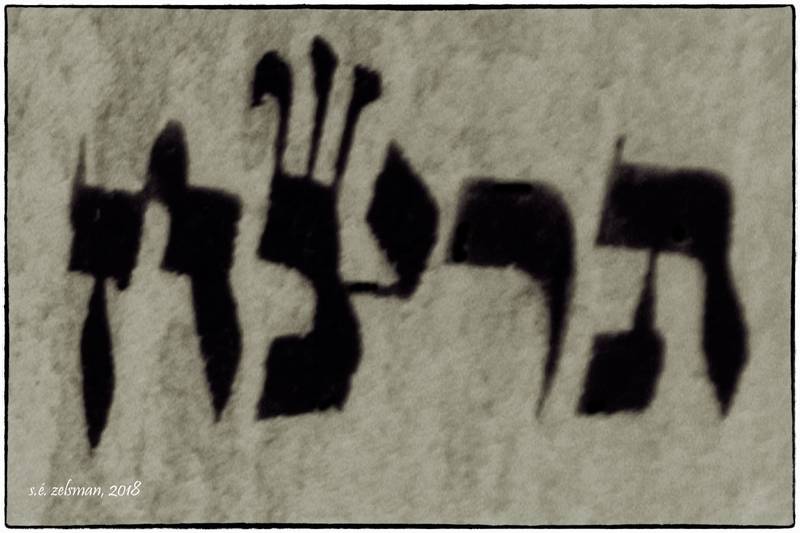
« unique tsadi »
In the photograph above, the word tirtzach is pictured. The word is found in Exodus 20:13 (Yitro). Here, Hashem reveals His Ten Commandments to Moshe where this is the sixth commandment—Thou shalt not kill. Notice the letter tsadi. Can you determine how it was written? Can you see what is unusual?
The ktav (script) of Torah has been standardized and there is a myriad of Halachic laws that apply to the ktav. Did you know that there are at least four different types of ktav? You have the Ashkenazi Beit Yosef ktav, the Ashekenazi Ari Zal ktav, the Sefardic (Vellish) ktav and the Chabad ktav. The first three are common to specific geographical areas of Jewish communities. In previous articles, we have noted that our Czech Torah is prodimently Ashkenazi but has influences from Sephardic ktav. Examples of nun, lamed and shin were discussed.
But did you know that each letter must be written in a specific way and formed by using two Hebrew letters? The tsadi, for example, must be written by making a letter nun to form the body and a letter yod to form the right side extension. In both Ashkenazi and Sefardic ktav, the nun is usually bent left and the yod is usually turned with the tail angled and the top turned. But here, and throughout our Torah, the nun isn’t bent and the yod has its tail perpendicular (flat) to the body.
Take a look at the photograph below. It is a photograph of the giddim (sinews) that tie one piece of parchment to the other. Again, there are Halachic laws regarding the preparation (spinning) of giddim and the sewing of the klaf (parchment) with them. The knots of the giddim should be on the reverse side. Here, you see a poor quality gid. How this happened remains a mystery.
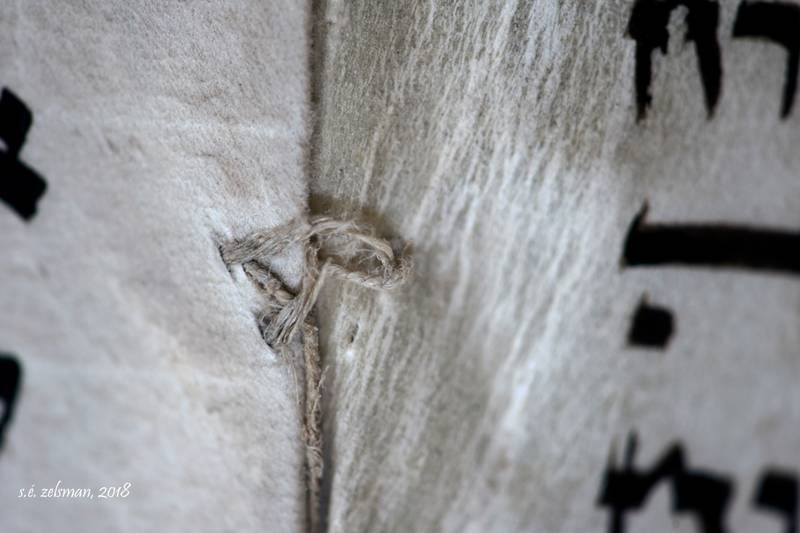
« poor quality giddim »
And now it’s your turn to see what you have learned from the restoration process.
Take a look at the photograph below. There are at least FIVE unusual items and one of them indicates that there was an error. See how many you can find. The answers are not provided!
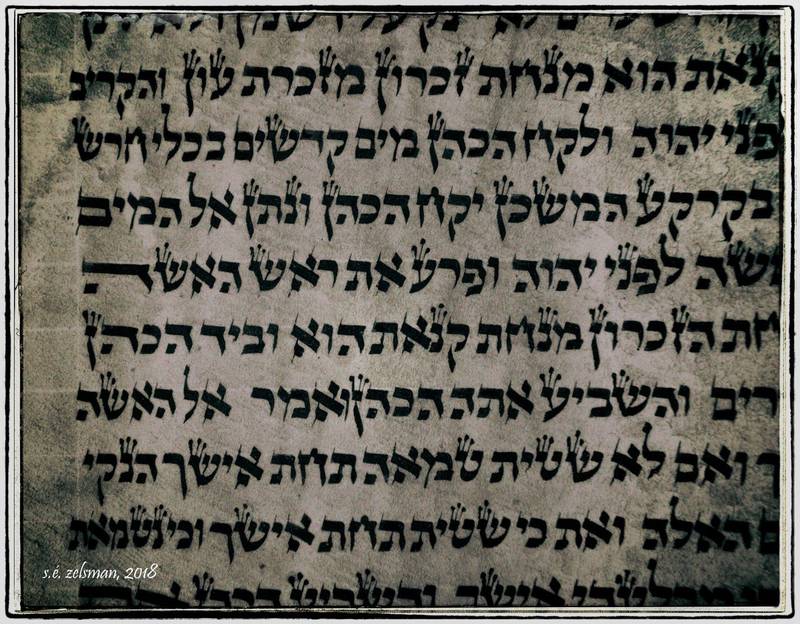
« ??? »
---
This article is the fourteenth in a series of short photo essays to help our community members see and learn with us. We welcome you in being part of the journey of the Czech Torah Restoration Project at Beth Emeth Bais Yehuda.
Please contact the shul office at 416 633 3838.
October 9, 2018
OUR SIMCHAT TORAH EXHIBIT
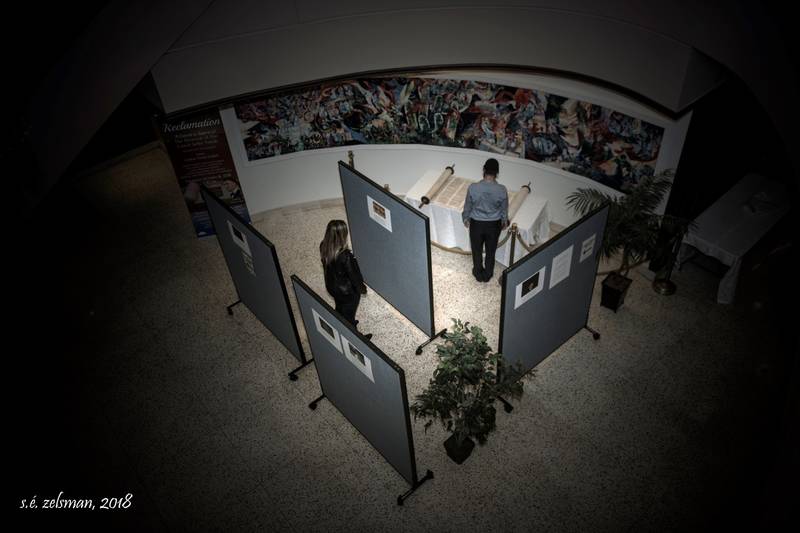
« simchat torah exhibit (1) »
Restoration work of our Czech Torah was stopped during the High Holy Days. However, the Czech Torah Project committee organized a gallery exhibit during Simchat Torah in the shul foyer. The gallery was designed as a walk-through where viewers had an opportunity to see some of the photos from our ongoing articles and read about the distinctive and remarkable story of our beautiful Torah.
In addition, at the end of the walk-through, viewers had an opportunity to see the Torah up close. Seeing the Torah and learning about it in a museum style gallery was the perfect complement to the celebration of Torah during the Simchat Torah Yom Tov.
If you missed the gallery exhibit, the Czech Torah Project committee will be displaying it once more at the AGM on Sunday, October 28.
Donation envelopes for the Czech Torah Project were made available. Please consider making a donation to support the Czech Torah Project. You can call the shul office or go online to make a donation in support of the project.
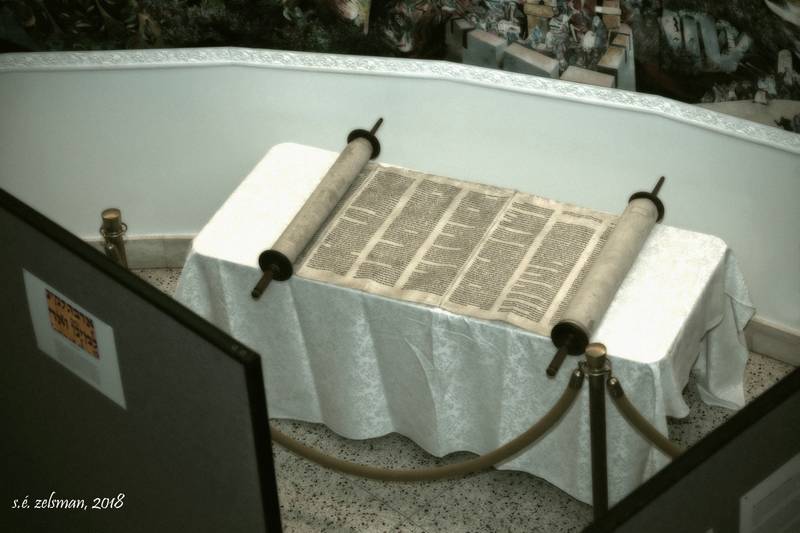
« simchat torah exhibit (2) »
---
This article is the thirteenth in a series of short photo essays to help our community members see and learn with us. We welcome you in being part of the journey of the Czech Torah Restoration Project at Beth Emeth Bais Yehuda. Please contact the shul office at 416 633 3838.
September 26, 2018
שמחת התורה הצ'כית שלנו
The Rejoicing of our Czech Torah
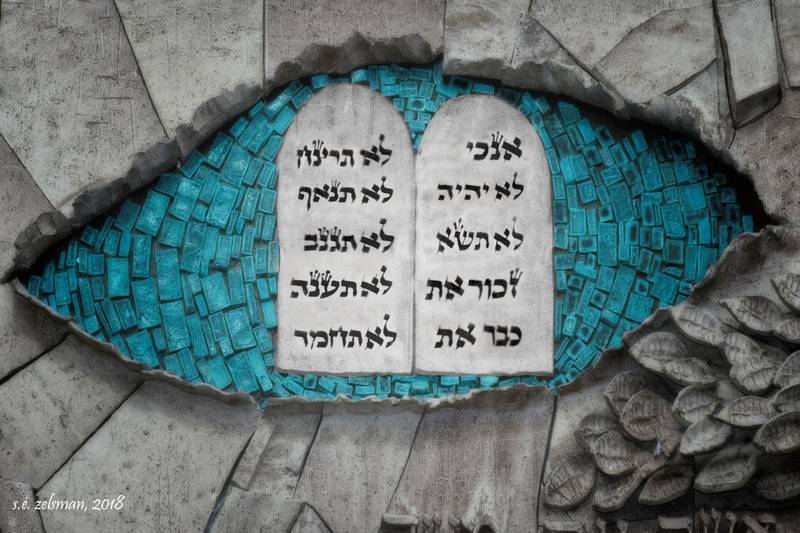
« עשרת הדברות / the ten commandments »
In the above photograph (photo image), you see the first words of each of the Ten Commandments as Hashem first told them to Moses (Exodus 20:1-14 (Yitro)). The words as they appear in our Czech Torah have been superimposed on the two tablets that are in the blue eye of the clay sculpture that is above our Aron Hakodesh in our Main Sanctuary.
During our Rosh Hashanah and Yom Kippur services, Rabbi Morrison spoke eloquently about our Czech Torah. He told us about its own life story: a story of creation over 300 years ago, and a story of survival because of the dedication and determination of the Jewish community of Prague despite facing imminent death at the hands of the Nazis. Rabbi Morrison also told us about its restoration because of the generous gift from Clement Cohen and by the precise and meticulous handiwork of our Magiah (proofreader), Rabbi Zacks. Knowing Hitler’s plans to annihilate our faith, our brothers and sisters and our words of Hashem, the Jewish community of Prague hoped to save these Torah scrolls so that the survivors and future generations of Jews would use them and ensure that our faith remains strong.
By placing the words of the Ten Commandments—the fundamental principles of our faith, from the ktav (script) of our Czech Torah onto the sculpture, we reinforce our devotion to our Czech Torah, our affirmation of the hopes of the Jewish community of Prague, our faith and commitment to Hashem, and our commitment to each other as members of Beth Emeth.
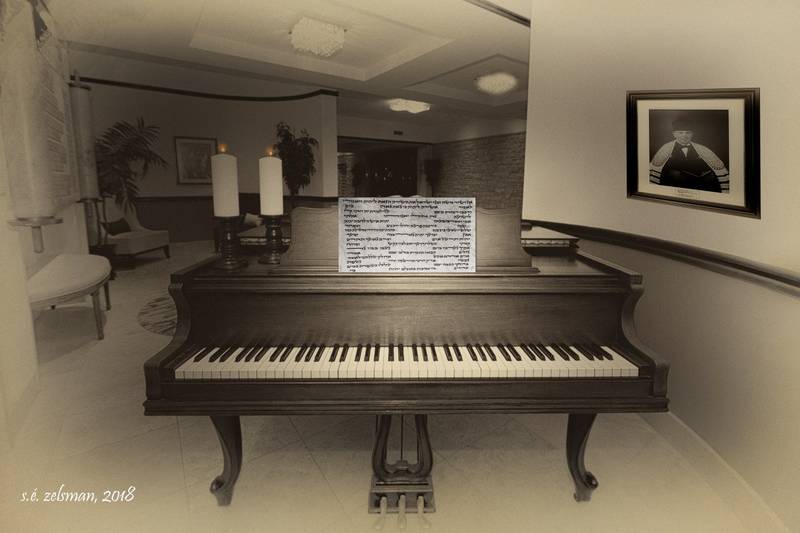
« אז ישיר משה ובני ישראל / the song of moses by the sea »
Cantor Louis Danto’s (זצ"ל) piano, which is located in the alcove across from the Fischtein Hall, is photographed (above) with the fall board open, symbolizing that it is ready to play again. A photograph of our Czech Torah scroll opened at the first psukim (verses) of the Song of Moses By the Sea (Exodus 15:1-19 (Beshalach), is superimposed on the music rack. The painting of Cantor Danto (זצ"ל) hangs on the wall on the right. Two pillar candles are newly lit, and their soft, gentle light glows in full color. Colorizing gives the photograph (photo image) an antique plate look.
By putting this part of our Czech Torah on the piano—as if it were sheet music, we are showing the new life the Torah will have here at Beth Emeth. We will be reminded every day when we recite this song in our Shacharit morning prayers. Hashem sent Moses so that He would bring our people out of bondage and inhuman treatment, and would bring us together as one nation as He had promised Abraham, Isaac and Jacob. Every day we are reminded through this prayer about how nations will rise up and try to destroy us, but together with the help of Hashem and the support of Israel, it will never happen again. The pillar candles indicate the rejuvenation of our Czech Torah and that it lives on with us.
---
This article is the twelfth in a series of short photo essays to help our community members see and learn with us. We welcome you in being part of the journey of the Czech Torah Restoration Project at Beth Emeth Bais Yehuda. Please contact the shul office at 416 633 3838.
September 17, 2018
Love and Praise: From Blessing to Creation
The Cycle Begins Anew
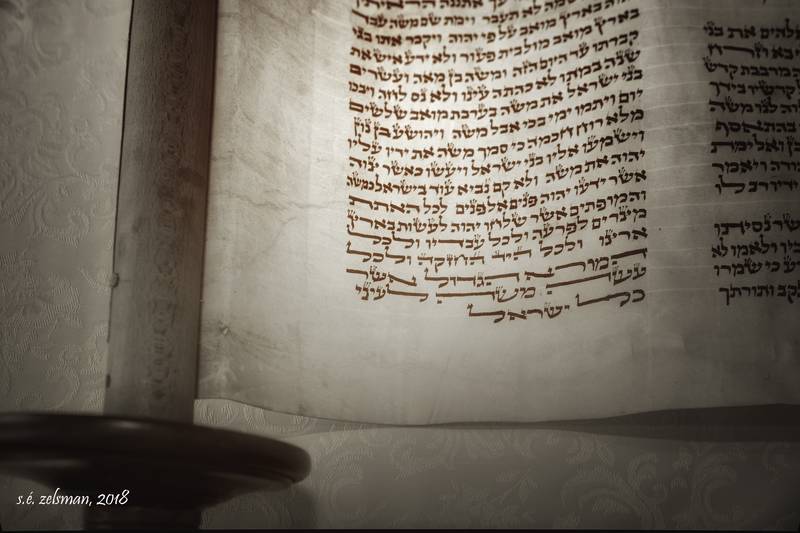
« וְזֹאת הַבְּרָכָה »
On August 7, 2018, our Magiah (proofreader), Rabbi Zacks, reached the last words of the Torah. In this parsha, Moses gives his final words to the tribes of Israel, blessing each of them « according to [their] national responsibilities and individual greatness. » (Parashas Vezos Haberachah. (2011). In Rabbi Nosson Scherman (Ed.) Tanach The Torah/Prophets/Writings: The Twenty-Four Books of the Bible Newly Translated and Annotated (2nd ed, p. 510). Brooklyn, New York: Mesorah Publications. Moses, who: served Hashem with insurmountable devotion, defied an oppressive tyrant, led generations of people through innumerable emotional, spiritual and physical tests and united generations of a people under one faith and one nation, now blesses his people despite the fact that he, himself, will not dwell in the Promised Land according to Hashem’s covenant with Abraham.
Coming to the last words of Torah, we must see the connection to our Czech Torah and the members of the Jewish community of Prague who knew of their looming death at the hands of the Nazis. By cataloguing, sorting and storing thousands of articles of Judaica—including over 1 500 Torah scrolls (from which our Torah came), they were defying the demonical Nazi tyrants, devoting their lives to Hashem and blessing and uniting future generations of Jewish people who would ensure the Torah scrolls are preserved and used. We, at Beth Emeth Bais Yehuda, are honoring the hopes of the Jewish community of Prague by restoring this beautiful Torah scroll in order to read and study the word of Hashem from it.
We, the Czech Torah Project at Beth Emeth Bais Yehuda Committee, hope that all of our shul members will actively support this project. In doing so, we come together as one shul and one Jewish community.
The title of this article is appropriate on several levels. Moses gives his final blessings, his love and his praise to the generation of Jews who will first enter Israel—our Jewish homeland. But it doesn’t end there. laws of Hashem—His Torah, do not stop. cycle of learning, studying and obeying continues as we devote ourselves to our Torah and our obligations to Hashem. And so we return to Creation where Hashem crafts a beautiful world for the people He will create among whom He will choose one nation as his Beloved. Likewise, our restoration has come to one ending, but our Magiah starts again to fully ensure the entire Torah scrolls is kosher. Once our Czech Torah is certified as kosher, it will require regular maintenance like all sifrei Torah.
In this article, we will look at additional distinctive features of our Czech Torah that we have not described in earlier articles.
In the photograph beneath the title, you see the last words of Torah beginning from Deuteronomy 34:5—the last eight psukim (verses): « So Moses, servant of Hashem, died there, in the land of Moab, by the mouth of Hashem. » Take a look also at the photograph below. If you have been following these articles, you might be able to notice something curious. The ktav (script) in the last psukim is different from the ktav of the original Sofer (scribe). For example, you see variations of letters such as lamed, shin and hei—some are written in the Ashkenazi script and some are written in the Sefardi script. Why do you think this is? Notice also tagin (crowns) are written on the letters dalet and hei in some words; these are letters that are no longer supposed to have tagin.
The answer is simple. The last letters of a Torah are often given to a person to write—a person who is important and/or who is receiving a kibbud (honor). This honor could even be for having donated the Torah scroll. Therefore, the original Sofer (scribe), did not write them. A lighthearted irony about this is also relevant. Did you know that there is a dispute about who wrote the last eight psukim of the Torah; that is, Moses, who wrote the Torah as dictated by Hashem did not write them? In the Talmud (Baba Bathra, tractate 15a) it is argued that it was Joshua who had written them. And Joshua is given the kibbud (honor) of leading the Israelites into the Promised Land.
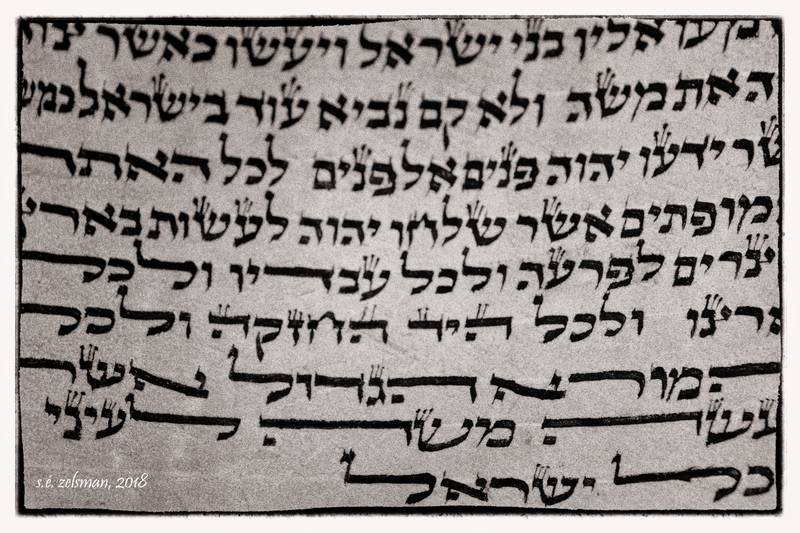
« v’zot habracha: unusual tagin on daled and hei »
The two photographs below show our Czech Torah scroll opened at the beginning—Breishit. In the first photograph, a soft glow filter is used to give effect, but the photograph shows the letters are clear after the initial restoration. Notice the piece of tape along the wooden roller. On April 23, 2018, when our Magiah (proofreader) began the restoration, he noticed heavy scratches in some letters. This was caused by the giddim (sinews) that are used to sew the klaf (parchment) onto the atzei chaim (the wooden rollers (literally, trees of life)). As the Torah was continuously open and closed over centuries, the giddim were pressing along the letters and rubbing them out. He put tape over the giddim to protect the letters.
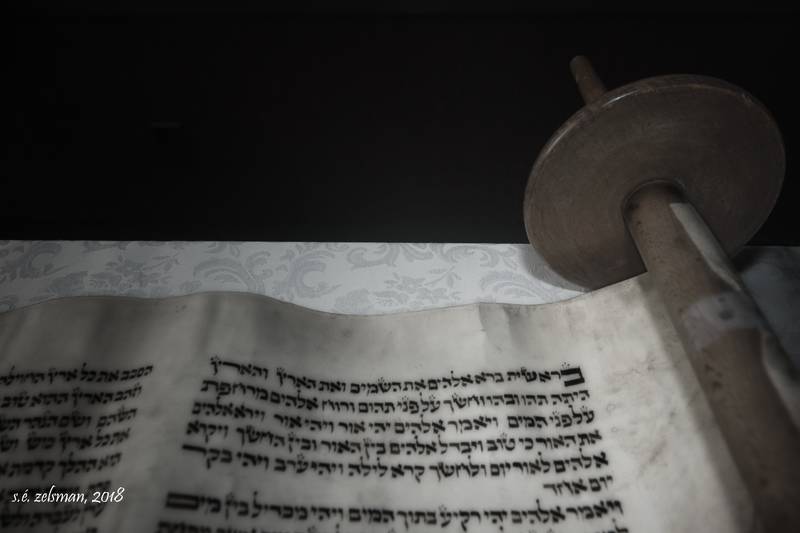
« a new beginning (1) »
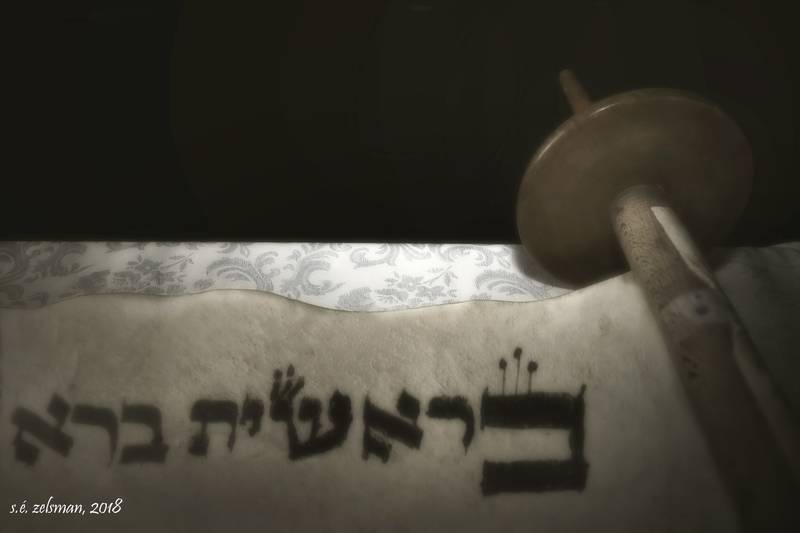
« a new beginning (2) »
In the photograph (photo image) above, the first two words of Torah are enlarged artistically. The purpose is to show the letter beit that has tagin (crowns). Beit is not a letter that is now permitted to have tagin. The photograph below enlarges the letter beit with its tagin.
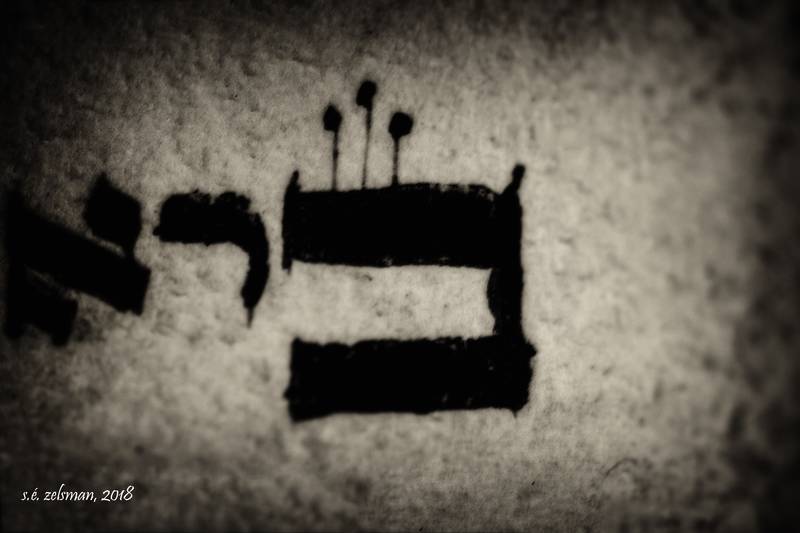
« the first letter »
In the photograph below, you see the singular style in our Czech Torah—the pei lefufa (flipped). This style appears frequently in our Torah, but the reasons for its use are now lost. You see a flipped letter pei inside the letter. Here, our Magiah had to scrape out the original letter because the flipped letter was touching the outer letter, rendering the Torah pasul (invalid). Since this is a style that has fallen into disuse hundreds of years ago, you can imagine the challenge for our Magiah who has to create it for this Torah. You can see in this photograph that our Magiah has mastered a skill that is long gone.
Notice the reddish-brown color of the letters in the photograph. This coloring arises from oxidation of the old ink. In the over 4 000 rules regarding Torah writing and repair, this is halachically acceptable. In order to preserve the true character of our Czech Torah, our Magiah is leaving these letters as they are.
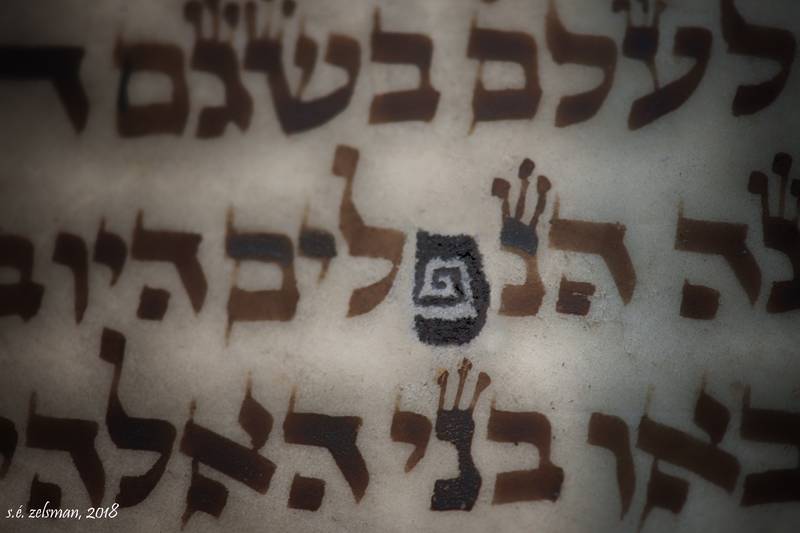
« pei lefufa »
The letter is found in Genesis 6:4 (Breishit): « The Nephilim were on the earth in those days—and also afterward when the sons of the rulers would consort with the daughters of man, who would bear to them. » The word in which the letter is found is bolded and underscored. The Nephilim are referred to in Numbers 13:33 as the giants by the spies sent out to scout the land.
In the photograph below, look at the unusual tagin and hook on the final letter nun. This style has not been seen throughout our Torah save here. It is found in Genesis 6:3 (Breishit): « And Hashem said, “My spirit shall not contend evermore concerning Man since he is but flesh; his days shall be a hundred and twenty years. » The word in which the letter is found is bolded and underscored.
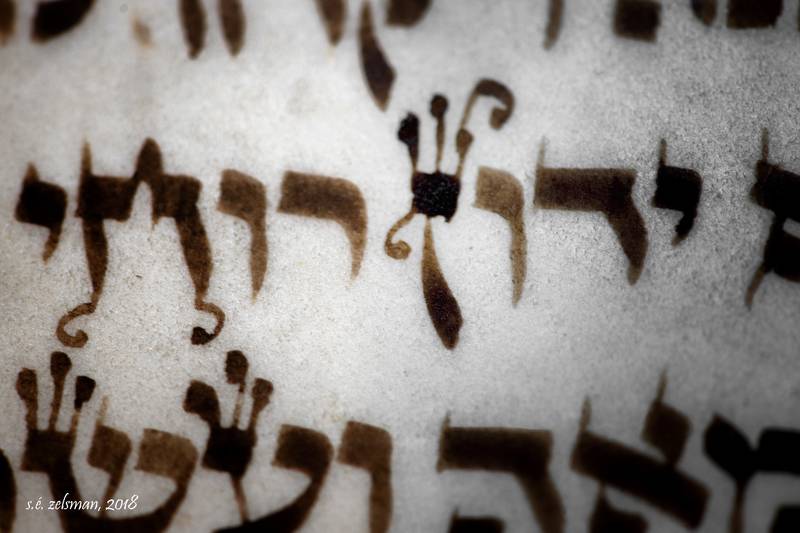
« unusual final nun »
In the photograph below, we see a letter vav with a distinctive hook, rarely seen in our Czech Torah scroll. We no longer have the understanding of why this style was used as it has fallen into disuse and no longer accepted halachically. The word is found in Genesis 14:24 (Lech Lecha): « Far from me! Only what the young men have eaten, and the share of the men who accompanied me: Aner, Eschol, and Mamre—they will take their portion. » The word in which the letter is found is bolded and underscored. This pasuk (verse) describe the honors from the King of Sodom that Abraham shuns.
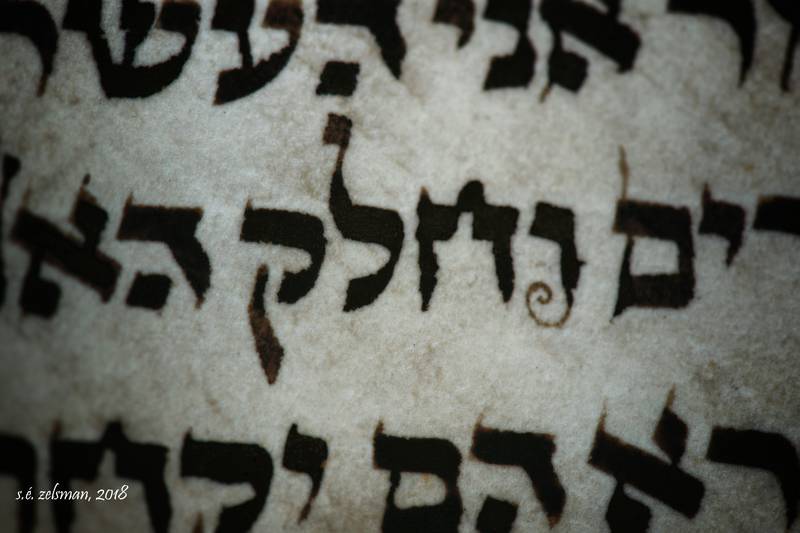
« vav with hook »
In the photograph below, we see further examples of rare stylistics in ktav (script) witing. In the word that is prominent in the bottom right corner, you see two letter reish with two different types of tagin (crowns). Reish is not a letter that had a tag usually, and by current practices, cannot have one. Notice too the flourish on top of the right tag on the letter zayin in the word above, as well as two flourishes below the letter nun in the center word. The words are found in the Genesis 5:30 (Breishit): « And he called his name Noach, saying, “This one will bring us rest from our work and from the toil of our hands, from the ground which Hashem had cursed.” » The words in which the letters are found is bolded and underscored.
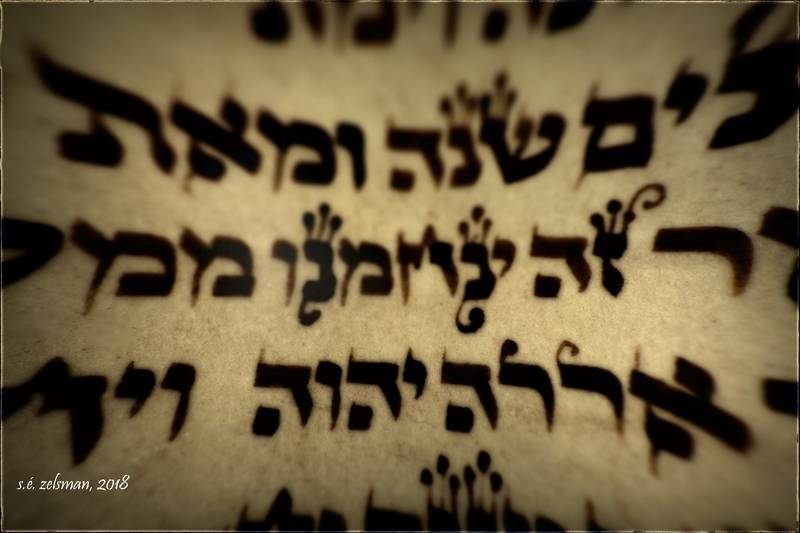
« reish with tagin »
In this pasuk (verse), Lamech, Noah’s father, speaks after Noah is born. Perhaps the zayin has the flourish for emphasis; after all, Hashem saw Noah as a righteous man—a statement we make daily in a short prayer when we exit a synagogue. Perhaps the two letters nun have the flourishes because the name of Noah comes from this word and Noah will come to be a very important man. And perhaps the two letters reish have different flourishes to symbolize the many curses Hashem brought upon doers of evil.
There are remarkable conjectures—one which uses gematria to provide an interpretation for the flourishes on these specific letters נ, ז, ר. The Hebrew word « נזר » is the root of the verb « להנזיר » which means to cloister or to seclude oneself. While this commonly refers to the Nazirite—the person who voluntarily took specific vows, did not Noah cloister himself (as instructed by Hashem), together with his family and the male and female pairs of all creatures in an ark, away from the evil in the world that Hashem was going to destroy? The gematria of the root word adds up to 257 ( נ = 50, ז = 7 and ר =200). Another word for scribe is « חרטם » whose letters add up to 257 (ח = 8, ר = 200, ט = 9 and מ = 40). It was the original Sofer / Chartam that chose these specific letters to add unique tagin and flourishes. Finally, the Hebrew word for quarrel or strife, « מריבה » also adds up to 257 (מ = 40, ר = 200, י = 10, ב = 2, ה = 5). This word is the name given to the place where the Israelites quarreled with Moses about the lack of water in Shemot and refers to Numbers 20:1-13 where the Israelites again complain about water and crops. Could the Sofer have had this in mind when putting the flourishes on these letters? After all, in this story, Hashem struggles with mankind as a whole and certainly brings waters of strife to flood the land and rid the land of humanity and its evils.
In the photograph below, we find a very rare appearance of the letter samech with tagin (crowns). Samech is not a letter that can have tagin under current practices. It is found in Genesis 2:14 (Breishit) during the creation of the Garden of Eden: « The name of the second river is Gihon, the one that encircles the whole land of Cush. » The word in which the letter is found is bolded and underscored.
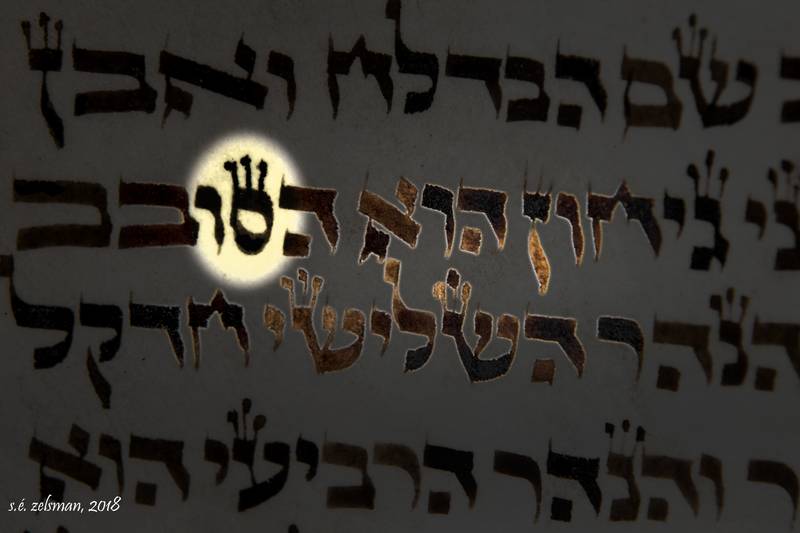
« samech with tagin »
Stay tuned for the next article which will feature two photographs paying homage to two very special sections of Torah, to the eloquent ktav (script) of our Czech Torah, and to the memory of the Jewish Community of Prague who were devoted to preserving our faith by rescuing over 1 500 precious Torah scrolls at their own risk from the Nazi murderers.
---
This article is the eleventh in a series of short photo essays to help our community members see and learn with us. We welcome you in being part of the journey of the Czech Torah Restoration Project at Beth Emeth Bais Yehuda. Please contact the shul office at 416 633 3838.
Further Discoveries in our
Beautiful Czech Torah
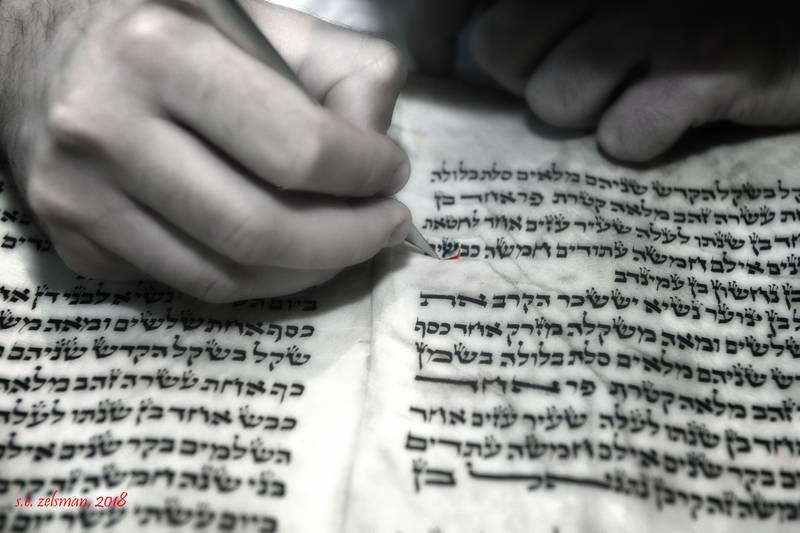
« making a patch »
Given the age of our Czech Torah, it is understandable that there would be significant repairs throughout its life. As we have learned, it was sometimes necessary to use abrasive techniques to make repairs which included sandpapering and scraping. Unfortunately, these techniques are harsh and damage the klaf (parchment) to the point where a tear or hole can occur. In the photograph above, we can see that our Magiah (proofreader) had to make a correction to the letter sin (Numbers 7: 17, Nasso). Because the klaf was very thin at that spot, the only thing he could do was to cut the letter out and make a patch.
As we have learned before, there are strict halachic rules regarding making a patch in a Torah. The patch must be made of klaf and there has to be klaf surrounding the letter. In the photograph, you can see the Magiah using a scalpel and carefully cutting the letter out. He placed a plastic card underneath (the orange color of the card is visible) in order to guide the cutting. The piece that is removed is brought to the genizah for proper burial.
In the next two photographs, you see an old repair that was made to our Czech Torah. It was poorly done and you see the steps our Magiah took to make the proper repair.
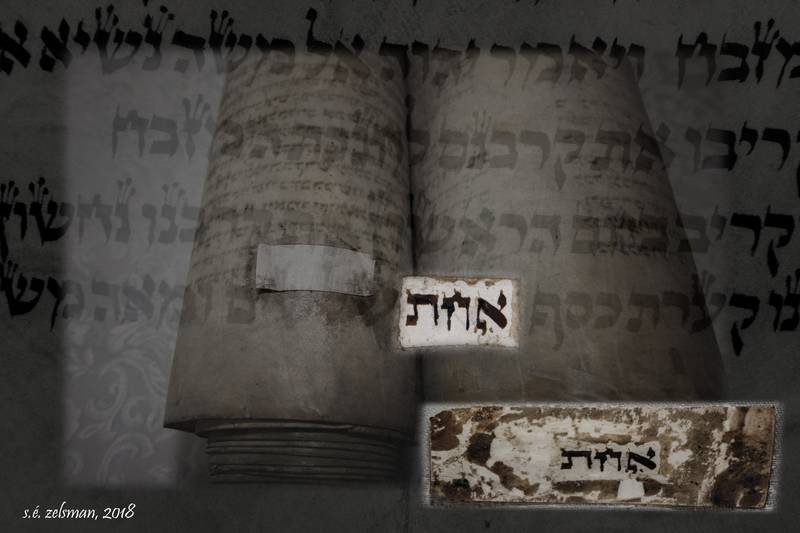
« old, poor quality patch »
In the photograph above, we see that a whole word had been repaired. A previous Magiah or Sofer (scribe) had cut the word out and wrote it on a patch. The problem was that the klaf (parchment) used for the patch didn’t match the klaf of the Czech Torah and it was coming loose from the Torah scroll. The word on the patch, which is found in Numbers 7:13 (Nasso), is emphasized in the photograph by ghosting all the words around it and darkening them. The part of the amud (column) is superimposed on the reverse side of the Torah where you can also see the patch coming loose. When the patch was removed (superimposed image in the bottom right corner), you see that the person who made the repair used an unnecessarily large piece of parchment.
The photograph below shows the careful steps our Magiah took to make the repair and approximate the original appearance of the word. Beginning at the top left, we see the old patch removed from the klaf. It was easy to peel off because it was so loose. The photograph in the top row, middle, shows the Magiah marking a spot on the reverse side of the klaf found at the very end of our Torah, on the roller. Our Magiah explains that if there is enough parchment beyond the words of Torah itself, it is permissible to remove a piece. In this way, there will be minimal variation in texture and color. By making a small dot on the reverse side of the klaf, he will know the correct side to write the word. At the top right, we see the Magiah using the scalpel to remove a small piece of klaf.
Continuing from the bottom left, we see the Magiah patting down the new parchment which he glued in place. In the bottom right corner, we see the patch now securely in place on the side where the missing word will be written. You can see that the color of the patch is very close to the color of the surrounding klaf. Looking at the middle of the photograph, you now see the word rewritten, to match the style of the ktav (script).
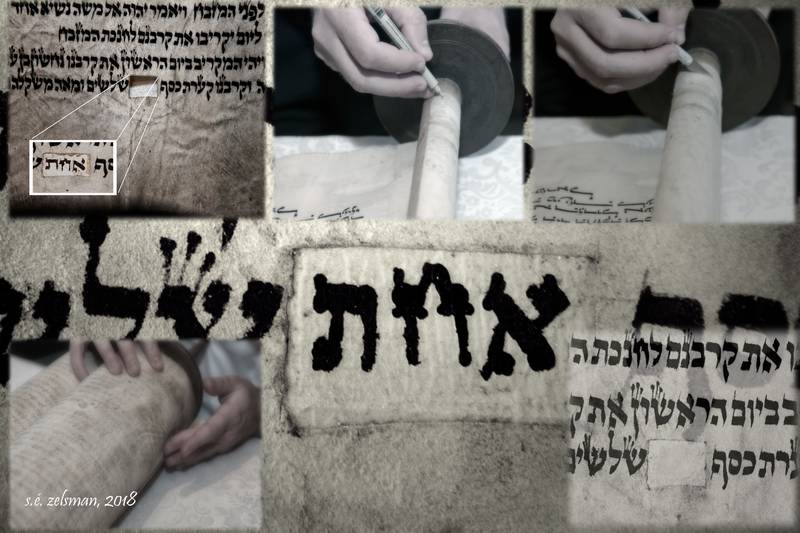
« repairing an old, poor quality patch »
In the photograph below, you see that there was a major repair done a long time ago where an earlier Magiah or Sofer used a large patch on which he wrote the three words. This patch is found in Exodus 8:24-25, (Vaera) where Pharaoh says he will allow Moses and the Israelites to bring offerings to Hashem, as long as they don’t go far off. The colors in the photograph have been altered to enhance the appearance.
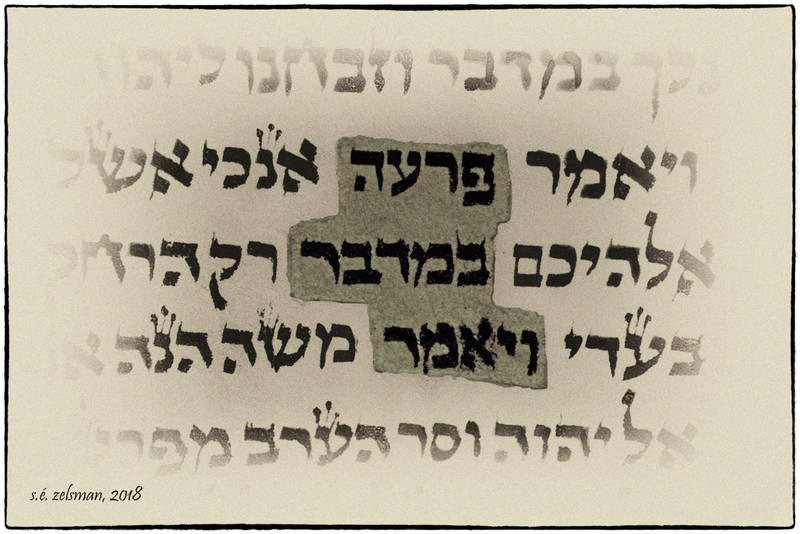
« large patch »
In the photograph below, you can see that an entire line was removed and rewritten on a large patch. The verse is from Exodus 39:1 (Pekudei) describing Aaron’s vestments as Hashem commanded.
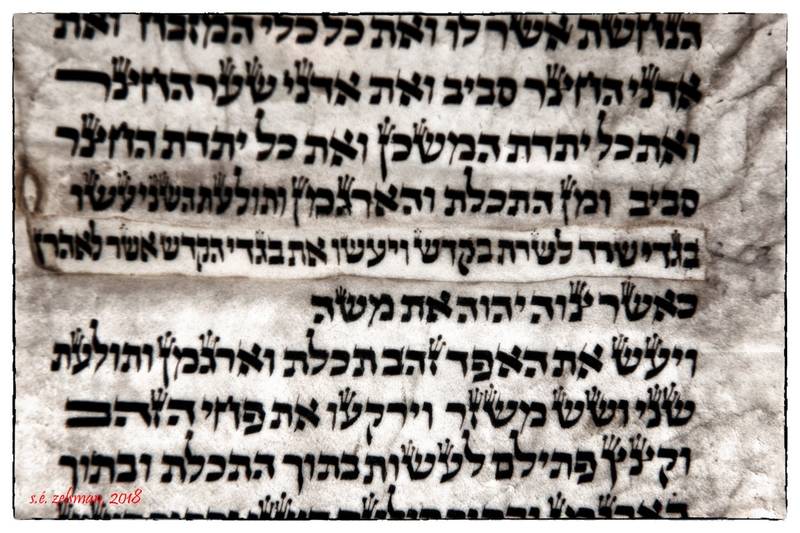
« whole line patch »
As mentioned before, when repairs are made by sandpapering or scraping, for example, they wear the klaf (parchment) out. Sometimes, when the new ink is applied, it can bleed through the klaf, and becomes visible on the reverse side. You can see an example in the photograph below in each of the four panels.
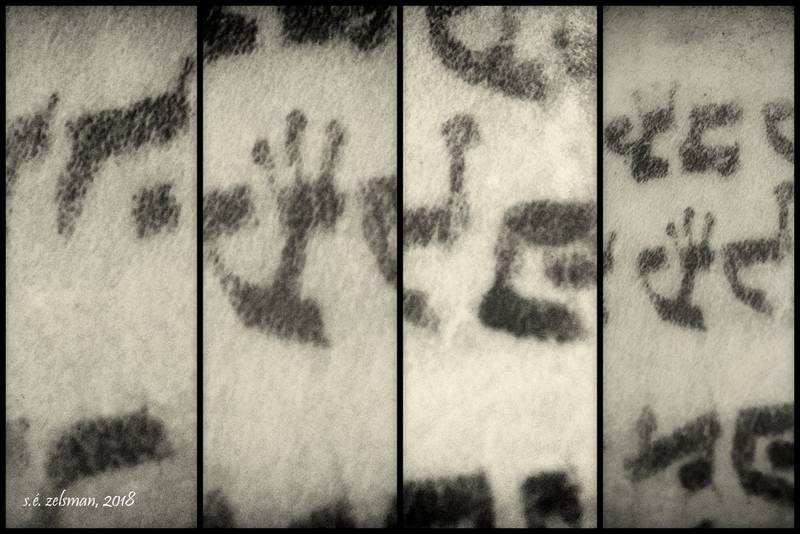
« bleeding through on the back side of the klaf »
Now, we come to three photographs that show where the original Sofer (scribe) was careless.
Take a look at the photograph below. What do you notice is unusual? What do you think happened?
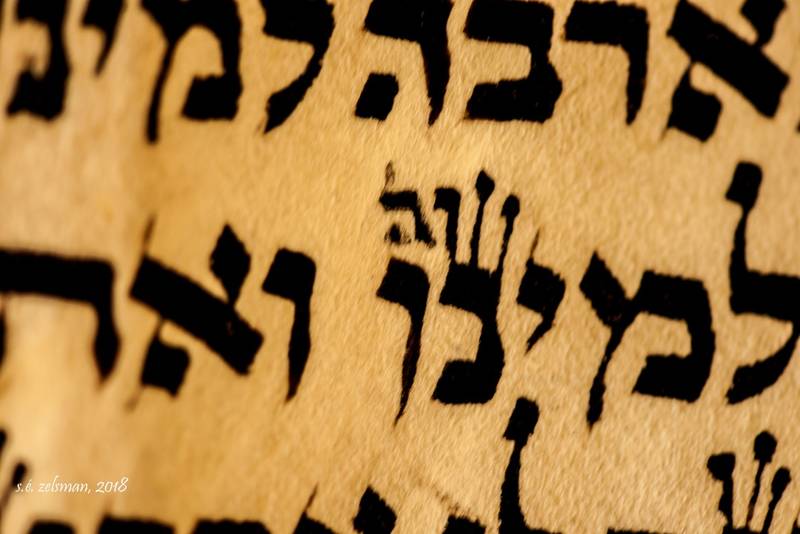
« forgotten letter »
The word you see in the photograph is למינהו which, in the context of the pasuk (verse), means, « according to its kind. » This photograph shows a very rare occurrence where the Sofer (scribe) forgot a letter in a word. Here, the letter hey was forgotten, and to correct the error, the Sofer superscripted it above the vav and beside the nun because it was supposed to have been written between them. Our Magiah (proofreader) explains that this was done because it would not have been possible to erase the word and put in the missing letter hey. The word would not have fit properly in the space. To try to fit the word into the space would have forced the Sofer to shrink the word and it would have been very awkward looking. The term used for the superscripted hey is תולה (hanging). Halachically, this is permissible.
But why do you think the Sofer made the error? How could he have forgotten a letter? To help you figure this out, take a look at the same photograph below with superimposed text. The error is visible, but there are two other words that provide you with a clue. A possible answer follows the photograph.
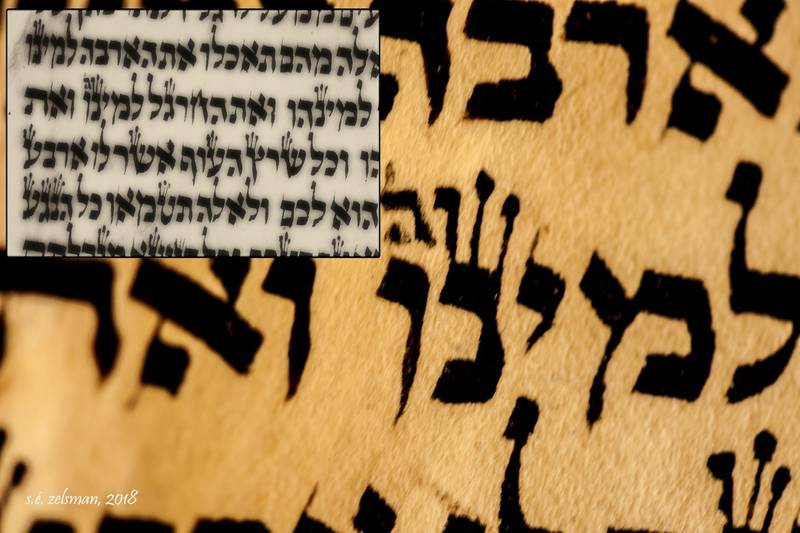
« forgotten letter (how it happened) »
The superimposed text is from Leviticus 11:22 (Shemini):
את אלה מהם תאכלו את הארבה למינו את הסלעם למנהו ואת החרגל למינהו ואת
החגב למינהו
You may eat these from among them: the arbeh according to its kind, the chargol according to its kind, and the chagav according to its kind.
The word in Hebrew that was written incorrectly with the missing hey is bolded and underscored. In the English translation, the incorrect word is bolded, underscored and in italics.
In this pasuk (verse), there are two forms of the Hebrew word that means to its kind—lemino and leminehu. Both forms are the masculine singular forms. We even see both forms used earlier in Genesis 1:11-12:
ויאמר [אלקים] תדשא הארץ דשא עשב מזריע זרע עץ פּרי עשה פּרי למינו אשר זרעו בו על הארץ ויהי-כן. ותוצא הארץ דשא עשב מזריע זרע למינהו ועץ עשה-פּרי אשר זרעו-בו למינהו וירא [אלקים] כי-טוב
(G-d said, “Let the earth sprout vegetation: herbage yielding seed, fruit trees yielding fruit each after its kind, containing its own seed on the earth.” And it was so. And the earth brought forth vegetation: herbage yielding seed after its kind, and trees yielding fruit, each containing its seed after its kind. And G-d saw it was good.)
The leminehu form is also seen in Genesis 1:25:
ויעש [אלקים] את-חית הארץ למינה ואת-הבהמה למינה ואת כל-רמש האדמה למינהו וירא [אלקים] כי-טוב
(G-d made the beast of the earth according to its kind, and the animal according to its kind, and every creeping being of the ground according to its kind. And G-d saw that it was good.) In this pasuk, you also see the feminine form למינה.)
According to Victor P. Hamilton, Professor of Old Testament and Theology at Asbury University (1971-2007), both masculine forms are used; however, lemino is more of an anomalous use (Hamilton, Victor P. (1990). The Book of Genesis, Chapters 1 – 17. Retrieved from https://books.google.ca/books?id=WW31E9Zt5
Notice that while both forms are used, lemino appears first. So, perhaps the original Sofer (scribe) lost his train of thought while scribing—which one must never do when writing a sefer Torah. He probably had that form in mind when he came to the word again; not realizing that the other form should have been used. Rabbi Zachs, our Magiah (proofreader), explains that a Sofer has to copy the letters word by word from a Torah scroll that is kosher certified. A Sofer must never rely on his memory.
Now take a look at the photograph below. It is split in half with the left side using an embossed feature on key words; the right side shows the same verses, but enlarged. What do you notice is happening?
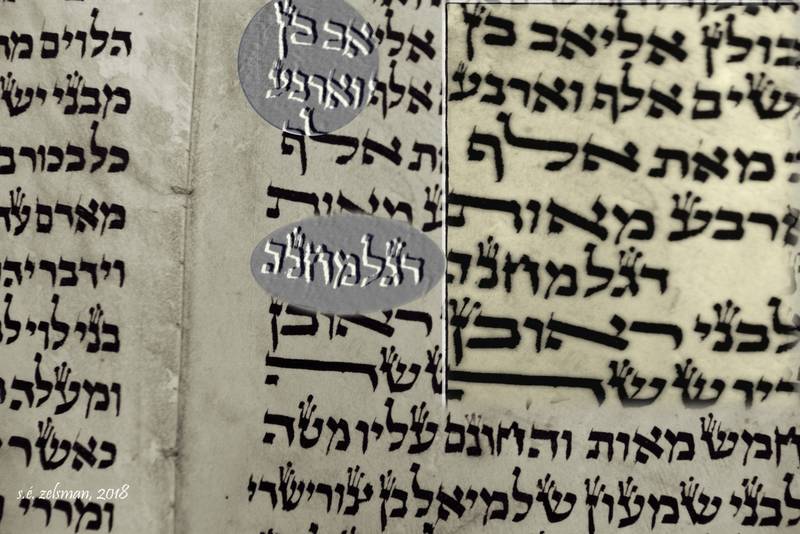
« slanted letters »
In this portion of the amud (column), we see that the words at the end of the line are sloping upwards when they should be written evenly. This is surprising because grid lines (sirta) are used to help guide the writing.
In the next three photographs, we see unique styles in the writing of our Czech Torah.
Below, you see the puncta extraordinaria (extraordinary points)—the dots that have been put above certain words. In article 7, we saw an example of these nekudot, as they are called in Hebrew; however, those had unusual flourishes to them. Here, they are simple in design. These nekudot are found in Deuteronomy 29:29, Nitzavim.
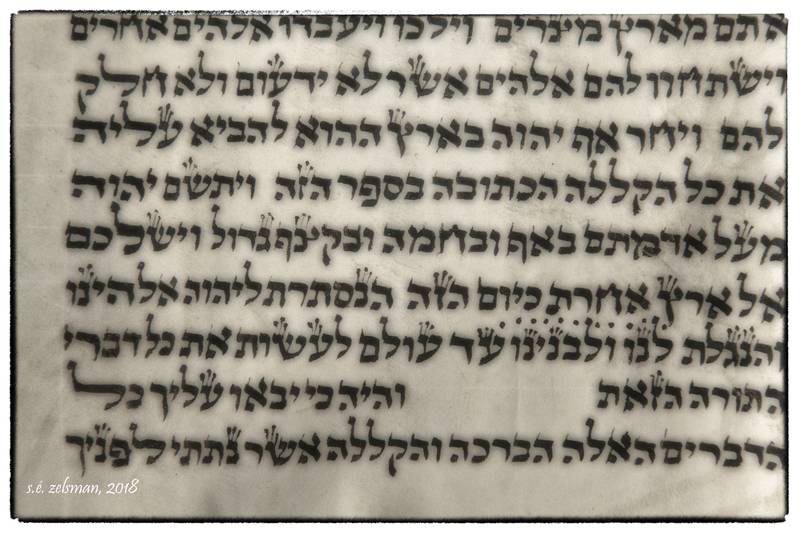
« puncta extraordinaria »
In the photograph below, you see that the Sofer (scribe) wrote the letter kuf very large and very thick in this pasuk (verse). The reason for this has been lost. The verse is found in Deuteronomy 22:10, Ki Teitzei.
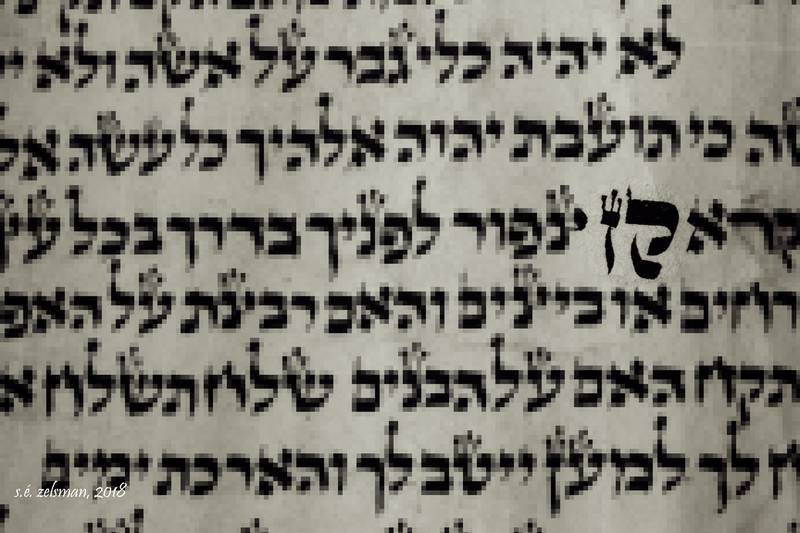
« thickened letter kuf »
In the photograph below, we can see a variation of the spelling of the Hebrew word « דכא. » In our Czech Torah, it is spelled with an aleph at the end. The word is often found with a letter hey at the end. An explanation that has been given for this is that « Ashkenazim write דכהwith an א. » (Mikraot Gedolot, Sefer Dvarim (vol. 5). (1969). New York, NY: Shilo) The pasuk (verse) is found in Deuteronomy 23:2 (Ki Teitzei) which states, « A man with crushed testicles or a severed organ shall not enter the congregation of Hashem. » The word in the pasuk that is bolded and underscored is the word with the orthographic variation.
In our shul, the Stone Edition Chumash that we use in the Lerman Chapel and the blue Chamisha Chumshai Torah that we use in the Main Sanctuary print the word with a letter hey, whereas the Eitz Chaim Edition prints the word with a letter aleph.
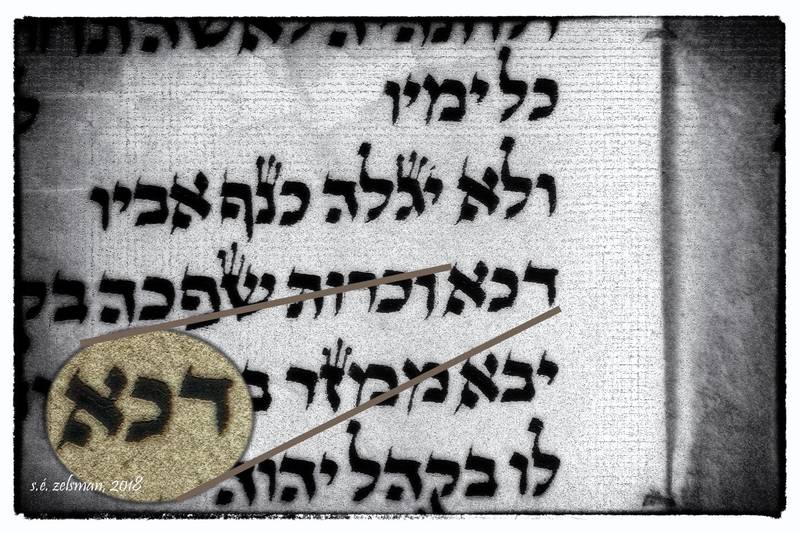
« orthographic variation »
The next three photographs show the beautiful ktav (script) of our Czech Torah in selected passages from which we derive our prayers and practices—two of many aspects which define our Jewish living. Try to commit them to memory and when you daven; think of them and visualize them as you say the words in your prayers. By doing this, you will be bringing our Czech Torah back to life, which the members of the Jewish Community of Prague, who risked their lives to safeguard this Torah under Nazi occupation, had hoped.
Sefirat Ha’omer (Leviticus 23:15, Emor)
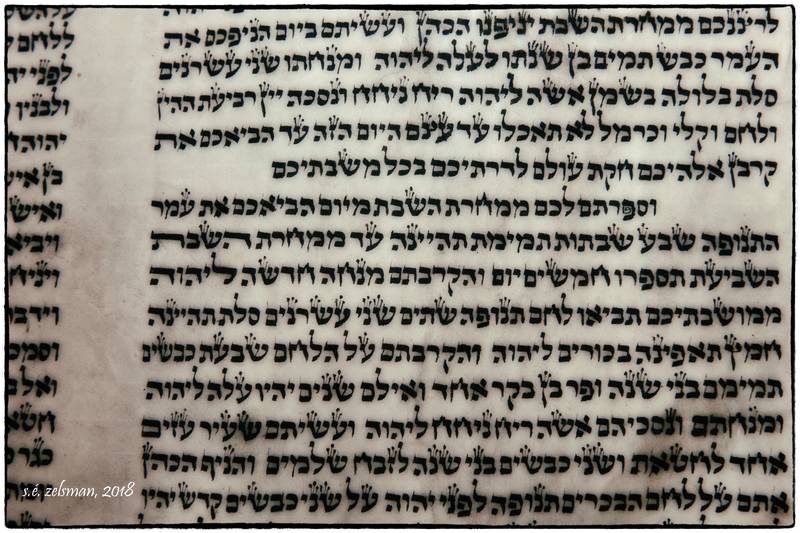
« sefirat ha’omer »
Birkat Ha’Kohanim (Numbers 6:24 – 27, Nasso)
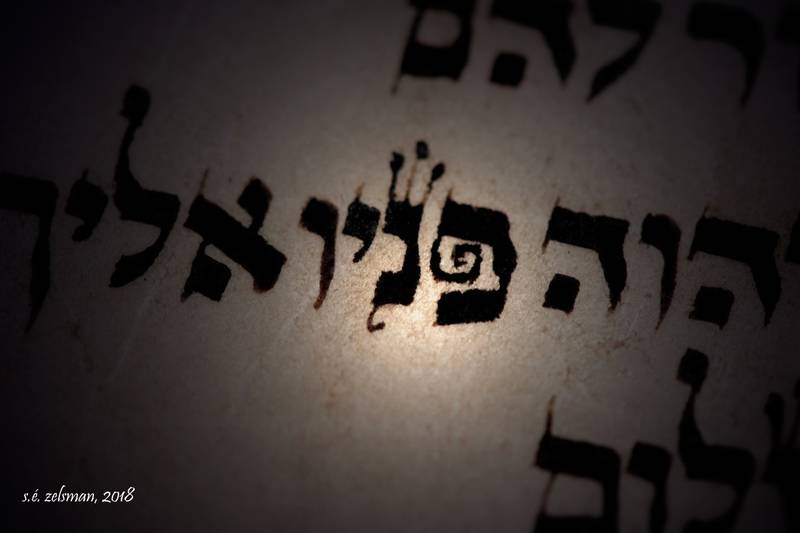
« birkat ha’kohanim »
The Shema (Deuteronomy, 6:4-9, Va’etchanan)
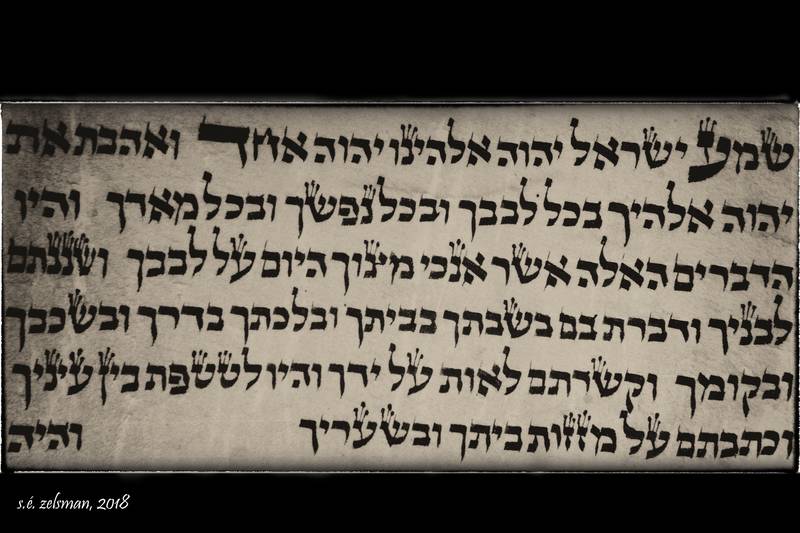
« Shema Yisrael »
----
This article is the tenth in a series of short photo essays to help our community members see and learn with us. In the next article, we will continue to look at more nuances of our Torah that were discovered during the restoration as our Magiah completes the first phase of the restoration and starts the process again to ensure our Torah is kosher. We welcome you in being part of the journey of the Czech Torah Restoration Project at Beth Emeth Bais Yehuda. Please contact the shul office at 416 633 38 38.
August 16, 2018
Yizkor: the Children of
Theresienstadt
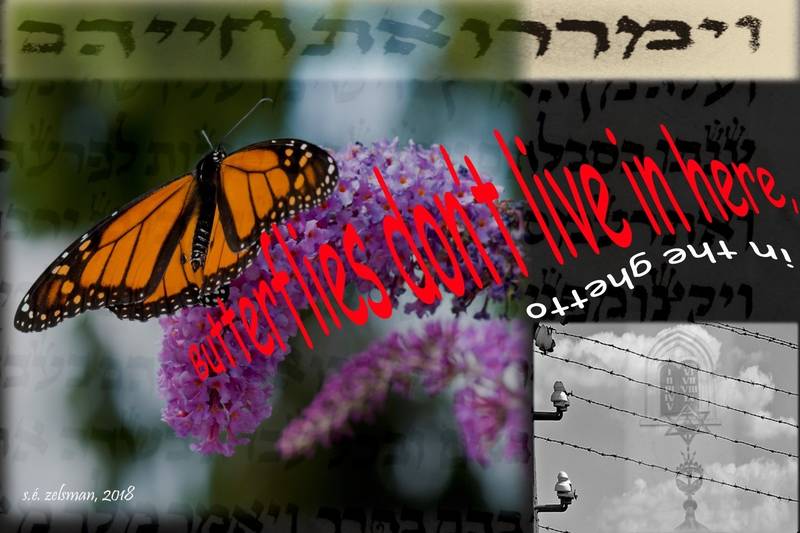
« the children of theresienstadt »
In the last article, we explored a chronology of anti-Semitic and anti-Israel practices which began with the first recorded incident in Ancient Egypt where Pharaoh enslaved the Hebrews. We noted carefully how the Torah describes the cycle of oppression through specific psukim (verses), where oppressors first ignore and misrepresent the truth in order to incite hatred against the minorities, then control the minorities by enacting laws to remove their rights and freedoms, and finally, inflict suffering, hardships and violence in order to marginalize minorities even further.
In this article, with just one photograph (photo image), we focus on the child victims of the Holocaust—the children in the Theresienstadt Ghetto in Nazi-occupied Czechoslovakia. The purpose of this article is four-fold. First, it is to remember the child victims of the Theresienstadt Ghetto who were murdered by the Nazis so that by remembering them, we ease the silence forced upon them and, in some way, give meaning to the suffering they endured. Second, it is to remind us our Czech Torah was created over three hundred years ago in a vibrant Jewish community that dates back to the twelfth century, at least. Third, the restoration of our Czech Torah honors the Jewish community of Prague who catalogued and stored over fifteen hundred Torah scrolls to preserve them from Nazi destruction whose hope was that they would be used again after the defeat of the Nazis. And fourth, it is to remind us of our Judaism, our Jewish community and our Jewish homeland, Israel, so that we support our faith, support each other, and support Israel.
Theresienstadt is the German name for the Czech town of Terezín. Terezín is a small fortress town in northern Bohemia, some 70 km northwest of Prague. It traces its origins to 1780 when Habsburg Emperor Joseph II built the garrison town in order to protect his empire from rival Prussians. He named it after his mother, Empress Maria Teresa. The website for the Town of Terezín describes the unique attributes of the fortress:
The Fortress of Terezín was founded in 1780 by Emperor Joseph II in order to defend the Czech borders against attacks from the north. It represents the pinnacle of bastion fortification architecture in Europe. An intricate triple ring of massive ramparts allowed the defenders to cover the entire foreground with crossfire, attackers had nowhere to hide. The still functioning water defense system not only allowed to flood the extensive basins surrounding the fortress, but also to create an artificial flood wave, destroying every enemy in its path. In addition, several dozen kilometers of underground mine tunnels zigzag beneath the fortifications of Terezín. These enabled blowing up the advancing attacker with underground explosions. All this can still be found in the fortress today. (Terezín, Official Tourist Portal of the Town, The Fortress of TEREZĺN, para. 1. Retrieved July 24, 2018 from http://www.terezin.cz/en/vismo/zobraz_dok.asp?id_org=200295&id_ktg=1001&n=visit%2Dus )
In the 19th and 20th centuries, a penitentiary was established in the fortress. In fact, during World War I, the assassin of Archduke Franz Ferdinand and his wife, Sophie of the Austro-Hungarian Empire, Gavrilo Princip, was imprisoned there until his death. (Holocaust Education and Archive Research Team, Other Camps, Terezin / Theresienstadt. Retrieved July 29, 2018 from http://www.holocaustresearchproject.org/othercamps/terezin.html )
On September 29, 1938, British Prime Minister Neville Chamberlain and French Prime Minister Edouard Daladier signed the Munich Pact with Hitler. Hitler had demanded the cessation of the Sudetenland (areas of Czechoslovakia that were inhabited primarily by Germans from the time of the Austrian Empire). Foolishly believing that appeasing Hitler would avert war, they signed the pact with Hitler. The next day, Hitler annexed the entire Sudetenland. The Czechoslovak government, realizing that it would have no world support, eventually submitted to the Nazis, who seized control over the entire country in March 1939. (History, This Day in History, Sep 30, 1938 Munich Pact Signed para. 1-4. Retrieved July 24, 2018 from https://www.history.com/this-day-in-history/munich-pact-signed )
On November 24, 1941, the Nazis established the Theresienstadt Ghetto—a concentration camp for Jews at the fortress, because of its attributes. At first, the Jews who were transported there came from Bohemia and Moravia [where our Czech Torah originates]; later, Jews were transported from Austria, the Netherlands, Denmark and Hungary. (Website of the Terezín Memorial, For visitors, Exhibitions, Magdeburg Barracks, para. 1. Retrieved July 24, 2018 from https://www.pamatnik-terezin.cz/magdeburg-barracks )
Theresienstadt was designed as a transit camp where Jews were held before being deported to extermination camps.
But one of the most sickening and deplorable events is attributed to Theresienstadt. News was reported throughout the world about the Nazi persecution of Jews. After considerable pressure from the Denmark due to deportation of Danish Jews to Theresienstadt, the Nazis permitted representatives from the Red Cross to visit Theresienstadt in June 1944. The Nazis staged an elaborate hoax by painting houses in the ghetto, renovating barracks, planting gardens, developing fake cultural and entertainment programs, and described Theresienstadt as a spa town where German Jewish senior citizens could retire. (United States Holocaust Memorial Museum, Holocaust Encylopedia, Theresienstadt: Red Cross Visit. Retrieved July 29, 2018 from https://www.ushmm.org/wlc/en/article.php?Mod )
In August 1944, the Nazis ordered SS Obersturmfer Karl Rahm to produce a propaganda film called, Der Fuhrer schenkt den Juden eine Stadt (The Fuhrer Gives the Jews a Town). This film was made under the direction of Kurt Gerron, a famous German-Jewish actor and director who had been deported to Theresienstadt. Gerron was promised that his life would be spared; however, after he completed the film, he was sent to Auschwitz where he was killed. (Jewish Telegraphic Agency, Rare propaganda film showcases Theresienstadt as ‘paradise’ for inmates. Retrieved July 29, 2018 from https://www.jta.org/2011/05/02/arts-entertainment/rare-nazi-propaganda-film-showcases-theresienstadt-as-paradise-for-inmates )
The Holocaust Education and Archive Research Team (2007), records the following aspects of the Red Cross visit and the film:
The tents were taken down and the square was turned into a park, with a music pavilion in front of the café at 18 Neue Gasse. Allotments were created across the moat, impressive gardening work was undertaken, and this was seen by the Red Cross delegation who visited the ghetto on 23 June 1944.
The “Improvement Action” ensured that everything looked just right – a band consisted of inmates played on the bandstand, children dressed in clean clothes, rode on a merry-go-round. The Ghetto Elder Dr. Paul Eppstein, was given a car and a chauffeur.
The Red Cross visitors saw the chauffeur open the door, bow and let him in. The day before, this same chauffeur – an SS- man- had beaten Eppstein without compunction and resumed with this treatment after the visitors had departed.
The Red Cross visitors were not shown the barracks crowded with the old, the sick and the dying – nor were they shown the storerooms filled with the belongings taken from their Jews on their arrival.
A film of Theresienstadt was made in 1944, filming commenced on 16 August and was completed on
11 September, the last commandant of Theresienstadt SS- Obersturmfuhrer Karl Rahm, was ordered by his masters in Berlin, to commission a film called “The Fuhrer Gives the Jews a Town.”
The film does not appear to have been shown during the war, it was made under the direction of
German –Jewish actor and director Kurt Gerron, who had been deported from Westerbork in Holland, after he had fled from Germany, with a documentary film crew from Berlin.
Berlin decreed that only prisoners who looked like Jews could appear in the film – they had to be hook-nosed, dark hair, dark eyed and preferably furtive in manner, this created a problem Theresienstadt was filled with blond, blue-eyed Jews – the woman’s high –jump champion of Czechoslovakia, a Jew was forbidden to participate in the filming of an athletics event – she had blonde hair.
The ghetto’s bank was filmed, as was the Post Office where prisoners received fake packages. On the riverbank, a swimming event was held. The national high-diving champion performed for the cameras. Just out of range were boats filled with armed SS-men, just in case any of the contestants decided to swim to freedom.
For days the cameras whirred, the lights were focused on the stunned prisoners. A meeting of the Jewish Council was moved from a dingy room in the Magdeburg barracks to a bright room in the gymnasium.
Dr. Eppstein addressed his colleagues, but no sound was recorded.
Gerron’s film took on a life of its own – firemen in new uniforms put out a fire, in the gym “The Tales of Hoffmann” was performed. In the VIP barracks a garden party was filmed including Rabbi Baeck, Field Marshal von Sommer, the Mayor of Lyons M. Meyer and several Czech ministers.
When a train bearing Jewish children from Holland arrived Rahm himself was there to welcome them, lifting the youngsters from the wagons, all dutifully recorded.
Then abruptly, the filming ended – the technicians were ordered back to Berlin, Gerron was discharged, band concerts were terminated, dancing was forbidden.
The camp slipped back into its cruel, starved routine – the old and ill died and the same children Rahm was seen welcoming were murdered in the gas chambers of Auschwitz.
Several still photographs made from the film still survive today, one shows Dr Eppstein addressing his colleagues. His faced is strained, his mouth is drawn, his eyes are frowning and a perplexed vertical crease separates his eyebrows. Dr Benjamin Murmelstein his aide and successor, sits by his side, staring gloomily ahead.
Part of the film can be seen online at the following website: https://archive.org/details/TheresienstadtDerFhrerSchenktDenJudenEineStadtFilm
At the Jewish Museum in Prague, there is an exhibition devoted to the lives of the children who were deported to Theresienstadt. In this exhibition, the plight of the children is told through their drawings that they made from 1942 – 1944. Painter, interior and stage designer, and graduate of the Bauhaus, Friedl Dicker-Brandeis organized art classes for the children in the ghetto. For the children, « drawing was seen as a means of self-expression and a way of channeling the imagination and emotions...art classes also functioned as a kind of therapy, in some ways, helping the children to endure the harsh reality of ghetto life. » Just before being transported to Auschwitz, Friedl Dick-Brandeis filled two suitcases of approximately 4 500 drawings from the children and hid them. They were found right after the war and given to the museum. (Jewish Museum in Prague, Explore, Chidren’s Drawings from the Terezín Ghetto, 1942 – 1944. Retrieved July 29, 2018 from https://www.jewishmuseum.cz/en/explore/permanent-collection/children-s-drawings-from-the-terezin-ghetto-1942-1944/ )
Two editions of drawings and poems from the children of Theresienstadt have been published in a book called, ...I never saw another butterfly... which is part of the last line of the third stanza of the poem, The Butterfly. Here is the full text of the poem:
THE BUTTERFLY
The last, the very last,
So richly, brightly, dazzingly yellow.
Perhaps if the sun’s tears would sing
against a white stone. . . .
Such, such a yellow
Is carried lightly ‘way up high
It went away I’m sure because it wished to
kiss the world good-bye.
For seven weeks I’ve lived in here,
Penned up inside this ghetto.
But I have found what I love here.
The dandelions call to me
And the white chestnut branches in the court.
Only I never saw another butterfly.
That butterfly was the last one.
Butterflies don’t live in here,
in the ghetto.
Volavková, Hana. (1993). I Never Saw Another Butterfly: Children’s Drawings and Poems from Terezin Concentration Camp, 1942-1944. Expanded Second Edition with a Foreword by Chaim Potok. New York, NY: Schocken Books.
The poem was written by Pavel Friedmann and dated June 4, 1942. Pavel was twenty-one years old when he wrote this poem. The holocaust.cz data base records that Pavel Israel Firedmann was born on January 7, 1921 in Prague. His parents were Dr Rudolf Arzt and Marie Friedmann (née Suttner). He lived on ulice Dlouhá, 33 in the Staré Město (Old Town) district of Prague before he was transported to Theresiendstadt. The old Jewish Quarter is in this area. He was transported on April 28, 1942 to Theresiendstadt, and then transported to Auschwitz on September 29, 1944 and was murdered that day.
A passport application for Pavel Friedmann, his passport issue approval, probity certificate and passport photo can be found at the database: https://www.holocaust.cz/en/database-of-victims/victim/86904-pavel-friedmann/ .
The probity certificate is a very poignant document to examine. The probity certificate is dated December 21, 1939, some nine months after the Czech capitulation to the Nazis. It appears that the Friedmann family applied to emigrate to Peru in order to escape the Nazis as life for Jews was already deplorable with the worst yet to come. Aneta Plzakova, Digital Collections Curator of the Institut Terezínské iniciativy / Terezin Initiative Institute / Institut Theresienstädter Initiative, explained to us that « the probity certificate is an official document that informs the authorities about the applicant's criminal history and overall reputation. This certificate was often a first step to obtain other important documents such as licences and, as in this case, a visa (for Peru).
Many families tried to escape the Protectorate before and during the WWII period, usually this very first step of obtaining a probity certificate was made, but only a very few families were really able to emigrate. » (A. Plzakova, personal communication, August 20, 2018)
So how does the one photograph (photo image) at the top capture the themes of this article? Take a look at the reproduced image below which identifies 5 symbols for you to analyze and draw your own conclusions. A detailed interpretation of each symbol is found below the image.
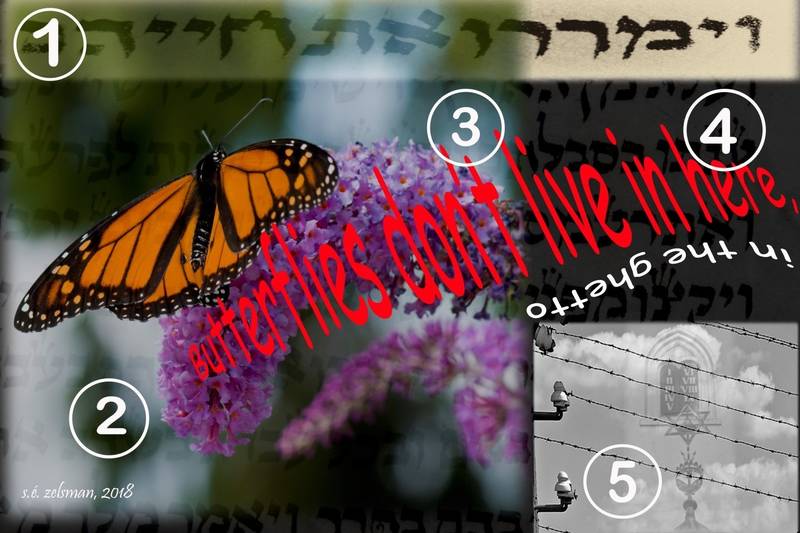
« the children of theresienstadt »
① וימררו את חייהם « And they embittered their lives. » This verse comes from Exodus 1:14. Recall from the last article how this verse describes countless centuries of hatred towards our people and the deliberate actions plotted and carried out in order to destroy us. Here, the verse is applicable to the deplorable conditions thrust upon the children who were transported to Theresienstadt, and ultimately, to their deaths. The background of the photograph (photo image) is of our Czech Torah scroll which is opened to the beginning of Parshat Shemot where this verse is found.
② A photograph of a Monarch Butterfly taking the nectar from a Butterfly Bush (Buddleia davidii). This butterfly is free, is nourishing itself in preparation for the autumn migration where it travels thousands of kilometers in its lifespan. Pavel Friedmann, the author of the poem, remarks that butterflies are not seen in the lingering death of the ghetto. The last butterfly he saw flew away—free to follow its own destiny which he can no longer do.
③ « Butterflies don’t live in here, in the ghetto » are the last two lines of the poem. The lines are distorted to symbolize how the lives of the children were stolen from them. The two words, « don’t live » are bulged out, enlarged and at the forefront to emphasize the loss of the children. The second line is written upside down to symbolize further how the children’s worlds were turned upside down by the Nazis. Also, they are written in two colors-red and white. Red and white are two of the colors of the flag of Czechoslovakia. The third color, blue, was purposefully removed to symbolize that the country disappeared when it was absorbed by the Nazis by 1939. Most of the words are superimposed over the flower—a symbol of life and living; however, they are traveling towards the empty space, towards nothingness.
④ The empty black space. The empty black space symbolizes the Theresienstadt Ghetto—the ultimate darkness of humanity. Notice that the words « live in here » are hovering over the empty black space. This was done to emphasize the poet’s words and to emphasize how the Jewish children were forcefully transported from their homes to live in a ghetto of despair and destruction. The words, « in the ghetto, » written upside down, also hover over the empty black space. Recall that the Torah is below these superimposed images just barely visible. This symbolizes that the victims in the ghetto were oppressed because of their Judaism and that the whole ideology of the Nazis was to wipe out European Jewry entirely. They couldn’t live their full Jewish lives, but knew who they were and knew not to forget who they were.
⑤ In this corner, a photo of the electrified barbed wire fence from Auschwitz is superimposed over a photo showing a portion of the exterior of the Maisel Synagogue in Prague. Both are superimposed over our Czech Torah scroll. The synagogue is faint, but the barbed wire and insulators remain sharp. The words from the Torah are not visible in this corner. These designs emphasize the destruction of Czech Jewry and how our Jewish lives were robbed from us by the Nazis. But while the synagogue is faint, it survived the Holocaust—as did we—and the electrified barbed wire fence is no more. Jewish life is thriving in the Czech Republic and by restoring the Czech Torah, we are making a contribution to the memory and wishes of the Jewish community in wartime Czechoslovakia. As well, despite these horrors, we are blessed with a Jewish homeland which we must always support as it supports us wherever we dwell.
Various sources report that 15 000 children had been deported to Theresienstadt. Of these 15 000 childen, sources report that fewer than 150 survived.
----
This article is the ninth in a series of short photo essays to help our community members see and learn with us. In the next article, we will look at some additional nuances of our Torah that were discovered during the restoration. We welcome you in being part of the journey of the Czech Torah Restoration Project at Beth Emeth Bais Yehuda. Please contact the shul office at 416 633 3838.
July 19, 2018
And They Embittered Their Lives:
(« Their Lives » Means YOUR Lives)
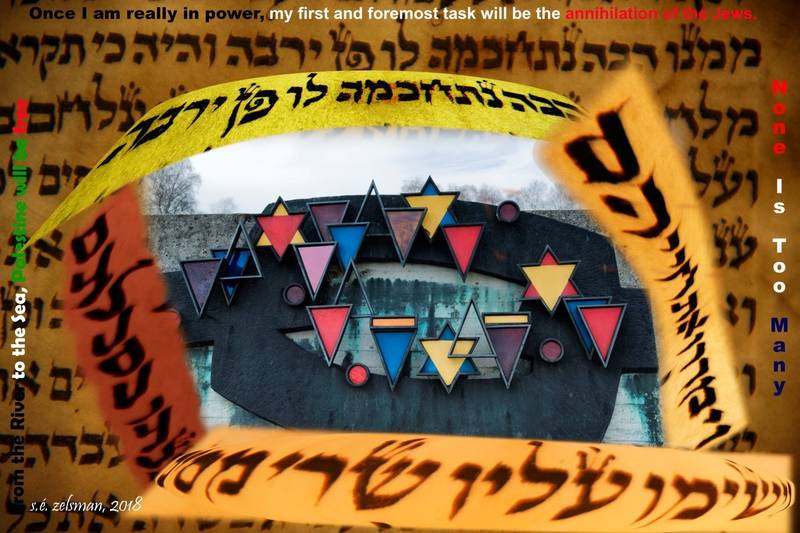
« a world history of anti-semitism » **
The first historical record of hatred towards our people and the systematic machinations to destroy us is found in the first parsha of the Book of Exodus, Shemot. There are three irrefutable psukim (verses) written in the parsha that demonstrate this: « Come let us outsmart it [The Hebrew Nation] lest it become numerous and it may be that if a war will occur, it, too, may join our enemies, and wage war against us and go up from the land. » (Exodus 1:10), « So they appointed taskmasters over it [The Hebrew Nation] in order to afflict it with their burdens... » (Exodus 1:11), and « They embittered their lives... » (Exodus 1:14)
Every incident of anti-Semitism throughout the history of our people can be described by one, if not all of those statements. The Jewish community of Prague surely understood this when it meticulously collected and catalogued over 1 500 Torah scrolls along with other precious objects of Judaica. Now more than ever, when our people, our homeland Israel and the Israeli Defense Force are being targeted all over the world with rising vehemence by Palestinians, BDS movements, Neo-Nazis, European Nationals and other world Nationals including American and Canadian politicians, it is imperative that as a Jew, you must never forget who you are nor your need to support Israel.
This article explores this theme in photographic imagery and in text format in the hope that we learn together to understand our history, support all of our fellow Jews and unite to keep Israel strong.
** Here is how the title photograph explains the theme. The background is the text of the Torah (our Czech Torah) where the three psukim are found. Those three psukim are enlarged, filled with red, yellow and orange—the colors of fire, because they are fierce, need to be burned into the mind, and because of the destruction they have caused to us historically. They are twisted and spherized to represent the reprehensible actions against us throughout time. The central image is a sculpture at the Dachau Concentration Camp—a chain with enameled triangles that represent the colored badges prisoners wore to identify their undesirable classification. Jews wore the double triangle—the Star of David, and that some of the double triangles are in more than one color, we understand Jews could be seen as undesirable for more than just being Jewish. The creation of the concentration camps for the purposes of imprisonment and extermination of Jews is what occurs when those three statements are put into effect.
Surrounding the three toraitic psukim are three messages that have been rabidly expressed by leaders and government all against Jews and/or Israel. These expressions can be understood in the messages of the psukim. The top line was said by Hitler to Josef Hell, retired major, in 1922. In Gerald Fleming’s book, Hitler and the Final Solution, the full statement is as follows:
Once I really am in power, my first and foremost task will be the annihilation of the Jews. As soon as I have the power to do so, I will have gallows built in rows—at the Marienplatz in Munich, for example—as many as traffic allows. Then the Jews will be hanged indiscriminately, and they will remain hanging until they stink; they will hang there as long as the principles of hygiene permit. As soon as they have been untied, the next batch will be strung up, and so on down the line, until the last Jew in Munich has been exterminated. Other cities will follow suit, precisely in this fashion until all Germany has been completely cleansed of Jews. (Fleming, 1994, p. 17).
Since the Nazi flag was black, white and red, those colors were chosen in the wording.
On the left, the statement is a mantra of Palestinian officials, Hamas, Palestinian terrorists and ordinary Palestinians and Palestinian supporters. Since the Palestinian flag is black, white, green and red, those colors were chosen in the wording.
On the right, the statement was made by an official in the Mackenzie King government when asked how many Jews should be accepted into Canada during the Nazi persecution. At this time, the Canadian flag was called the Red Ensign. It featured a field of red with the red, white and blue Union Jack in the upper left corner (canton). Part of the coat of arms of Canada was also in the field of red. Therefore, those colors were chosen in the wording.
----
Let us begin with a timeline of anti-Jewish, anti-Israel incidents. The table on the next page contains brief explanations of significant anti-Semitic incidents that have been documented throughout history. While the table is lengthy, it by no means is complete. Following the news today will inform you that not one day goes by without some despicable incident of anti-Semitism/anti-Israel activity arising in the world. As stated above, the book of Shemot contains several psukim (verses) that can be applied to every anti-Semitic/anti-Israel incident. For the first three incidents recorded in the table, the applicable psukim are listed. When you read the others, what pasuk or psukim do you think applies?
CHRONOLOGY OF ANTI-SEMITIC/ANTI-ISRAEL INCIDENTS
|
DATE |
INCIDENT |
BRIEF EXPLANATION |
APPLICABLE TORAH PASUK |
|
38 BCE |
Anti-Jewish riots in Alexandria, Egypt (Referred to as the first pogrom) |
Alexandrians opposed citizenship rights being granted to the Jews during the Roman era. Riots broke out and many Jews were murdered.1 |
Come let us outsmart it lest it become numerous... And they embittered their lives |
|
|
|
|
|
|
386 CE – 387 CE |
Adversus Judaeos Homilies |
St John Chrysostom, church father, delivered anti-Jewish sermons in the church of Antioch, calling Jews Christ-killers, children of the devil and haters of humanity.2 |
Come let us outsmart it lest it become numerous... |
|
|
|
|
|
|
586 – 640 |
Visigoth anti-Jewish laws |
A series of anti-Jewish laws beginning with King Recared I and continuing through successive kings where Jews were severely punished and faced death penalties. Forced conversion and expulsion also occurred.3 |
Come let us outsmart it lest it become numerous...
So they appointed taskmasters over it
And they embittered their lives
|
|
|
|
|
|
|
629 |
Expulsion of Jews from the Frankish kingdom |
Jews were seen as threats, and efforts made to convert them began under Pope Gregory I. By the 7th century, the Jewish population was significantly high to be deemed a threat. The king ordered a decree that Jews be converted or expelled.4 |
|
|
|
|
|
|
|
694-711 |
Jews in Spain declared slaves; Judaism outlawed |
Anti-Jewish laws had been adopted under the Visigoths culminating in the late 7th century. Jewish property acquired from Christians was confiscated, Jewish trade with Christians was abolished, Jewish children were removed to be raised as Christians, and finally, Jews were enslaved by Christians.5 |
|
|
|
|
|
|
|
1096-1099 |
First Crusade. Massacre of Jews in the Rhineland |
The Crusades were bloody and violent religious wars (eight) between Christians and Muslims for the control of the Holy Land. However, Jews were considered enemies, seen as responsible for the crucifixion. Money was demanded from Jews for the armies, and in the Rhineland, Jewish communities were destroyed and the Jews massacred.6 |
|
|
|
|
|
|
|
1144 |
Blood libel at Norwich, England |
The first ritual murder accusation to be directed against Jews. A boy named William was found dead, and since this occurred close to Easter, the parents assumed his Jewish employers crucified him as vengeance against Christianity. Almost the entire Jewish community was massacred as a result. Blood libels continued throughout various times in European history.7 |
|
|
|
|
|
|
|
1348 - 1350 |
Black Death Massacres |
Jews were blamed for the plague that swept across Europe. Massacres of Jews occurred in France and Spain and Germany.8 |
|
|
|
|
|
|
|
1473 - 1492 |
Marranos of Spain massacred. Inquisition established. Blood libel in Spain. Expulsion from Spain |
After Islamic control of Spain was defeated, Jews were forced again to convert to Catholicism. Marranos were Jews who adopted Christianity, but secretly practised Judaism. When this was suspected, waves of massacres and persecutions occurred and the infamous Spanish Inquisition was established. Eventually, Jews were expelled.9 |
|
|
|
|
|
|
|
1543 |
Martin Luther attacks Jews |
Protestant reformer Martin Luther writes the vehemently anti-Semitic work, « On the Jews and their Lies. » In it he states that if Christians tolerate Jews, they share in the lies, curses and blasphemy of Jews. He calls on setting fire to synagogues and Jewish schools and instructs his followers to bury what would not burn.10 In Mein Kampf, Hitler called Luther one of the greatest reformers. Numerous articles (available online) compare Luther’s acerbic rants against Jews and violent incitements to Hitler’s words and actions. NOTE: This book is still published, and advertised on Amazon and elsewhere. Googling it yields results where reviewers post malicious comments about Jews and support the text. You will find a myriad of YouTube videos conveying the same message. |
|
|
|
|
|
|
|
1715 |
Pope Pius VI issues anti-Jewish proclamation called the Editto Sopra Gli Ebrei-- Edict Concerning the Jews |
In order to protect Catholics, Pius VI put the edict into effect. The edict had 44 clauses against Jews for which the punishment was execution. Actions such as studying Talmud, selling milk, bread, or meat to Christians, being outside the ghetto after dark, and relations with Christian neighbors are some examples. This edict lasted 25 years.11 |
|
|
|
|
|
|
|
1790 – 1792 |
Jewish communities in Morocco nearly wiped out |
The Sultan of Morocco, Moulay Yazid incited pogroms against Jews and expelled Jews from Meknes and Fez.12 |
|
|
|
|
|
|
|
1881 – 1884 |
Pogroms in Russia |
Organized attacks against Jews frequently occurred during the changing landscape of Russian culture and rising anti-Jewish sentiment throughout Western Europe. |
|
|
|
|
|
|
|
1905 |
First Russian edition of the Protocols of the Elders of Zion |
Portions of this book were serialized in a Russian newspaper, Znamya (The Banner), and first published in 1905. Considered one of the most vicious anti-Semitic publications, it is a complete fabrication portraying Jews as conspirators against the state, who planned to rule the world. It records fabricated minutes from meetings of Jewish leaders who talk about such secret plans. The book was published in Europe, the Americas, Japan and in the Arab world. This publication encouraged Henry Ford in his anti-Semitic publications in 1920, for which he later apologized. Hitler had praised Ford for his publications, and the Arab world still makes reference to the protocols in their hate-mongering of Jews and Israel. In 1921, the London Times provided conclusive proof that the protocols were a fraud, and other governments have also exposed the fraud. However, right-wing groups, neo-Nazis and Holocaust deniers endorse and circulate this book. In the Arab and Islamic world, the book is taught in schools as fact and as recent as 2002, the Egyptian government aired a mini-series on television based on the protocols.13 |
|
|
|
|
|
|
|
1938 |
Anti-Semitic weekly radio broadcasts in the USA by a Roman Catholic priest |
Father Charles Coughlin, a Canadian-born Catholic priest was assigned to a parish in Michigan. A rabid anti-Semite and anti-Communist, he had a weekly radio broadcast that reached tens of millions of listeners. In his broadcasts, he repeatedly attacked Jews and even blamed them for Kristallnacht, stating that it was retaliation for the murder of Christ. November 20, 1938, that the “communistic government of Russia,” “the Lenins and Trotskys,…atheistic Jews and Gentiles” had murdered more than 20 million Christians and had stolen “40 billion [dollars]…of Christian property.”14 |
|
|
|
|
|
|
|
1952 |
Prague Trials |
After Yugoslavia broke away from Soviet control, Joseph Stalin organized the purge of high-level Communist officers in Czechoslovakia. 14 officials confessed after being severely tortured. They were accused of being traitors, spies, and Zionists. 10 of the officers were Jewish. The trial was notorious for its anti-Semitic content.15 |
|
|
|
|
|
|
|
1969 |
Execution of Jews in Iraq |
The lives of the remaining Jews in Iraq became miserable after the 1967 Six-Day War. Jews here arrested, imprisoned, lost their jobs; Jewish students could not attend universities, bank accounts were frozen and Jews had to carry yellow identity cards. Nine Jews were accused of being Zionist spies. On January 27, 1969, Jews were executed and their bodies hung from gallows in Liberation Square, Baghdad.16 |
|
|
|
|
|
|
|
2016 |
UNESCO resolution denies Jewish ties to Judaism`s holiest of sites: Temple Mount and the Western Wall |
The sites were only listed as Muslim sites. However, the vote on the resolution was delayed and a sentence was added to mention that Jerusalem and its Old City walls are holy to all three religions. The name, Western Wall, is mentioned twice only and in quotation marks .17 |
|
|
|
|
|
|
|
2017 |
UNESCO resolution denies Israeli claims to the Jerusalem on May 2 |
All references to Israel in regards to Jerusalem were as the « Occupying Power. »18 |
|
|
|
|
|
|
|
2018 |
South African Ruling Party to March in Solidarity with Palestinians |
The march is to coincide with the Hamas violent clashes at the border. The party states that « The march will be in solidarity with the Palestinian people`s Great Return March as well as in protest against the Israeli killings of the Palestinian people. »19 |
|
|
|
|
|
|
|
2018 |
Icelandic bill proposes criminalizing circumcision for non-medical reasons |
Arguing that the practice violates the child’s rights, a six-year prison term would be imposed. MP Silja Dögg of the Progressive party who had introduced the bill stated, « We are talking about children’s rights, not about freedom of belief. Everyone has the right to believe in what they want, but the rights of children come above the right to believe. »20 This is considered another threat to Jewish life in Scandinavia. It is important to remember that Norway, Finland, and Sweden have banned kosher slaughter since the 1930’s and Denmark has banned kosher slaughter in 2014. |
|
|
|
|
|
|
|
2018 |
Irish Senate votes to advance bill that would criminalize trade with any part of Israel located over the pre-1967 lines (2nd reading: July 11, 2018) |
The bill states that it is « an offence for a person to import or sell goods or services originating in an occupied territory or to extract resources from an occupied territory in certain circumstances; and to provide for related matters. » Anyone found guilty faces a fine for « anywhere up to five years and could be fined up to a quarter of a million euros. »21 |
|
Notes
1Tcherikover, A.V. (1959), Hellenistic Civilization and the Jews. Retrieved July 9, 2018 from https://www.jewishvirtuallibrary.org
2 “The Origins of Christian Anti-Semitism.” Jerusalem Center For Public Affairs, jcpa.org/article/the-origins-of-christian-anti-semitism/. Interview with Peter van der Horst
3 Furst, Julius. “The Jews in Spain Under the Visigoths.” The Letter Of Acceptance Of Rev. Dr. Wise. Retrieved July 9, 2018 from www.jewish-history.com/occident/volume7/nov1849/visigoths.html.
4Taitz, Emily. (1994), The Jews of Medieval France. Westport, CT: Greenwood Press
5“Kehillat Israel Jews in Spain Page.” Timeline for Jewish Traditions in Death and Mourning, kehillatisrael.net/docs/learning/sephardim.html.
6Levy, Joshua. “How the Crusades Affected Medieval Jews in Europe and Palestine.” My Jewish Learning, My Jewish Learning. Retrieved July 10, 2018 from www.myjewishlearning.com/article/the-crusades/.
7Alperovich, L. (2013), “Secrets of the Norwich Blood Libel.” Orthodox Union, History. Retrieved July 10, 2018 from https://www.ou.org/life/history/secrets-of-the-norwich-blood-libel/
8”Black Death Jewish persecutions.” antisem.eu. Retrieved July 10, 2018 from https://www.antisem.eu/black-death-jewish-persecutions/
9”Marrano.” New World Encyclopedia. Retrieved July 10, 2018 from http://www.newworldencyclopedia.org/entry/Marrano
10Michael, Robert. “Blueprint for the Holocaust.” Retrieved July 11, 2018 from http://www.harrington-sites.com/Luther.htm
11”Christian-Jewish Relations: Pope Pius VI: Edict over the Hebrew (Editto sopra gli ebrei).” Retrieved July 11, 2018 from https://www.jewishvirtuallibrary.org/pope-pius-vi-ldquo-edict-over-the-hebrew-rdquo
12”History of the Jews in Morocco.” Holocaust, A Call to Conscience. Retrieved July 11, 2018 from http://www.projetaladin.org/holocaust/en/muslims-and-jews/muslims-and-jews-in-history/history-of-the-jews-in-morocco.html
13”Protocols of the Elders of Zion.” Holocaust Encyclopedia. United States Holocaust Memorial Museum. Retrieved July 11, 2018 from https://www.ushmm.org/wlc/en/article.php?ModuleId=10007058
14”Father Coughlin Blames Jews for Nazi Violence.” History Unfolded, US Newspapers and the Holocaust. Retrieved July 11, 2018 from https://newspapers.ushmm.org/events/father-coughlin-blames-jews-for-nazi-violence
15 Frankl, M. (2010, October 19). ”Slánskỳ Trial.” The YIVO Encyclopedia of Jews in Eastern Europe. Retrieved July 11, 2018 from http://www.yivoencyclopedia.org/article.aspx/Slansky_Trial#author
16Julius, L. (2014), “Clash of Cultures. A black day in January for Iraq’s Jews.” The Jerusalem Post. Retrieved July 11, 2018 from https://www.jpost.com/Arab-Israeli-Conflict/WATCH-Irish-senate-debates-criminalizing-Israeli-settler-trade-562223
17”UNESCO Votes: No Connection Between Temple Mount and Judaism.” (October 13, 2016), The Jerusalem Post. Retrieved July 11, 2018 from https://www.jpost.com/Breaking-News/UNESCO-No-connection-between-Temple-Mount-and-Judaism-470050
18”Full text of May 2017 UNESCO resolution on ``Occupied Palestine.” The Times of Israel. Retrieved July 11, 2018 from https://www.timesofisrael.com/full-text-of-may-2017-unesco-resolution-on-occupied-palestine/
19Chernick, Ilanit (April 23, 2018), “South African Ruling Party to March in Solidarity with Palestinians,” The Jerusalem Post. Retrieved July 11, 2018 from https://www.jpost.com/International/South-African-ruling-party-to-march-in-solidarity-with-Palestinians-552522
20”Iceland’s mooted circumcision ban sparks religious outrage.” BBC News. Retrieved July 15, 2018 from https://www.bbc.com/news/world-europe-43111800
21Lazaroff, T. (July 11, 2018), “Israel summons Irish Ambassador Over Settlement Criminalization Bill Vote.” The Jerusalem Post. Retrieved July 11, 2018 from https://www.jpost.com/Arab-Israeli-Conflict/WATCH-Irish-senate-debates-criminalizing-Israeli-settler-trade-562223
----
Now we begin to explore the themes of this article visually through a variety of photographs (photo images).
In the photograph (photo image) below, a photograph of the statue of Rameses II at the Temple of Luxor is superimposed over our Czech Torah, opened at the Book of Shemot. You can see the start of the pasuk (verse): « A new king arose over Egypt, who did not know Joseph. » (Exodus 1:8) In the parsha commentary, Rashi’s commentary on this pasuk explains that the words mean that the king « acted as if he did not know him. » “Shemot - Exodus - Chapter 1 (Parshat Shemot).” www.chabad.org/library/bible_cdo/aid/9862/jewish/Chapter-1.htm
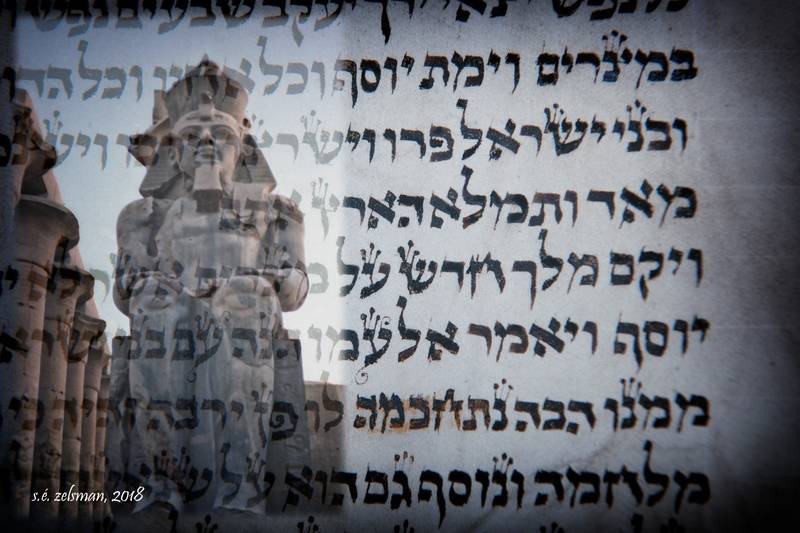
« a new king arose over egypt »
Thinking about this commentary, is it possible to infer that the new king intentionally attempted to rewrite the historical narrative regarding Joseph (therefore, Hebrews) who, by his interpretations of Pharaoh’s dreams, saved Egypt from the seven years of famine in order to justify enslaving the Hebrews and treating them as non-people? If so, is this not then the same form of rewriting history that UNESCO is doing; that is, denying Jewish connection to our most holy sites in Israel? This is why it is crucial to act upon these resolutions because when they succeed, the very same threat to our existence becomes possible.
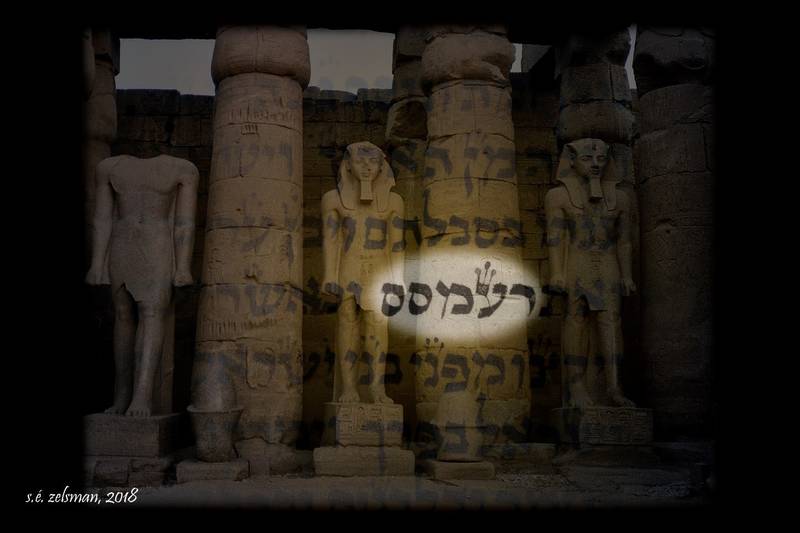
« it built storage cities for Pharaoh, Pithom and Raamses »
A photograph from the Temple of Luxor is superimposed over our Czech Torah with the word Raamses clearly visible.
----
In the next series of photographs (photo images), photographs of historical objects have been symbolically embedded into the klaf (parchment) of our Czech Torah using the three specific psukim (verses) as titles. The purpose of this is to reinforce the message that we must never falter in recognizing who we are as Jews, support each other in our Judaism and never relinquish our support for our homeland, the Jewish State of Israel.
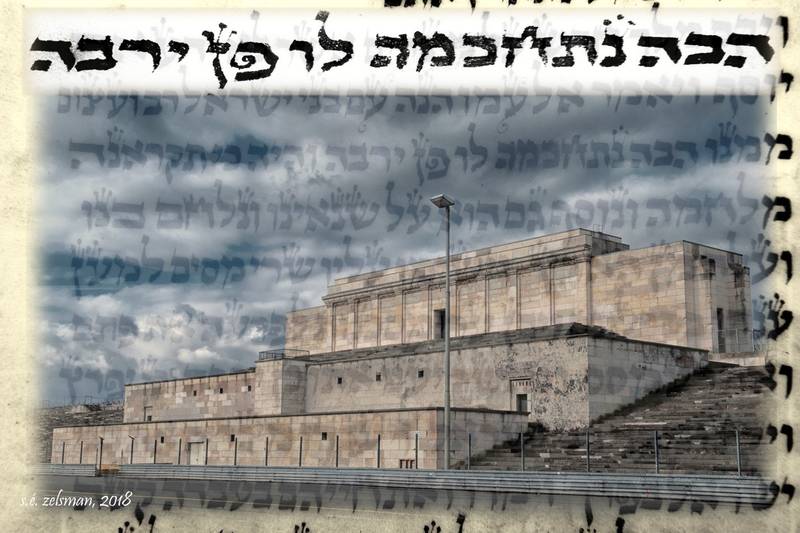
« come let us outsmart it lest it become numerous: Die Zeppelinhauptribüne »
A photograph of the grandstand in the Zeppelin Field (Die Zeppelinhauptribün) in the southeast part of Nuremberg where, between 1933 and 1938, Nazi party rallies were held. Just above the 2nd tier is where Hitler would stand and speak. On September 15, 1935, the famous Nuremberg laws were introduced. These racial laws were horrendously anti-Semitic, defining who was Jewish, and stripped Jews of their citizenship rights. Employment was strictly reduced to menial types of employment and these laws paved the way for all forms of discrimination and attack. The following is an excerpt from the Nuremburg Laws:
The Reich Citizenship Law of September 15, 1935
First Supplementary Decree of November 14, 1935
On the basis of Article III of the Reich Citizenship Law of September 15, 1935, the following is hereby decreed:
ARTICLE 4.
- A Jew cannot be a citizen of the Reich. He cannot exercise the right to vote; he cannot hold
hold public office.
- Jewish officials will be retired as of December 31, 1935. In the event that such officials
served at the front in the World War for Germany of her allies, they shall receive as pension, until they reach the age limit, the full salary last received, on the basis of which their pension would have been computed. They shall not, however, be promoted according to their seniority in rank. When they reach the age limit, their pension will be computed again, according to the salary last received on which their pension was to be calculated.
- These provisions do not concern the affairs of religious organizations.
- The conditions regarding service of teachers in public Jewish schools remains unchanged
until the promulgation of new laws on the Jewish school system.
“Neither Black Nor White: Intermarriages and Mischlinge during the Third Reich.” Nuremburg Laws, www.owlnet.rice.edu/~rar4619/reich.html.
Shortly after, there followed all manner of assaults, vandalism, boycotts against Jews in Germany and even more threatening and harsh laws against Jews.
Keeping this information in mind, the next two photographs (photo images) take us to Canada where anti-Semitic practices flourished in our own Toronto backyard.
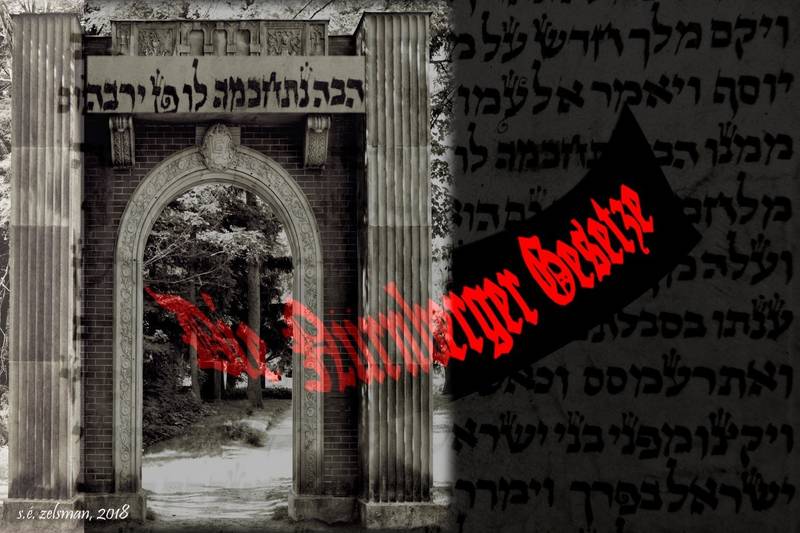
« come let us outsmart it lest it become numerous: nuremberg laws »
In the photograph (photo image) above, an old entrance (arch) is superimposed over the Czech Torah and the pasuk (verse) of the title is superimposed over the structure, just above the keystone. Floating through the entrance is a banner in red letters. The words are in German: « Die Nürnberger Gesetze-- » the Nuremberg Laws. This entrance is now permanently housed in the Guild Park and Gardens—Toronto’s historic park that houses beautiful structures from old Toronto buildings that were demolished.
This entrance is the original entrance to old Granite Club that was on Church Street, just north of Wellesley. The club was demolished in 1972 when it expanded and moved to Bayview Avenue, south of the Bridle Path. The entrance was saved and permanently placed in the Guild Park.
The Granite Club was notorious for its discriminatory practices against Jews and other minorities, barring them from joining. The symbolism in this photo image is evidenced by the banner that is freely floating and meandering through the entrance way, suggesting that organized and systemic anti-Semitism is espoused everywhere.
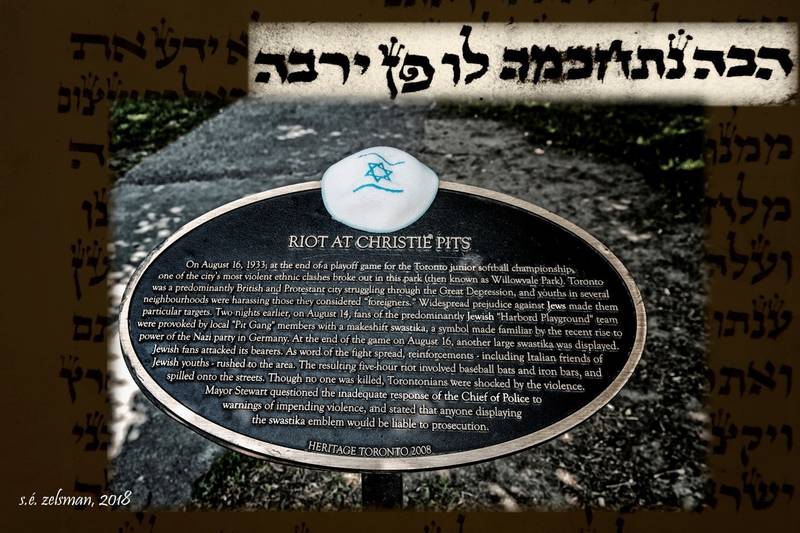
« come let us outsmart it lest it become numerous: christie pits riot »
The Christie Pits Park is located at Bloor and Christie Streets. Bloor Street is the south end, Christie Street is the east side while Barton Avenue and Crawford Street from the north end and west end respectively. The Heritage Toronto plaque seen in the photo is located at the northeast corner of Bloor Street at Christie.
On August 16, 1933, not too long after Hitler’s rise to power in Germany, a softball game was being held between the St. Peter’s team and the Harbord Playground team, the latter of which was predominately Jewish. During that time, anti-Semitism was rampant in Toronto and a gang known as the Pit Gang displayed a giant swastika at end of the game. This sparked a riot as each side brought in reinforcements. Daniel Bitonti, journalist, in his Globe and Mail article of August 9, 2013, « Remembering Toronto’s Christie Pits Riot, » retrieved from https://www.theglobeandmail.com/news/toronto/remembering-the-christie-pits-riot/article13695461/ records that the riot lasted nearly six hours.
The photo image superimposes the Heritage Toronto plaque onto the Czech Torah scroll which is dimly seen in the background. The relevant pasuk (verse) is brightly visible in the top of the image. A kippah with the Magen David was placed on the plaque to remind us that no matter where we are, anti-Semitism can easily surface and that we must never forget that it happens even in our own city. Placing the kippah on top of the plaque reminds us that we will fight back and that we need to keep our Judaism strong and keep our homeland, Israel, strong.
----
One of the interesting aspects of parshat Shemot is that the Torah clearly describes the stages of oppression which has become a model that was used throughout history. The construct of anti-Semitism may appear to have changed (BDS, UN resolutions and anti-Israel activism); however, the descriptors are identical those found in the Torah. First, it begins with the pasuk (verse), « A new king arose over Egypt, who did not know Joseph. » (Exodus 1:8) If we interpret this according to Rashi, the new king pretended not to know the good that Joseph provided him, and then chose to dismiss the truth, and instill fear of the Hebrews by spreading lies about them. The progression is seen in the pasuk, « So they appointed taskmasters over it [The Hebrew Nation] in order to afflict it with their burdens... » (Exodus 1:11) Spreading the idea that the Hebrews are a threat, the Egyptians attempted to exercise oppressive control. The next photograph (photo image) creates a visual representation this pasuk.
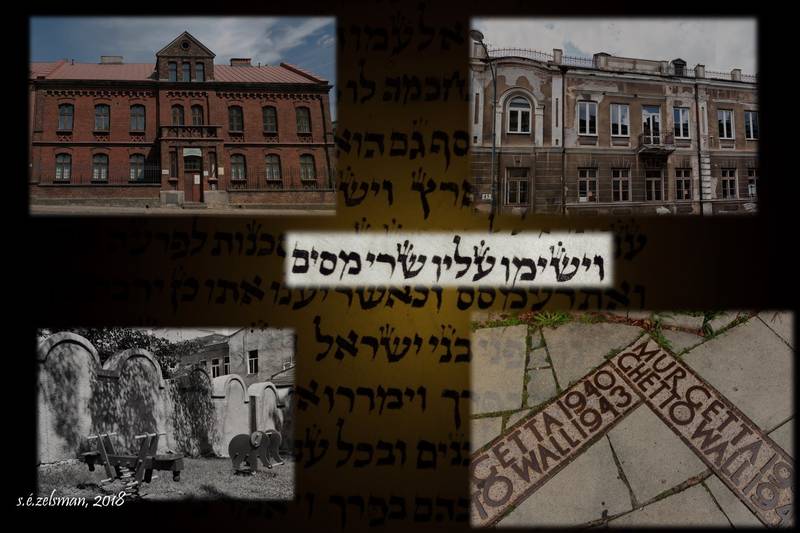
« so they appointed taskmasters over it »
In the photograph (photo image) above, you see four images of living objects that represent anti-Semitic practices associated with the notion of appointing taskmasters over a people. They are superimposed on the Torah scroll which has been darkened, save for the spot of glowing light. The glowing light reminds us of the incomparable truth of the Torah. The objects were placed in each corner to represent the understanding that anti-Semitism occurs throughout the four corners of the world, and the relevant pasuk is sharp and unmistakably visible in the center, near the glowing light of the Torah and abutting each object.
At the bottom right, you see the Warsaw Ghetto marker in the sidewalk that shows where the enclosing wall was built. This marker is found on the corner of ulica Świȩtojerska and ulica Nowiniarska in the Nowe Miasto (New Town) area of Warsaw. Just across this intersection is the Muranów neighborhood which, during the time before World War II, was inhabited primarily by Jews. It is here that the Warsaw Ghetto was created by the Nazis in 1940.
At the bottom left, you see the remaining walls from the Kraków Ghetto. The shape of the walls was striking. The Nazis built them with arches on the top to make the walls look like tombstones which the Jews would see each day. Today, ironically, a primary school playground exists on one side of the wall here at ulica Limanowskiego.
At the top left, you see a building known as « The Red House », found at ulica Kościelna 8/10 in Łódź. This building was a parish house, but used by the Nazis as a police criminal unit called the Sonderkommando Getto and then the Kriminalkommissariat Getto. Its purpose was to combat smuggling, confiscate property, and monitor the ghetto inhabitants. The unit was notorious for its routine beatings and torture of ghetto inhabitants to get them to talk. Sadly, there was a Jewish police unit that informed on their fellow Jews in the ghetto. (“Kripo (Kriminalkommissariat Getto) 8/10, Koscielna Street (Kirchgasse).” Lodz Ghetto, Litzmannstadt Ghetto, www.lodz-ghetto.com/kripo.html,10.
At the top right, you see an abandoned building. This building is the Judenrat Building on ulica Iłżecka 45, Ostrowiec Świętokrzyski. The Judenrat, the Jewish Council was a creation of the Nazis in order to use Jews against each other, by giving the council power and control over the community.
----
Since ordinary people can easily be swayed into believing the fake news, it becomes possible for a society to justify its use of oppressive measures. Once the propaganda spreads, and once the beginning stages of control are in place, then oppressive measures are put into place to marginalize the targeted population. This permitted the next stage to appear where discriminatory practices become embedded in law and all manner of practices can occur for the sole purpose of quashing a people. We read the all-telling pasuk (verse) in the Torah: « They embittered their lives... » (Exodus 1:14) This same pattern has been seen over and over again in the chronology of anti-Semitic incidents, summarized in the table above.
The following four photographs (photo images) are visual representations of episodes in Jewish history where anti-Semitic practices were specifically enacted to destroy Jewish life.
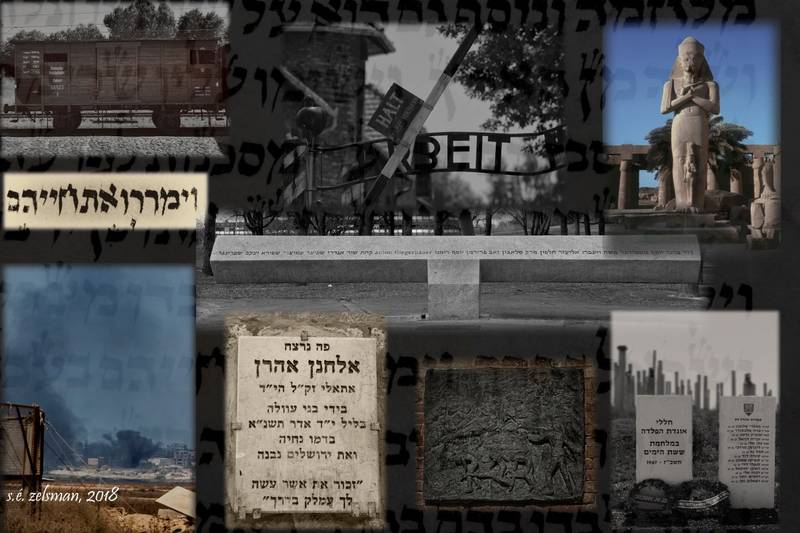
« and they embittered their lives »
In the above photograph (photo image), eight photos were superimposed over our Czech Torah which was opened up to the beginning of parshat Shemot. The important words from the Torah are enlarged and placed at the top left. Each of the small eight photos is symbolic representations of these words.
While no particular order was devised when placing the eight photos, placing the top right image in that corner had a purpose. This is a statue of the pharaoh, Ramses II in the Temple of Karnak, Luxor, Egypt. Since Hebrew is read from right to left, and since the very first recorded incident of anti-Semitism is found in the Torah, this image was placed at the top right.
Going counter-clockwise from the top right, the next image (black and white) is a photograph of the famous gate at the entrance to the Auschwitz concentration camp with the sadistic message: Arbeit macht frei (Works sets you free). The inhuman living conditions, the systematic processes of working people to death, of murdering them and disposing of them are heard in the simple words of the pasuk.
At the top left, you see a picture of a cattle car used at the Radegast Transport Station in Łódź, located just outside of the ghetto (known as the Litzmannstadt Ghetto). It was here that Jews were transported to concentration and extermination camps.
In the middle, you see a concrete monument in the shape of a « T » with Hebrew names etched into the horizontal piece. This is a memorial to the eleven Israeli Athletes murdered during the 1972 Olympics in Germany. On September 5, 1972, terrorists stormed the Olympic village, tortured and murdered two Israeli athletes and took nine others as hostage. The Palestinian terrorists demanded the release of Arab prisoners in Israel and demanded safe passage to Cairo with the hostages. They headed for the military airport in Munich to take the hostages back to the Middle East. During gun battle with the West German police, three of the kidnappers were killed and all nine Israeli athletes were murdered.
Three terrorists were captured, but soon released when a Lufthansa jet was hijacked by terrorists demanding their release, so the West German government gave in to the demands.
On the bottom right, you see a photo of the Ugdat Haplada monument at the Avshalom Junction in Israel. This monument commemorates the casualties of the 84th Armored Division who died during the Six-Day War.
The next photo to the left is a commemorative plaque to the Jews Venice that is found in the old Jewish Ghetto of Venice.
The next photo to the left (second last), is a plaque that is found in the Old City. It is a plaque put up in memory of Elhanan Aharon Attali. Elhanan was born in France in 1964, and when he was one month old, his family made Aliya. Elhanan served as a commander in the Engineering Corps of the Israeli Army. His dream was to found a Yeshiva. On the 14th of Adar, 5751 (Thursday, March 18, 1991), Elahanan was on his way to a Purim party. He was ambushed by Arabs and brutally murdered. The plaque is found on Haggai Street. “In Memory of Elhanan Attali.” אלחנן אתאלי הי"ד, elhanan.name/english/.
The photo in the bottom left corner was taken on July 24, 2012 at the old Nahal Oz border crossing in the northeast section of Gaza. The Nahal Oz crossing was the only source of transfer of fuel to the Gaza Strip. On April 9, 2008, Palestinian terrorists set of mortar bombs at the Nahal Oz fuel terminal of the crossing. Other terrorists penetrated Israeli territory and murdered two Israeli workers at the fuel terminal. Israeli Ministry of Foreign Affairs (2008, April 09). MFA Foreign Policy, Behind the Headlines, Behind the Headlines: Attack on the Nahal Oz fuel crossing into Gaza. Retrieved from http://www.mfa.gov.il/mfa/foreignpolicy/issues/pages/behind%20the%20headlines-%20attack%20on%20nahal%20oz%20fuel%20crossing%20into%20gaza%209-apr-2008.aspx .
The crossing was permanently closed in 2010. When this photograph was taken, something had been fired at the soldiers guarding the area; the black smoke is the result of the explosion.
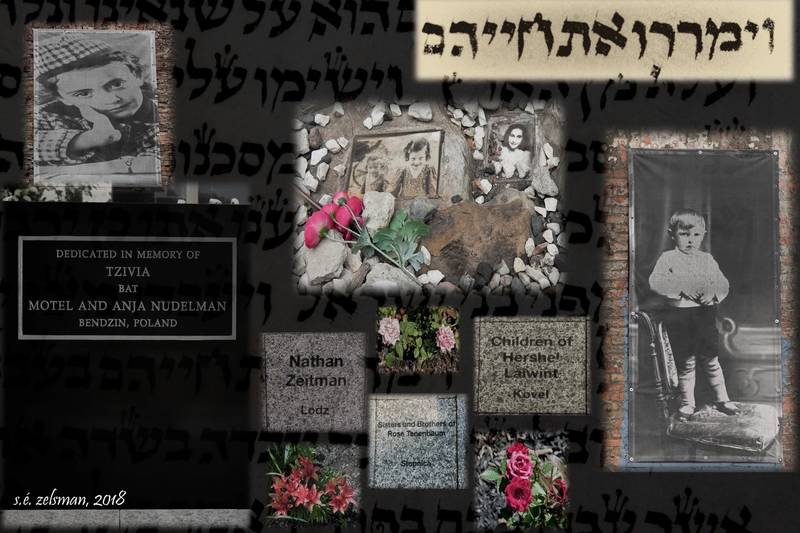
« and they embittered their lives: the children »
In the photograph (photo image) above, small photographs are all superimposed over our Czech Torah which is open at the beginning of parshat Shemot. The message of this photo image is given by the pasuk (verse) which forms the title of the photograph, especially as it relates to the millions of children who were murdered during the Holocaust. the top left corner and in the bottom right corner are two photographs of Polish Jewish children, victims of the Holocaust. The originals are larger than life and hanging on the outside of a building that stands on ulica Próźna in Warsaw. They are part of the « And I Still See Their Faces » campaign of the Shalom Foundation in Poland. This is the only street of the Warsaw Ghetto where tenement buildings from that era remain.
At the top middle, just below the pasuk, is a photo taken of the memorial for the million children who perished in the Holocaust. It is located just inside the Warsaw Jewish Cemetery at ulica Okopowa. This cemetery was founded in 1806 and is the burial place of many noted people such as Ludwik Zamenhoff, inventor of Esperanto and Adam Czerniakow, senator before the war and head of the Judenrat. In 1942, he committed suicide after his repeated attempts to spare Jewish orphans failed. He wrote a note to his wife and to the Jewish Council saying, « They are demanding that I kill the children of my people with my own hands. There is nothing for me to do but die. » “Adam Czerniakow and His Diary Http://Www.HolocaustResearchProject.org, 2007. www.holocaustresearchproject.org/ghettos/acdiary.html. The memorial is made of small photos of children placed in a bed of stones. The picture at the top right in the inset photo is Anne Frank.
The photographs at the bottom are taken at the Samuel Edelstein Children’s Garden in the front of our shul. There are pavers with the names of children who perished in the Holocaust. A dedication in the form of a gravestone marks the name of a young girl who perished.
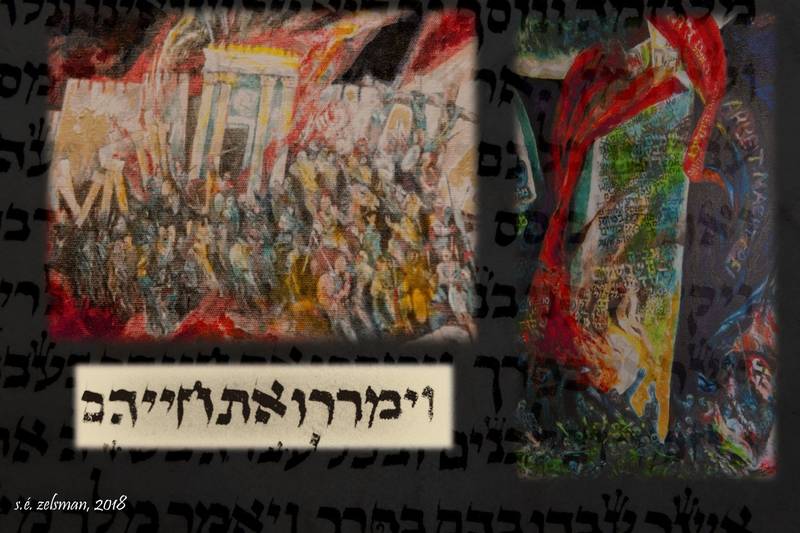
« and they embittered their lives: the presence of amalek »
In the above photograph (photo image), two small sections of the painting, « Under the Wings of G-d & the Shadow of Amalek » by Dubi ARIE, which is on the wall in the shul across from the Lerman Chapel, are superimposed on the Czech Torah scroll opened at the beginning of parshat Shemot. The message we must learn from this is that we are always under the destructive threats of Amalek and that when we unite as Jews in support of each other and in support of Israel, we will be able to vanquish anti-Semitism.
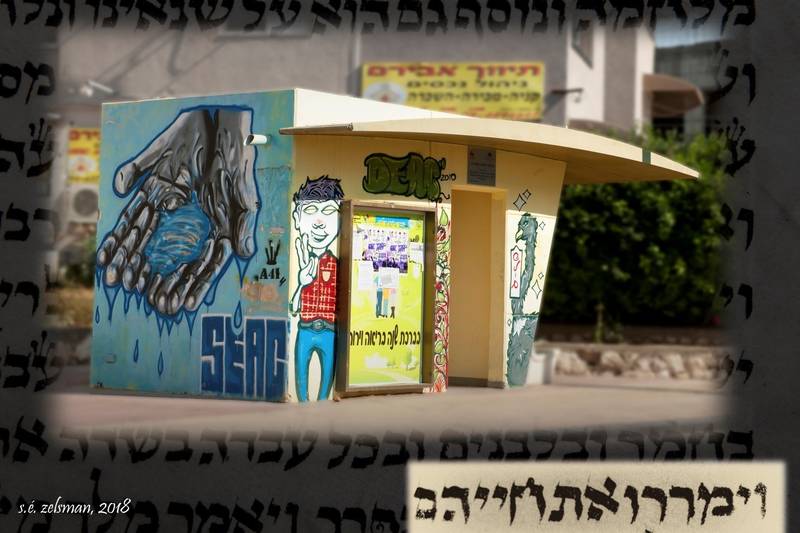
« and they embittered their lives: sderot »
The object in the photograph (photo image) above is a bomb shelter in one of the streets of Sderot, Israel. Sderot is about one kilometer from Gaza and is the victim of constant rocket fire from Hamas terrorists. The city continuously sustains damage from rocket fire, but thanks to the Iron Dome, many of these rockets are intercepted before causing destruction. Still, the trauma people experience on a constant basis from the attacks and from the deafening sirens is overwhelming. The psychological damage to one’s spirit from terrorist activities is devastating.
This image reminds us that anti-Semitism and anti-Israel behavior, even in its modern form, has never changed its pattern from the original as described in the Torah. Even today, we Jews live in a perpetual state of war because our oppressors are everywhere. This is why we must stand together no matter who we are and why we must be united in our support of Israel.
----
The Torah tells us about strength of character, knowing who we really are and fighting for justice no matter our walk in life. This is especially true for Jews, given the enemies around us. Accordingly, there is a fourth pasuk (verse) in parshat Shemot to which we must pay attention. In Exodus 2:11, we read: « It happened in those days that Moses grew up and went out to his brethren and observed their burdens; and he saw an Egyptian man striking a Hebrew man, of his brethren. » The use of the word, brethren, implies that Moses knew he was Hebrew. But how could this be since he was raised in the palace of Pharaoh. Did Pharaoh’s daughter, who knew he was Hebrew tell him? Did Moses’ mother, who nursed him, tell him? A commentary in the Stone Edition Tanach (2011) on page 136 states, « Though Moses had been raised in the splendor and anti-Semitism of the palace, he remained the son of Amram and Jochebed. Though his mother had him for only the earliest years of his life, she had succeeded in imbuing him with love of and loyalty to his people; he remained not an Egyptian prince, but a Jew, and he displayed the compassion for the downtrodden that stamped him as the future redeemer of Israel. »
In the book, Ramban, Commentary on the Torah, translated and annotated by Rabbi Dr. Charles B. Chavel, volume Exodus (1973) on page 17 – 18 Ramban explains, « This indicates that they told him he was a Jew and he desired to see them because they were his brethren. Now he looked on their burdens and toils and could not bear [the sight of his people enslaved]. This was why he killed the Egyptian who was smiting the oppressed Hebrew. »
This pasuk (verse), given the above interpretations, is most relevant today where there are whole societies, governments, politicians, activists, and world bodies who, through hypocrisy, double standards, lies, threats and violence seek to deny us of our faith, history, homeland and of our very existence. The next two photographs (photo images) remind us of our obligations to our Judaism, our Jewish brethren and our homeland, Israel.
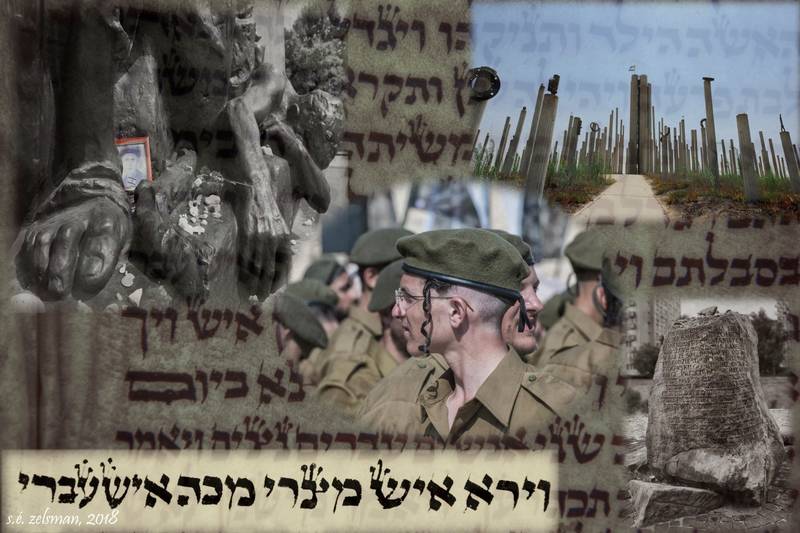
« and he saw an egyptian man striking a hebrew: our heros (1) »
In the above photograph (photo image), four photographs are superimposed on the Czech Torah scroll opened at the pasuk (verse) which is the title. This pasuk has been enlarged and placed on the bottom of the image. The message in this photo image is one of recognition of the fearless Jewish fighters who fought for Jews and for Israel.
At the top right is the Ugdat Haplada monument which commemorates the casualties of the 84th Armored Division who died in the Six-Day War. There are four hundred concrete columns, some of which have authentic parts of tanks and weapons affixed.
At the top left is a photograph of the Ghetto Heroes Monument (Pomnik Bohaterów Getta) in Warsaw which commemorates the Warsaw Ghetto Uprising of 1943. It is found in the square at ulica Anielewicza, Karemlicka, Zamenhofa and Lewartowskiego. This area is located at the spot where the first armed clash of the uprising occurred. You see the foot of a fighter who fought with whatever was available.
At the bottom right is a commemorative stone with inscriptions in Yiddish and Polish on the memorial mound at Miła 18, site of a bunker in the Warsaw Ghetto. When the bunker was discovered by the Nazis, there were some 300 freedom fighters in it, including Mordechai Anielewicz, leader of the Jewish Combat Organization. The mound is made from the rubble of the houses on ulica Miła, whose name, ironically, means « Pleasant Street. »
In the center is a photo of a young Israeli Haredi soldier who was being sworn into the IDF at the Swearing-in Ceremony at the Kotel. We see in him the embodiment of faith at all levels: religious/spiritual, faith in Israel, ready to defend and if necessary, sacrifice himself for the protection and freedom of Israel. When we do what we can for the protection and freedom of Israel, we are supporting Jews everywhere.
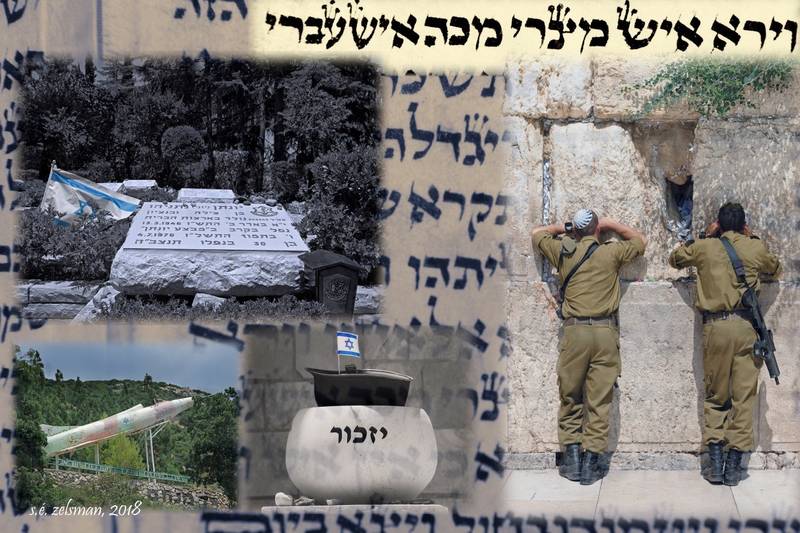
« and he saw an egyptian man striking a hebrew: our heros (2) »
In the above photograph (photo image), four photographs are superimposed on the Czech Torah scroll opened at the pasuk (verse) which is the title. This pasuk has been enlarged and placed at the top of the image. The message in this photo image also is one of recognition of the fearless Jewish fighters who fought for Jews and for Israel.
On the right are two Israeli soldiers who approached the Kotel and began to pray to Hashem. They embody the pillars of Judaism: the faith, the observances at all levels, Jerusalem the Holy, Israel our homeland, service to Hashem and to Israel, protectors and defenders of Jews everywhere and the Jewish state.
At the bottom, in the middle, is one of several sculptures seen at Har Herzl in Jerusalem. It is an upside down helmet in a basin with a little flag of Israel standing upright. The simple word, « Yizkor » (Remember) commands us to remember the fallen soldiers who gave their lives to protect Jews and to protect Israel at all costs.
At the bottom left is a photograph taken in Moshav Amirim, a vegetarian community in the Galilee. It is an Israeli warplane which stands as a memorial to a fallen soldier named Menachem Kashdan, a pilot who was killed in the Yom Kippur War of 1973. Menachem was from the Moshav.
Perhaps the most poignant of all is the black and white photograph in the top left corner. It was taken on Har Herzl at the grave of Yonatan Netanyahu who was killed in action while commanding the rescue of hostages held at Entebbe Airport in Uganda. With the flag kept in color and the gravesite tinged with a blue filter, the powerful sadness is felt.
On June 27, 1976, an Air France plane was high-jacked by members of the PLO and other terrorists in Athens, en route from Tel Aviv back to Paris. The plane was diverted to Entebbe and welcomed by the Ugandan government who supported the terrorists. Most of the non-Israeli passengers were released, but the Israeli passengers and crew were not. The rescue operation by Israel alone was a success; however, four were killed. Tragically, on July 4, 1976, Lt. Col Yonatan Netanyahu was shot outside the airport building that was being stormed during the rescue operation.
----
We close this article on a positive note with the photograph (photo image) below. The relevant passage from the Torah is the Song of Moses, sung by Moses and the Children of Israel. We read in Exodus 14:30 – 15:1 (parshat Beshalach) the following: « On that day, Hashem saved Israel from the hand of Egypt, and Israel saw the Egyptians dead on the seashore. Israel saw the great hand that Hashem inflicted upon Egypt; and the people revered Hashem, and they had faith in Hashem and Moses, His servant. Then Moses and the Children of Israel chose to sing this song to Hashem... »
In the photograph (photo image) below, we understand the message that we must take from parshat Shemot which is connected to our commitment to restore our Czech Torah. Superimposed over the psukim (verses) are three flags (the flag of Israel in the middle, the flag of Jerusalem to its right, and the flag of the Old City to its left) that stand side by side near the Tower of David in the Old City. Our whole history is embodied by these three flags, and just as they stand side by side, we, too, must stand side by side and be proud of our Judaism, proud that Hashem protects us, proud of Jerusalem and proud of our homeland Israel. Together, we must also be thankful for our Judaism, thankful for Jerusalem and that it is united once again, and thanful for our homeland, Israel. Finally, in prayer, song, words and deeds, we must support our Judaism, support a united Jerusalem and support our homeland, Israel.
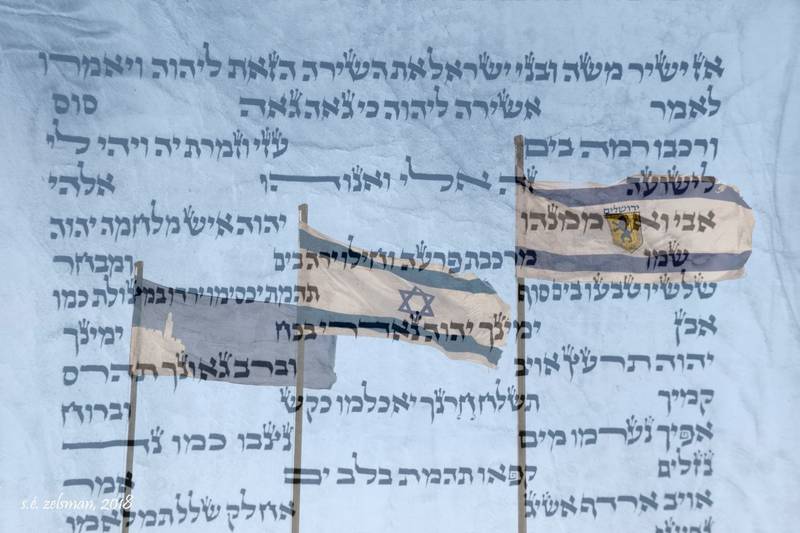
« then moses and the children of israel chose to sing this song »
----
This article is the eighth in a series of short photo essays to help our community members see and learn with us. We welcome you in being part of the journey of the Czech Torah Restoration Project at Beth Emeth Bais Yehuda. Please contact the shul office at 416 633 38 38.
July 4, 2018
From the Creation of the World to the Creation of our Nation
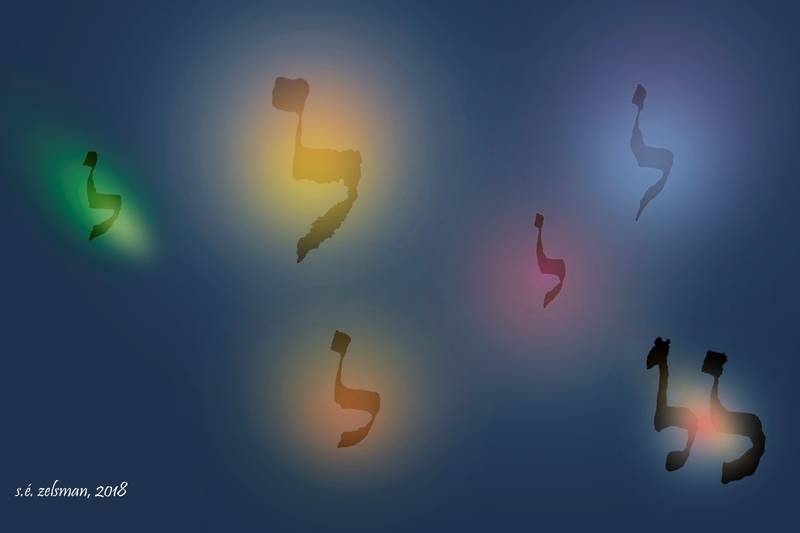
« Tower Flying in the Air »
While our Magiah (proofreader) has been making corrections to our Czech Torah, he has noticed unusual aspects in the ktav (script), anomalies in previous corrections since its completion over 300 years ago and even one stamp marking that he cannot explain. In this article, we look at more unique qualities of our Torah and other interesting Torah facts as our Magiah completes the restoration of Breishit.
Lamed. The twelfth letter in the Hebrew alphabet. Two Hebrew verbs of similar form which are very important in Jewish living invoke the name of the letter—lilmod (to learn) and le-lamed (to teach). Rabbi Aaron L. Raskin, Chabad emissary, Brooklyn Rabbi and Dean of Brooklyn Heights Jewish Academy, has this full explanation on the letter:
The twelfth letter of the alef-beis is the lamed. The design of the lamed is two letters merged together: the vav and the kaf. The Kabbalah says that the letter lamed is compared to a tower flying in the air.
Gematria
The gematria of lamed is thirty. It states in Ethics of Our Fathers: “When one reaches the age of thirty, he reaches the age of full strength.” We find in the Torah that when the Jewish people were in the desert, the Levites who carried the heavy vessels had to be between the ages of thirty to fifty, for these are the mightiest years of man.
What was the underlying purpose of the Jews’ journeying forty years in the desert? On one hand, we know that it was the result of the sin of the Spies. The Spies’ forty-day turn in the Land of Israel evoked G‑d’s decree to remain in the desert for forty years. But why did they specifically have to wander throughout the desert? Why not stay in one place? Set up camp and stay there for forty years. What was the reason for having to undertake a total of forty-two different journeys in forty years?
The purpose of the Jewish people’s travels in the desert was to transform it into a garden; to bring G‑dliness to a desolate place. By carrying with them the Holy Ark—and within it the Torah—each and every one of the Jews’ encampments became not only a spiritual but a literal garden. This became a lesson and guidepost for the Jewish people in all their future exiles. G‑d was informing them: Throughout history, you will have to travel. You’ll trek from country to country to country. But wherever you go, you must take the Ark of G‑d with you—ushering G‑dliness to that area, elevating it and making its inhabitants more refined and spiritual. This is the purpose of a Jew.
This power to begin transforming the world in earnest begins when we turn thirty. Up until that point we are in training. The Midrash Shmuel states that one has the ability to guide and influence others for good at the age of thirty. Until then, he is simply laying his foundation.
We find another interesting gematria in relation to lamed. Both the alef (in the form of the word ulfana) and the lamed (as in lameid) represent G‑d as a teacher. What’s the connection between the two letters? The design of the alef is comprised of two yuds and a vav: 10 and 10 and 6=26. The lamed is comprised of a kaf and a vav: 20 and 6=26. Twenty-six is the gematria of G‑d’s name, the Tetragrammaton Yud-Hei-Vav-Hei.
In another source, the Rebbe writes that the kaf of the lamed represents the human being, which is comprised of a G‑dly soul and animal soul, each of which is comprised of ten faculties (equaling twenty). The vav represents G‑d dwelling between them. The numerical value of the kaf is twenty. When G‑d dwells between them, He adds His Ten Sefiros, or G‑dly energies, making thirty, which is lamed.
This is perhaps why the Zohar calls the lamed a tower flying in the air. The vav of the lamed represents G‑dliness, spirituality, found high up “in the air.” The vav, which is a chute, draws this G‑dliness down from the spiritual realms into the physical world, until it is internalized into the kaf, the human being. This merging of spiritual and physical imbues the lamed with the ability to teach very lofty concepts in a practical way.
(Raskin, Rabbi Aaron L. “Lamed – Teachers and Students.” Mitzvahs & Traditions, www.chabad.org/library/article_cdo/aid/137084/jewish/Lamed-Teachers-and-Students.htm.)
The photograph heading the article reveals different styles in the letter lamed found throughout Breishit. The Sephardi style is the lamed with more of a hook at the bottom. The Ashkenazi style is the lamed with distinct curved body (the kaf). In fact, the photograph also reveals a lamed written in a Russian style where the letter has a point at the top. You can see this in the left-hand lamed of the pair at the bottom right.
In the next two photographs, you see dark line markings in the parchment. These are scrape marks created by sandpapering over letters. Sandpapering indicates that major repair work was needed in the area.
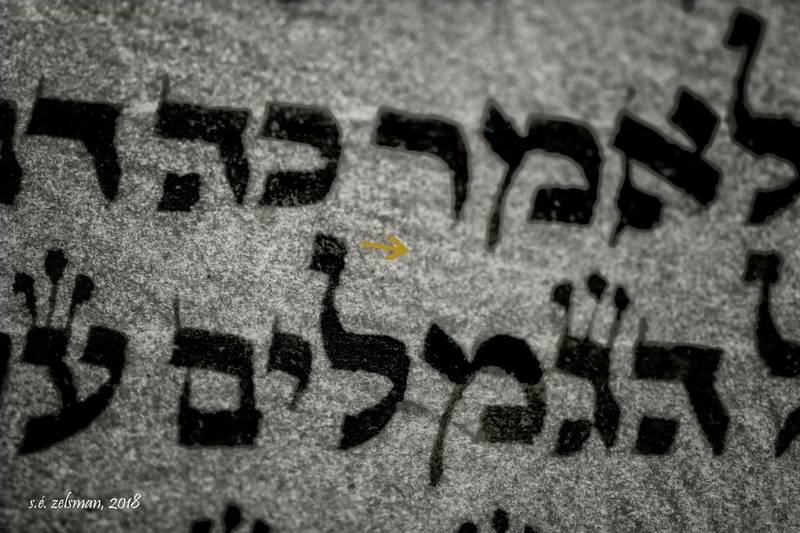
« sandpaper markings »
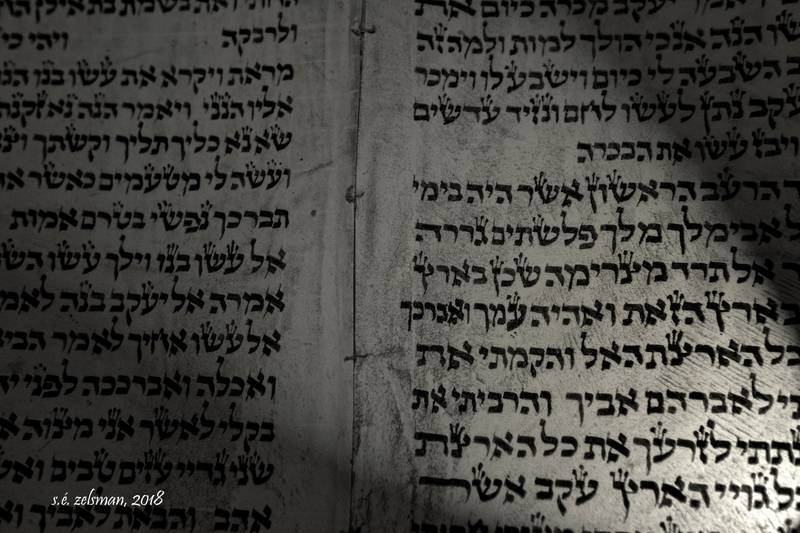
« sandpapering major repairs »
In the first photograph, the sandpaper marks are found in Genesis 24:30 (Chayei Sarah): « For upon seeing the nose ring, and the bracelets on his sister’s hands, and upon his hearing his sister Rebecca’s words, saying, “Thus has the man spoken to me,” he approached the man who was still standing by the camels by the spring. » The bolded and underscored words are visible in the photograph.
In the second photograph, the sandpaper marks are found in Genesis 26:1-7 (Toldot) where a famine occurs and Isaac goes to Abimelech, King of the Philistines.
Have you ever noticed that there are words in the Torah that have dots above them? Actually, there are ten verses in the Torah that have words with special dots on them. They are referred to in Hebrew as nekudot and called puncta extraordinaria (extraordinary points), using the Latin term. They were found in the Masoretic Text of the Hebrew Bible—the authoratative Hebrew and Aramic texts of the Tanach. Note the unusual flourish to these dots.
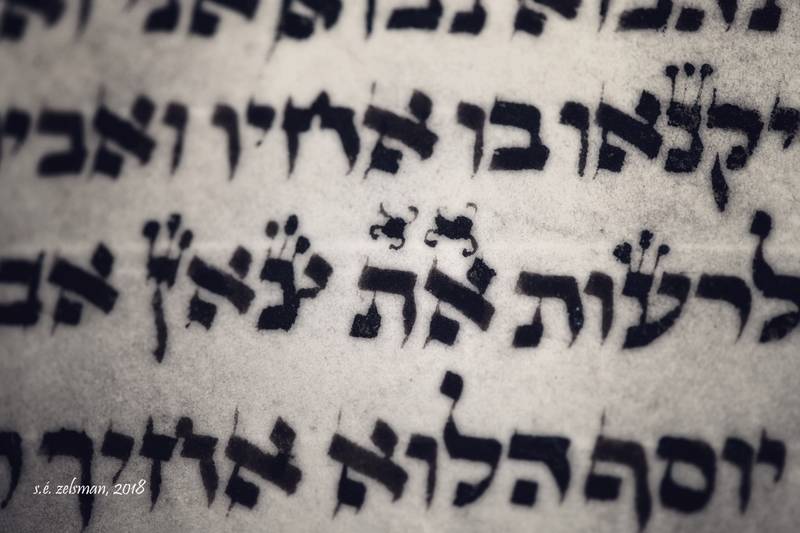
« puncta extraordinaria »
In the two photographs below, you see examples of tagin (crowns) on letters. In the first photograph, there is a tag on the letter samech and a flourish below. Once again, the purpose for this tag is no longer known. In current standards, only the letters in the sha’atnez getz group (mnemonic for shin, ayin, tet,nun, zayin, gimmel, and tzadi) have tagin. Samech, therefore, is not a letter for which a tag is written. It is rarely seen even in our Czech Torah. The tag was found in the word ha-seeru (discard): « So Jacob said to his household and to all who were with him, “Discard the alien gods that are in your midst; cleanse yourselves and change your clothes.” » (Genesis 35:2 (Vayishlach))
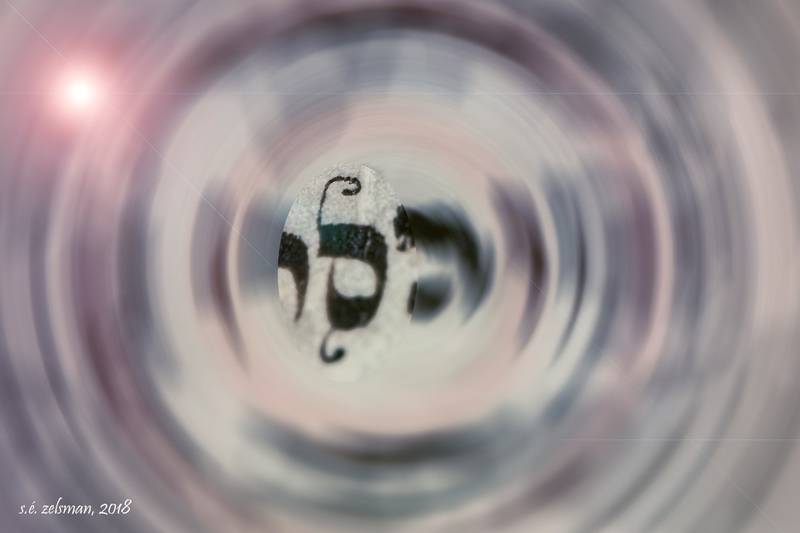
« unusual tag on samech »
In the photograph below, an embossing filter was added to make the image distinct. Here, the letter zayin has a flourish added to the tagin and there are tagin on the letters kaf and resh. Using the mnemonic described in the previous paragraph, do you see what is unusual? The word, vayizkor (remembered) is found in Genesis 30:22 (Vayetzei): « G-d remembered Rachel; G-d hearkened to her and He opened her womb. »
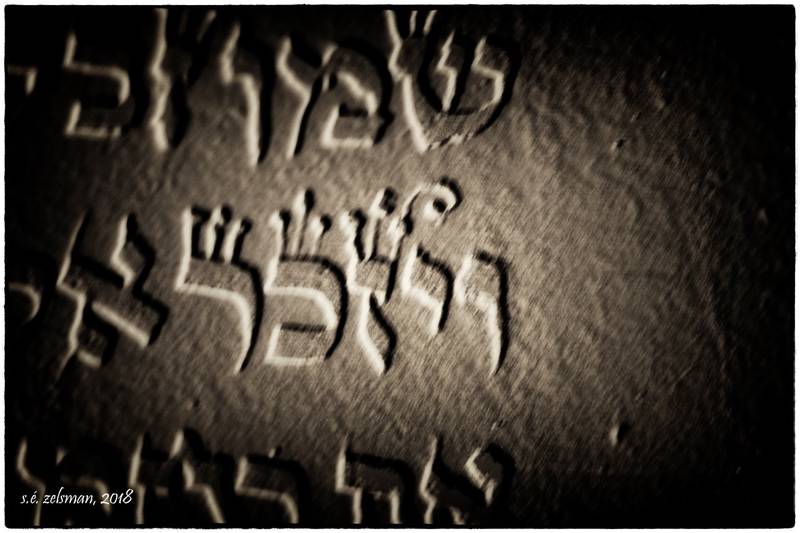
« unusual tagin »
The unusual tagin in both photographs are clues to the age of our Torah because they have not been used in hundreds of years.
This photograph shows another rare tagin put on the letter kaf. It is found in Genesis 49:33 (Vayechi): « When Jacob finished instructing his sons, he drew his feet onto the bed; he expired and was gathered to his people. » The word that is bolded and underscored is the word seen in the photograph with the tagin.
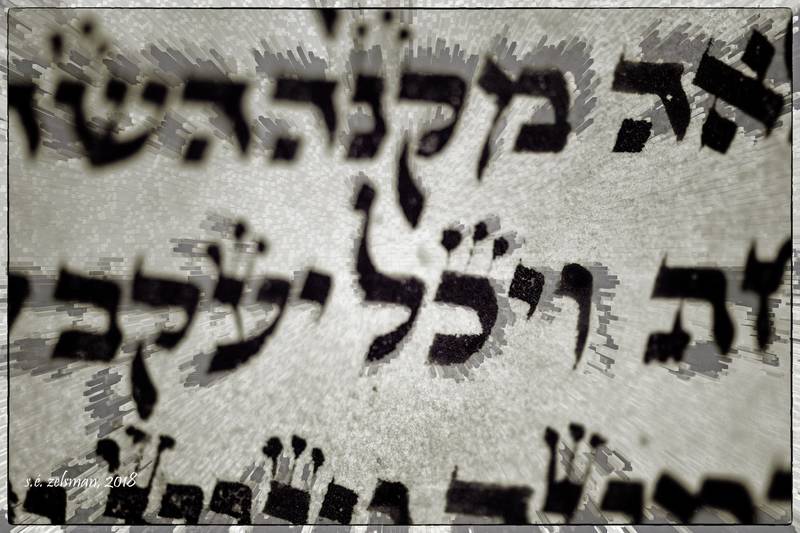
« kaf with tagin »
Look at the photograph below and the inset. The clever title uses the literary device of consonance to convey the message that the hole in the klaf (parchment) is not due to a mishap. Can you figure out why? Why was the hole in the klaf put there in the first place? Rabbi Zacks gives the answer below.
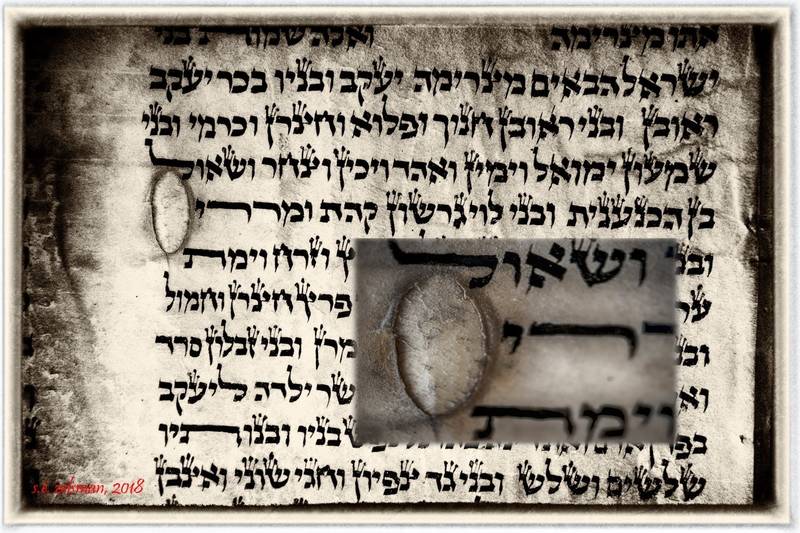
« pre-planned purposeful parchment piercing »
Rabbi Zacks explains that parchments were usually made in a tannery that was not Jewish because non-Jews used to have the monopoly on tanneries. However, the skins of animals used for a Torah scroll had to be prepared only by a Jewish person. This is because a verbal intent must be declared when making a klaf for a Torah, and only a Jewish person can do this. In order that there be no confusion between parchments—ones made by non-Jews for some other purpose, Jews would make some sort of sign on them to know which one was theirs. Sometimes, they would make a circle (hole), patched, sometimes a shape of a letter, and sometimes a crease; however, they would never write anything on the klaf. This hole is found in Genesis 46:10-12 (Vayigash): « Simeon’s sons: Jemuel, Jamin, Ohad, Jachin, Zohar, and Shaul, son of the Canaanite woman. Levi’s sons: Gershon, Khath, and Merari. Judah’s sons” Er, Onan, Shelah, Perez, and Zerha; but Er and Onan had died in the land of Canaan – and Perez’s sons were Hezron and Hamul. » The words that are bolded and underscored are the words that abut the hole.
Here, Rabbi Zacks explains that this is one such hole. The original sofer calculated letter spacing and sizing up to the hole on the three lines that meet the edge of the hole.
However, in the photograph below, you can see that a hole in the klaf was made by accident, requiring a patch to be put in its place. Rabbi Zacks explains that this occurred by the hard erasing of words in the area. It could have also been that the klaf was already thin in the area due to previous corrections. There are halachic rules for creating a patch. In general, you have to fit the word in the patch and all letters have to be surrounded by the parchment of the patch. This makes it challenging because it is hard to work in the patch since it is a smaller area.
The word in the patch is Bilhah—Rachel’s maidservant whom Rachel gives to Jacob because she was unable to bear children. The patch is found in Genesis 30:5 (Vayeitzei): « Bilhah conceived and bore Jacob a son. »
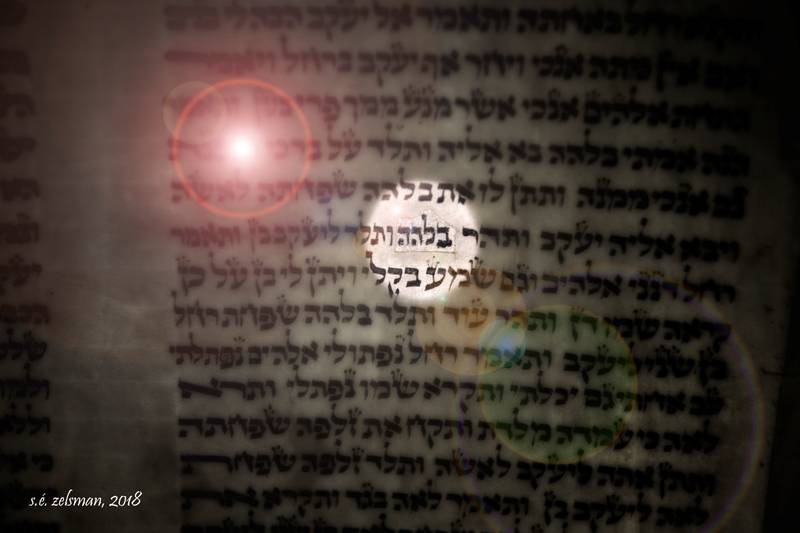
« a major repair: patch »
In every amud (page), the letters must be lined up properly; therefore, a sofer must calculate the space he requires. Sometimes, there is a miscalculation and the sofer writes letters outside the column. Rabbi Zacks explains that there are many halachic rules regarding the permissibility of writing letters outside the column. The insert in the photograph below shows the final letter chaf written outside the column. Rabbi Zacks explains that this was done by someone who had repaired the Torah. You can see that the letters are somewhat smaller than the original ktav; perhaps a word was forgotten and this word needed to be squeezed in. The word is found in Genesis 26:3 (Toldot) where a famine occurred and Isaac descended to the land of the Philistines where Hashem had directed him to go: « Sojourn in this land and I will be with you and bless you; for to you and your offspring will I give all these lands, and establish the oath that I swore to Abraham your father: » The bolded and underscored word is the one you see in the insert that extends past the column edge.
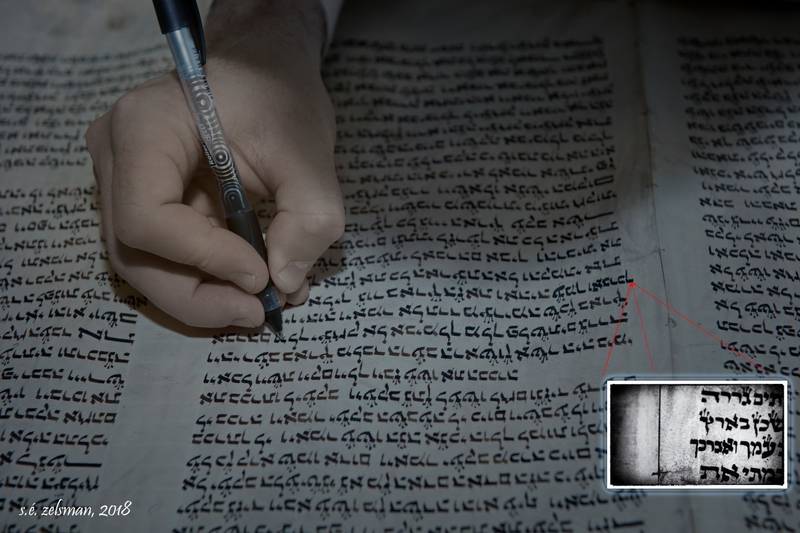
« letter outside of the column »
This article is the seventh in a series of short photo essays to help our community members see and learn with us. In the next article, we will be exploring applicable themes during the restoration of Shemot as our Magiah completes the work in Breishit. We welcome you in being part of the journey of the Czech Torah Restoration Project at Beth Emeth Bais Yehuda. Please contact the shul office at 416-633-3838.
June 26, 2018
חַיֵּי שָׂרָה
A Special Tribute
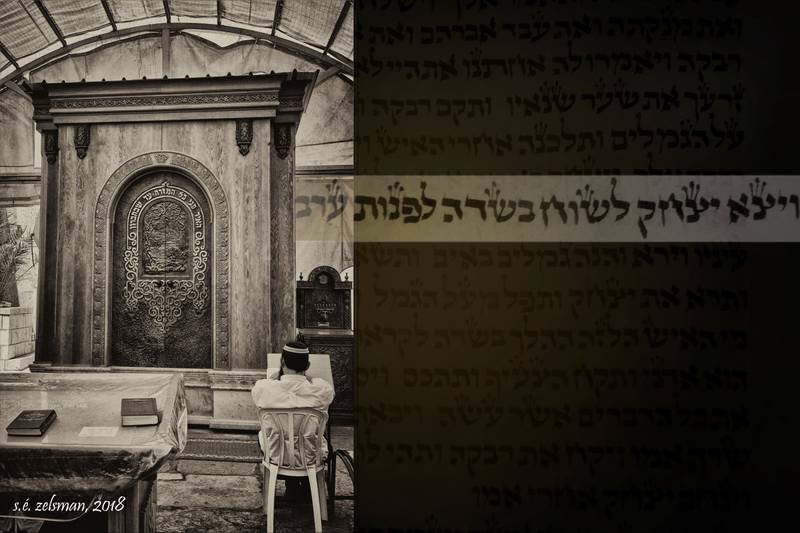
« and isaac went out to meditate in the field before evening » *
Of all the patriarchs and matriarchs, Sarah is the only one whose name forms part of a parsha title in the Torah. There are those who think it is ironic because the parsha, they claim, isn’t even about her. After all, in the opening lines, we just read of her death at the age of 127 years. Abraham purchases the Machpelah as a burial place, and then searches for a wife for his son, Isaac. After the marriage of Isaac and Rebecca, we read that Abraham marries Keturah, has more children, and dies at the age of 175. Isaac and Ishmael bury him in the Machpelah, and the parsha concludes with the generations of Ishmael.
But the parsha is always about Sarah, her life, her values, her kindness and goodness. This is found in Genesis 24:67: « And Isaac brought her into the tent of Sarah his mother; he married Rebecca, she became his wife, and he loved her; and thus was Isaac consoled after his mother. » The fact that the Torah states these two things tells us of Sarah’s importance. Is it not also possible that Isaac sees much of his mother’s goodness in Rebecca and that is why he was consoled? Furthermore, the Torah also states that it was the tent of Sarah; Abraham’s name is not mentioned. While we know that it was a tent belonging to both of them, referencing only Sarah elevates her importance. She is associated with the welcoming home—the welcoming Jewish home; she is associated with love and family.
But what is more profound is that the Machpelah, exists today—almost 4 000 years after its purchase by Abraham. Bought at full market price, it still fulfills its original purpose—a burial ground for the Patriarchs and Matriarchs of the Jewish people. The outside structure was built by Herod, King of Judea, some 2 000 years ago in a style to match the Second Temple. And while it is the second holiest place for Jews (after Temple Mount), it predates both Temples by thousands of years!
Over the centuries, our homeland has been conquered by foreign nations, forcing Jews to exile. Romans, Byzantines, Arabs, Crusaders, Mamelukes, Ottomans and finally the British conquered our land. During the War of Independence, the Jordanians illegally annexed Judea and Samaria, which included the Old City and Hebron where the Machpelah stands. Even with the liberation of Hebron in 1967, the Muslim Waqf still has control of the Machpelah and imposes many restrictions on Jewish prayers and customs. For example, at present, Jews have no access to Ohel Yitzhak—the rooms where Isaac’s and Rebecca’s cenotaphs are located, except for 10 days each year.
The Machpelah and Hebron are living proof of the denial to our homeland, the denial of full access to our holy sites, the incessant terrorist attacks on Jews and Israel; the hypocritical resolutions against Israel, the vitriolic worldwide antisemitism and global anti-Semitic movements. Our Czech Torah is living proof of the very same thing during one of the most inhumane and catastrophic events of world history and Jewish history which is the Holocaust.
This article attempts to capture in photographic imagery that very same connection between the Machpelah and our Czech Torah.
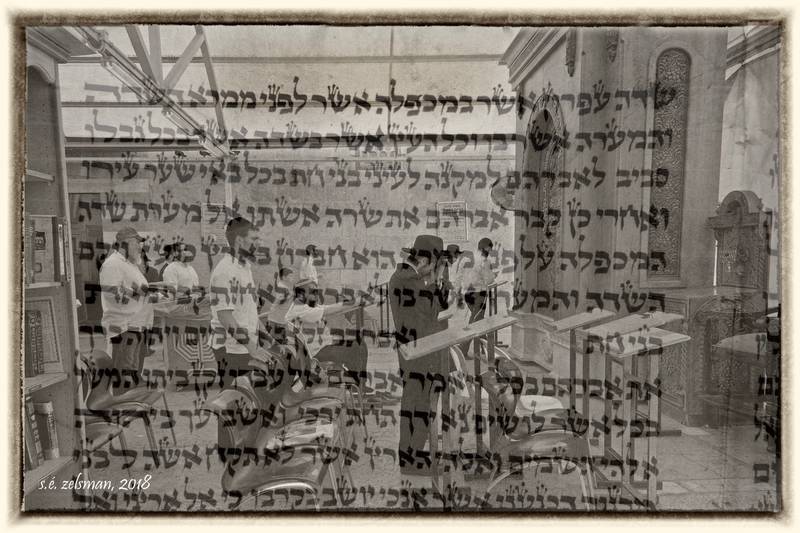
« tefillot at the machpelah »
The photograph shows the text of the Torah (Genesis 23:17): « And Ephron’s field, which was in Machpelah, facing Mamre, the field and the cave within it and all the trees in the field, within all its surrounding boundaries, was confirmed. » The text is superimposed over the sanctuary in the Machpelah where men are davening. The imagery conveys the connection of the Jewish people to the Machpelah and to Hebron where Jews have lived for thousands of years. In fact, Hebron was the first capital city of Israel established by King David. One of the most popular times to visit Hebron is Shabbat Hebron—the weekend of Parshat Chayei Sarah where thousands come to be in the city the parsha mentions. At this time, the Ohel Rivkah and Ohel Yitzhak are open to Jewish visitors.
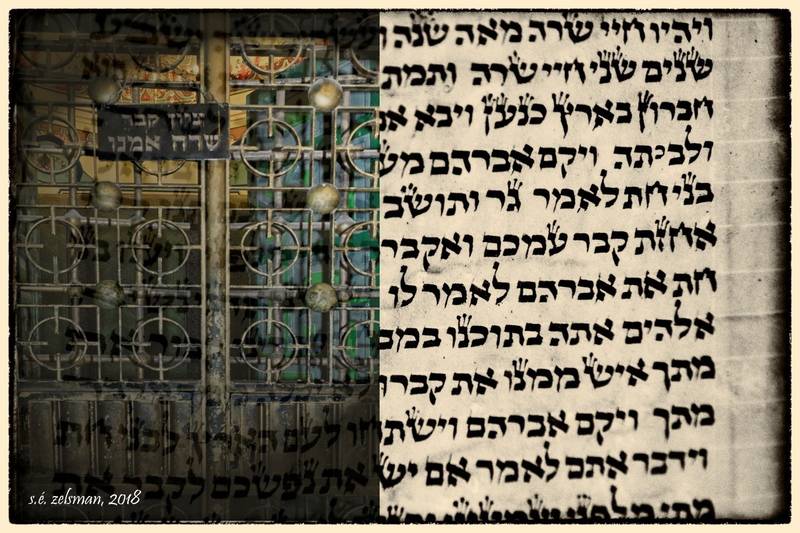
« ohel sarah »
The Torah text is at the beginning of Chayei Sarah in our Czech Torah. The gates that lock the room where Sarah’s cenotaph stands have been superimposed on our Torah text. The Torah is brought to a tangible reality by the superimposed image. The Machpelah, mentioned thousands of years ago, stands today and it reminds us of our history, who we are and our covenant with Hashem. Just as we safeguard the Machpelah today in Hebron, our faith and our history, so do we safeguard our Czech Torah like the Jewish community of Prague had done.
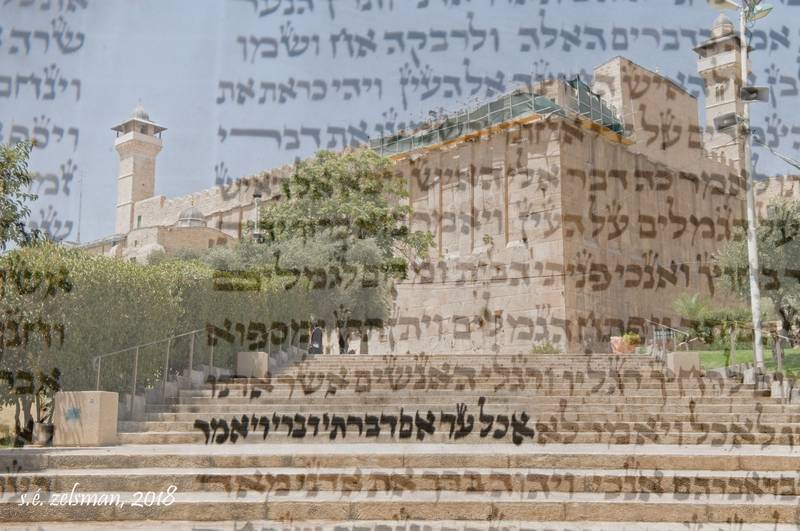
« The Machpelah »
The fourth aliyah of Chayei Sarah in our Czech Torah is transposed over a photo of the Machpelah. After Abraham buries Sarah, he sends his servant to find a suitable wife for Isaac with the promise that the servant would not take a Canaanite woman, but one from his native land of Amram. The servant sets out to Aram and asks Hashem for a sign to confirm his choice of woman. He receives a sign that it is to be Rebecca who is Abraham’s great-niece. In the fourth aliyah, Rebecca tells her family about the man, and her brother, Laban, come to greet the servant. The servant tells Laban about his mission and the sign from Hashem he received. So important to him was the mission that he refused to eat the food they offered him until he expressly told the family why he had come and why Rebecca was chosen. The facade we see of the Machpelah in the photograph reminds us of the beginning of our history and of our covenant with Hashem where on this spot, our forefathers and mothers were buried. This is the spot where we can trace our roots. Restoring our Czech Torah connects us to the members of the Jewish community of Prague who, despite the imminent destruction, protected Torah scrolls that are living documents of our roots.
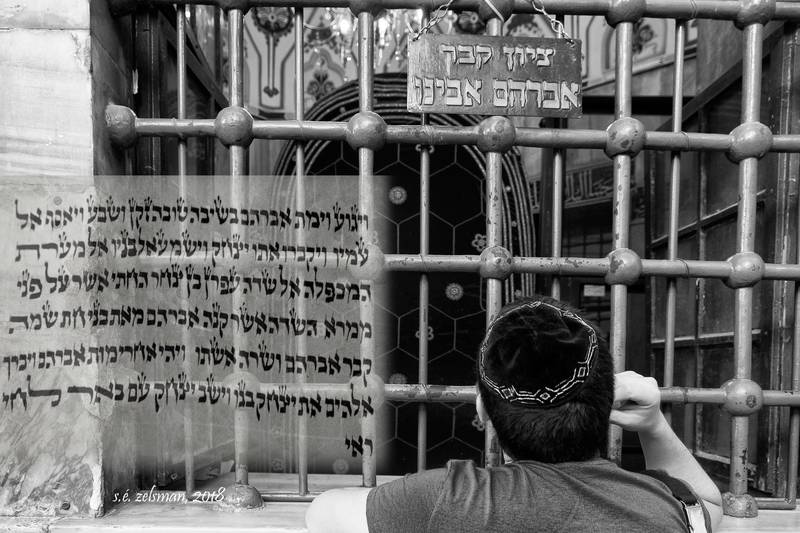
« ohel avraham »
A person stands in contemplation, gazing at the cenotaph of Abraham at the Machpelah. The superimposed Torah text from our Czech Torah tells us about the death of Abraham and his burial in the Machpelah, and emphasizes that the Machpelah was purchased from the Hittites and it is where Abraham and his wife, Sarah, are buried. This emphasis reminds us again about Sarah’s importance because of her genuine character, her kindness and her values all that become our true Jewish values. One can’t help but stand in this spot and reflect upon one’s Jewish history both personal and collective, from toraitic time to the present. In such a personal reflection, one must feel a connection to the Jewish community of Prague who ensured the preservation of our heritage.
* « and isaac went out to meditate in the field before evening: » In this photograph, a man was quietly reading from a siddur in the sanctuary at the Machpelah during the afteroon. The verse from the Torah is translated as, « And Isaac went out to meditate in the field at the eventide. » It is from this that Sages deduce the Minchah prayer—one of the three daily prayers we are obligated to perform.
---
This article is the sixth in a series of short photo essays to help our community members see and learn with us. In the next article, we read an article on the last curious findings during the restoration of Breishit. After that, we will be exploring applicable themes during the restoration of Shemot. We welcome you in being part of the journey of the Czech Torah Restoration Project at Beth Emeth Bais Yehuda. Please contact the shul office at 4166333838.
June 18, 2018
Rewriting History and More Torah Mystery
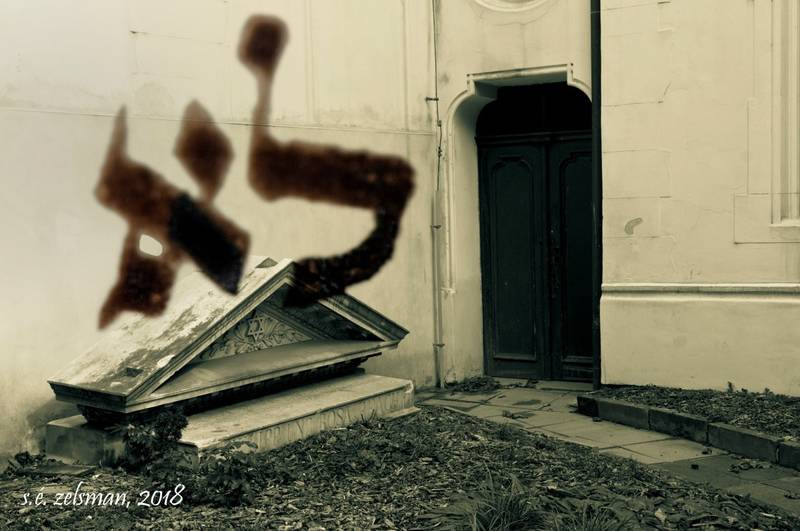
« rewriting history »
Take a good look at the above photograph. Why do you think the title of the photograph is appropriate?
The Hebrew word for no (לא). The techniques used by the Magiah to correct letters. Oxidation of letters. Prague. The Czech Torah Network. Our Czech Torah. Things that make a Torah pasul (invalid). Do these clues which were all described in the previous four articles help you? Knowing that the word was photographed from Genesis 32:29 in our Torah and knowing it is part of a Hebrew expression, would that help you?
Let’s explain. If you look at the two letters, the reddish brown parts are from the ink of the original letters which have oxidized over time. The dark part is where a previous repair with a different ink was made a long time ago. This is especially visible in the aleph. But notice that the left regel (leg) of the aleph has two hooks connected to the diagonal part of the letter. This was an error done by the original sofer. It is an error that is over three hundred years old, may never have been noticed and was never changed. Even when a repair was done some time later, it still was never fixed! One might quip that our Magiah, by changing the letter, is rewriting history—the history of our Torah; however, our Magiah, with a smile, says that he is « correcting history! »
But there is more imagery in the photograph to make the title appropriate. In Genesis 32:29, which is parshat Vayishlach, we read of the imminent conflict between Jacob and Esau where Hashem sent an angel to save Jacob. In verse 29, we read that the angel, after asking Jacob his name, said to him, « No longer will it be said that your name is Jacob, but Israel, for you have striven with the Divine and with man and have overcome. » The Hebrew for no longer (in verse 29) is לא עוד where the error was found. The Jewish community of Prague strove to safeguard over 1500 Torah scrolls and other Jewish artifacts, and while most of them perished in the Holocaust, they did succeed in rewriting the history of Jews that the Nazis attempted to create. Such is the success of the Czech Torah Network—a « non-profit organization that has been formed to educate congregations and their members about the sacred Czech Torah Scrolls which were taken by the Nazis from Jewish synagogues in Bohemia and Moravia. » (The Czech Torah Network, A Holocaust Education Project, 2003, About Us, para. 2) By restoring this Torah, we at BEBY are also ensuring that the wish of the Jewish community of Prague is fulfilled and maintained.
Moreover, the background image in split-level toning is a photo of a broken headstone which is now resting in the Jewish Quarter of Prague. It reminds us that Jews will always survive, and while there are still nations and groups of people in the world who wish to destroy us, we say a defiant לא עוד !
In order to preserve the artifact, here is a photograph of the original letter untouched.
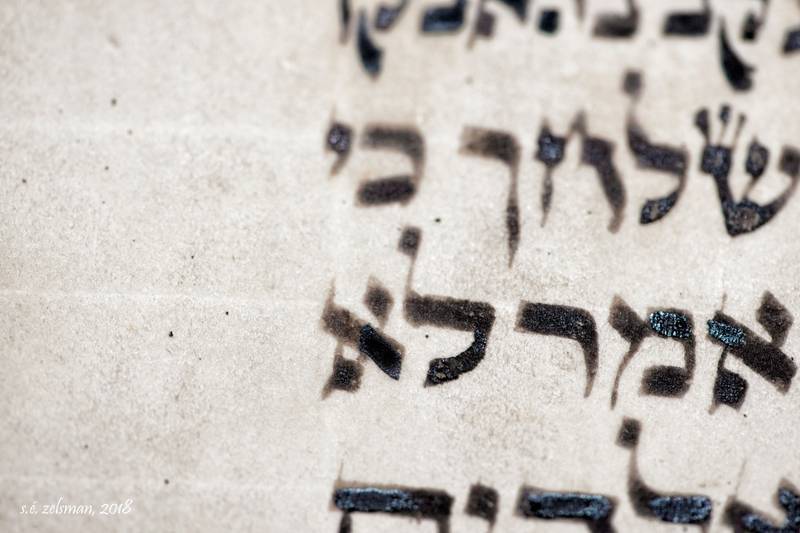
« original error: genesis 32:29 »
A macro lens was used to exact the details of the letter. In order to make the Torah kosher, the aleph had to be removed and rewritten in its entirety.
Here is the corrected letter.
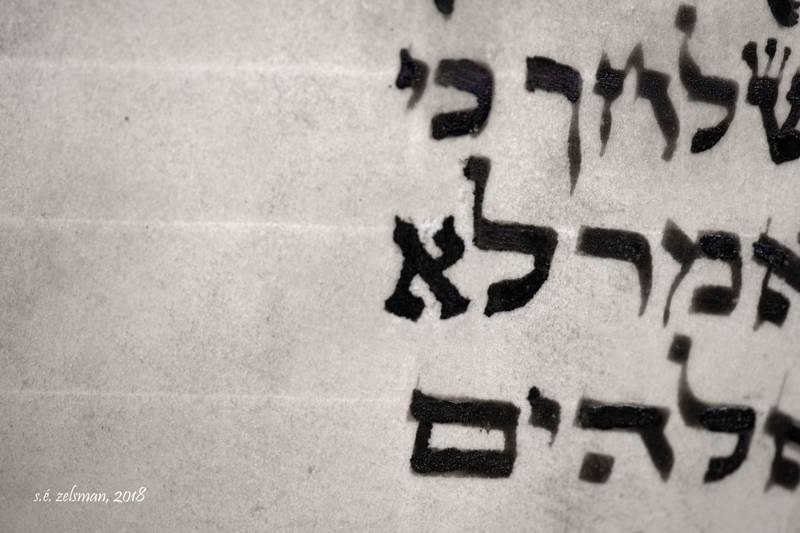
« original error: genesis 32:29, corrected »
Oddly enough, our Magiah found another error made by the original sofer which was left untouched. To effect the correction, the Magiah was able to scrape the ink away between the two letters. The verse where the error is found is Genesis 34:24 (Vayishlach): « All the people who depart through the gate of his city listened to Hamor and his son Shechem, and all the males—all those who depart through the gate of his city—were circumcised. » The two words bolded and underscored in the verse are the two connected words in the photograph.
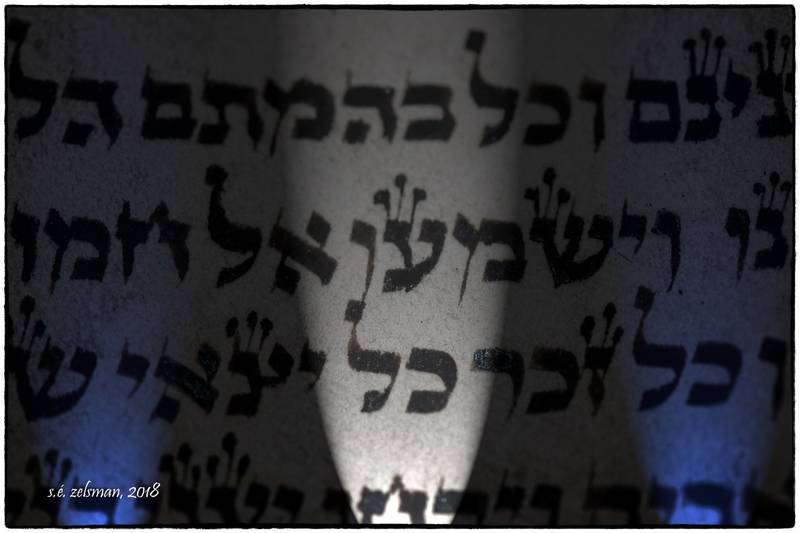
« original error (genesis 34, 24) »
The photograph below shows a juxtaposition of the original error beside the correction. The Magiah had to scrape away just enough of the letter to create a space. He also noted that the ‘vav’ is somewhat elongated to begin with; however, he did not alter it in order to maintain the original style.
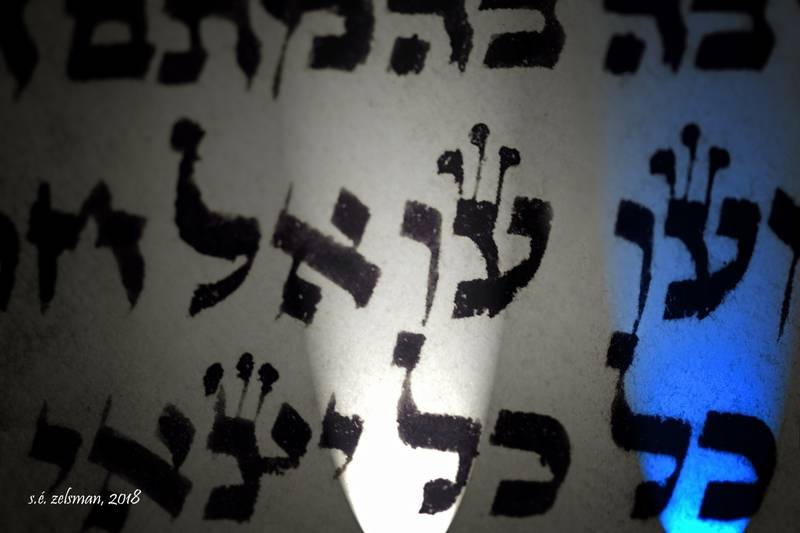
« original error (genesis 34, 24), corrected »
It is the two photographs below that reveal a very peculiar object discovered in our Torah. There appears to be a stamp mark with blue lettering at the bottom of the klaf (parchment). However, the Magiah cannot make out what is stamped. We can see a backwards e, an upside down and flipped e and an ö. Our Magiah thinks that a hole in the parchment was patched with another piece of parchment. A clamp would have been used to press down on the patch to ensure that the glue adhered. A piece of paper or something with writing was put in between the clamp and the patch in order to avoid damaging the patch itself. This something probably had words on it and the blue lettering seeped onto the patch. Our Magiah assures us that this does not make the Torah pasul.
If you are able to discern what the lettering in the stamp mark is, please let us know and help us shed light on this mystery. The verse in the Torah above the stamp is Genesis 31:24 (Vayetzeh): « But G-d had come to Laban the Aramean in a dream by night and said to him, “Beware lest you speak with Jacob either good or bad. » The bolded and underscored words in the verse are visible in the photograph.
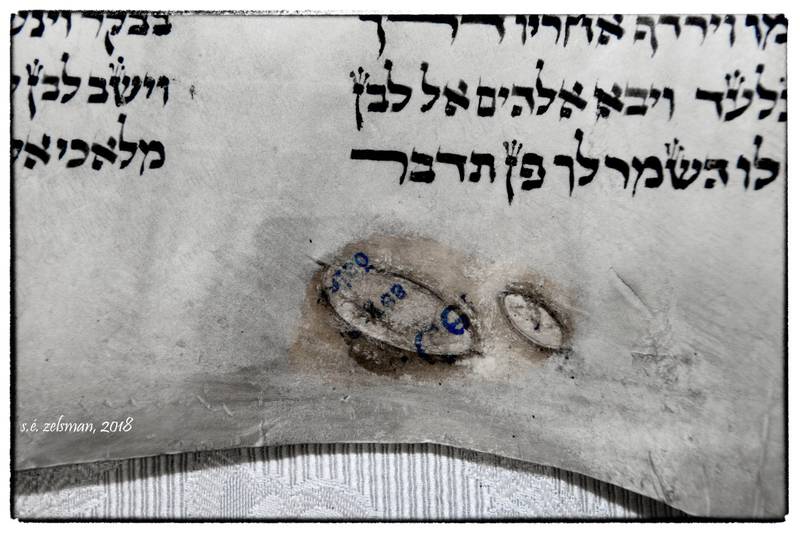 « unusual stamp »
« unusual stamp »
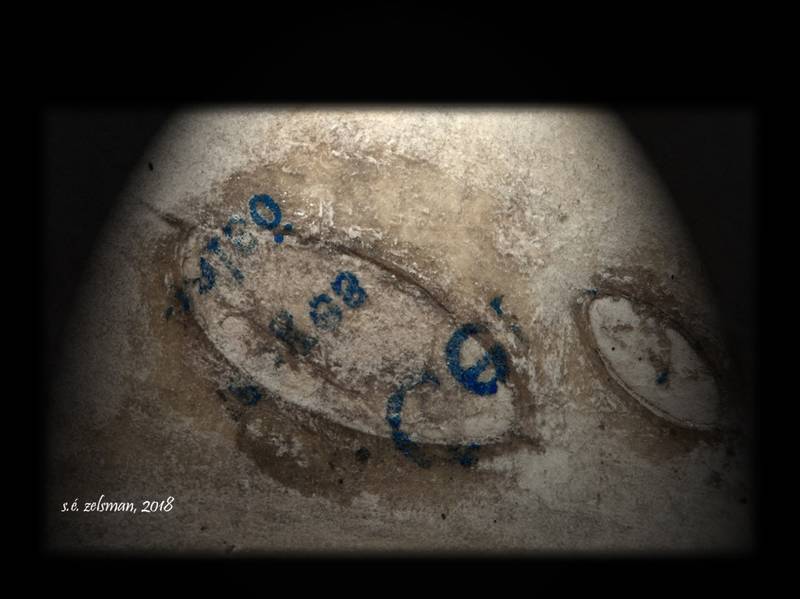
« unusual stamp (enlarged) »
On several amudim (pages), we find splotches of candlewax that dripped onto the klaf (parchment). Given the age of our Torah, it would have been in living use before electricity. In the photograph below, you can see wax drippings in orange. The Torah text is Genesis 33:18-19 (Vayishlach): « Jacob arrived intact at the city of Shechem which is the land of Canaaan, upon his arriving from Paddan-aram, and he encamped before the city. He bought the parcel of land upon which he pitched his tent from the children of Hamor, Shechem’s father, for one hundred kesitahs. » The bolded and underscored words in the verse are the two you see here in the photograph.
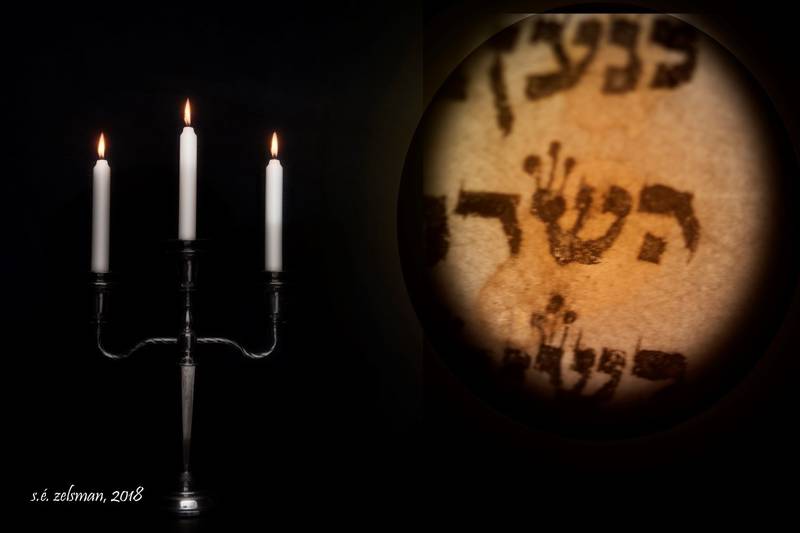
« Shabbat Mincha »
The photograph is aptly titled. It conveys imagery of our Torah being read centuries ago during the Mincha service on Shabbat. Since electric lights had not been invented when this Torah was first written, there would not have been insufficient daylight in the shul and candles would be needed to illuminate the sanctuary for the Torah reading.
This article is the fifth in a series of short photo essays to help our community members see and learn with us. We welcome you in being part of the journey of the Czech Torah Restoration Project at Beth Emeth Bais Yehuda. Please contact the shul office at 416 633 3838.
Stay tuned for more Torah mysteries as exciting things about our Torah are being discovered during the restoration. And be sure to watch for a special tribute to parshat « Chayei Sarah. »
June 8, 2018
Restoration Challenges
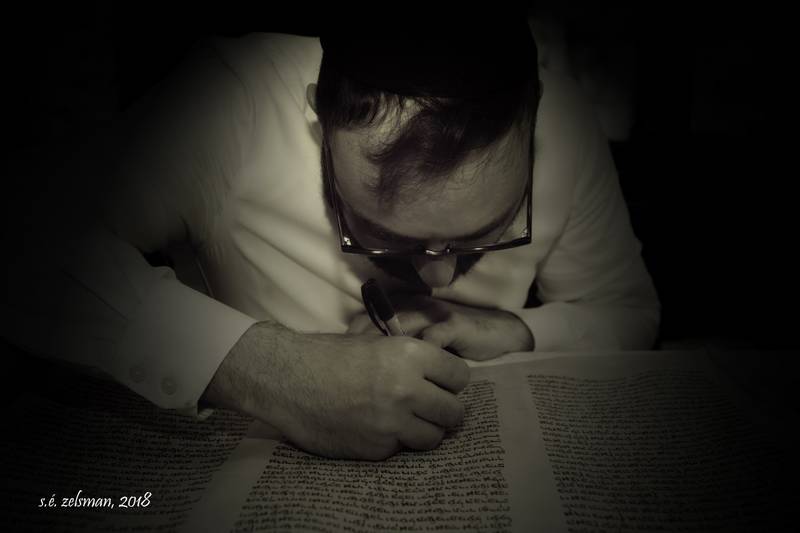
« precision in technique » *
As the Magiah repairs our Torah, he checks everything line by line, carefully examining each letter one at a time, looking for the most minute details that could render the letter pasul (invalid). If a letter is pasul, then the whole Torah is pasul and cannot be used. Incidentally, we indicate that a Torah is pasul by putting the garter on the outside of the mantel.
The challenges facing our Magiah are many. First, he is working with a ktav (script) that is very old, unique to one region only and has not been used for over a hundred years at least. Therefore, when he corrects a letter, he must match the style of the original ktav. The Magiah explains that he wants to keep the originality of our Torah as much as possible, which is why the repair work is so intricate. But there are more complications. Our Torah, given its age, has had repairs done by other soferim/magi-im who were not attentive to the original ktav, and this is clearly visible now. Because of this, the Magiah has to make repairs in such a way that the ktav maintains a harmonious appearance. Moreover, the Magiah has found old repairs that hadn’t been made correctly; therefore, he must repair the repair!
Repairing older repairs poses other complications. The Magiah has discovered places in our Torah where a previous sofer/magiah used sandpaper to remove letters or even words. As a result, the klaf (parchment) in these areas has become worn, thin, and is often rough. When the klaf is worn or thin, the Magiah has to be extremely careful not to pierce the klaf with either his pen or the scalpel. Certainly, the traditional use of a reed or quill would make repair work on worn/thin areas impossible because the reed or quill would pierce the klaf. In addition, when the klaf is thin or rough, the ink bleeds easy and smudges the letter which would make the Torah pasul.
Another complication is the ink that previous soferim/magi-im have used. The quality was inferior, and as a result, it sometimes cakes when the Magiah uses his pen. This makes it difficult for the new ink to affix. Also, the cakes have to be removed because they can stick together, making improper letter shapes. They can also coagulate between letters thereby connecting them. All of this would render the Torah pasul.
In parshat Toldot, for example, there were amudim (pages) where the klaf was so thin that the repair of the amud (page) took over 3 hours.
But all of these things shed a tiny bit of light on, and assuredly, raise questions about the life story of our Torah. Questions such as why were some letters written with specific tagin (crowns), why was the original ktav not maintained when repairs were done, who made the repairs, did this Torah move around to places where Bohemian style was not used, and how did it happen that significant repairs of entire lines needed to have been made will never be answered.
This article is the fourth in a series of short photo essays to help our community members see and learn with us. We welcome you in being part of the journey of the Czech Torah Restoration Project at Beth Emeth Bais Yehuda. Please contact the shul office at 416 633 38 38.
Stay tuned for an upcoming article entitled, « Rewriting History and More Torah Mystery » as singular exciting things about our Torah are discovered during the restoration. And watch for a special tribute to parshat « Chayei Sarah. »
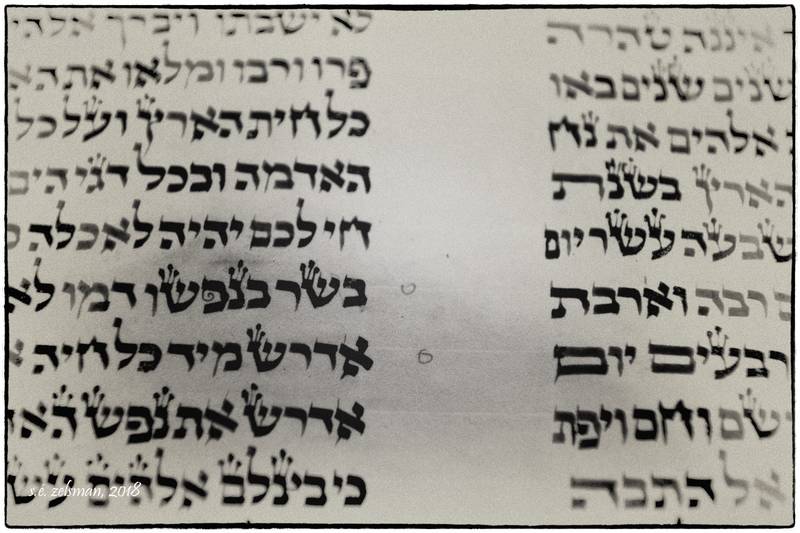
« old repair markings »
Notice the two circles in the middle of the photo. Rabbi Zacks, our Magiah, explains that a previous sofer/magiah wrote the circles to indicate where significant repair will need to be done in the future.
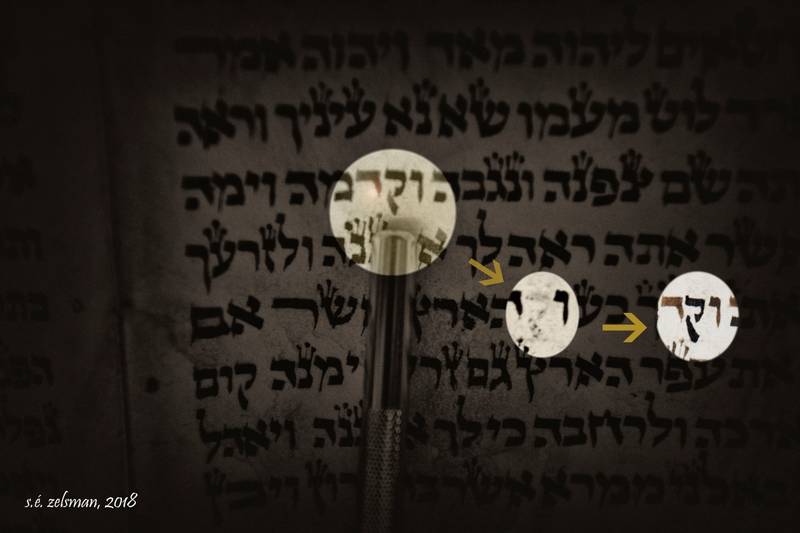
« repair of ‘ kuf’ »
In this image, you see the stage of the repair of a kuf pasul. The illuminated top left circle shows that the regel—leg of the kuf is touching the top part of the letter which makes the letter invalid. Rabbi Zacks explains that halachically, one cannot just scrape a space away; one must rewrite the whole letter. In the middle illuminated circle, you see the space created after he carefully scrapes the ink. In the far right illuminated circle, you see the newly corrected letter written proportionally in the space.
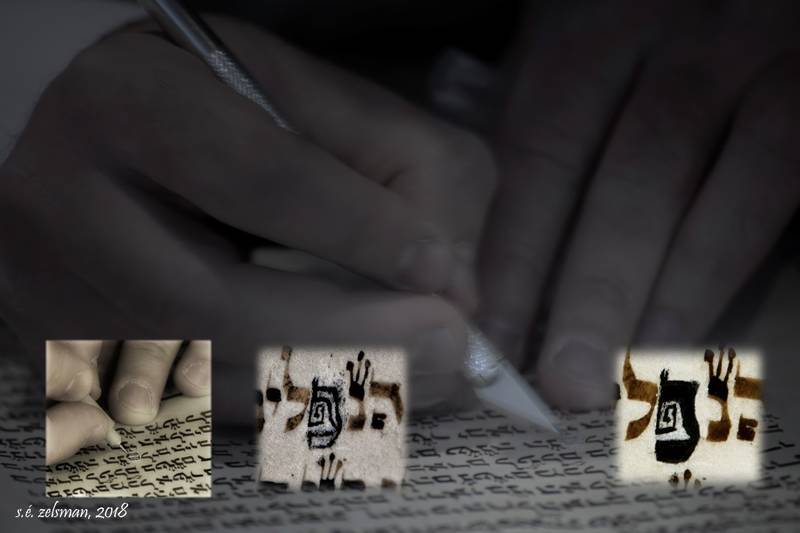
« correcting the ‘pei lefufa’ »
This photo shows the steps Rabbi Zack was required to take in order to correct a letter pei that was pasul. The challenge here was that the original sofer used the pei lefufa style—the flipped letter pei inside. This style has not been used for over a hundred years. The background image shows Rabbi Zacks scraping the letter with his scalpel. In the far left inset, the image shows Rabbi Zacks creating the correct contour of the letter to be created. The middle inset shows the completed contour. The far right inset shows the completed letter now restored.
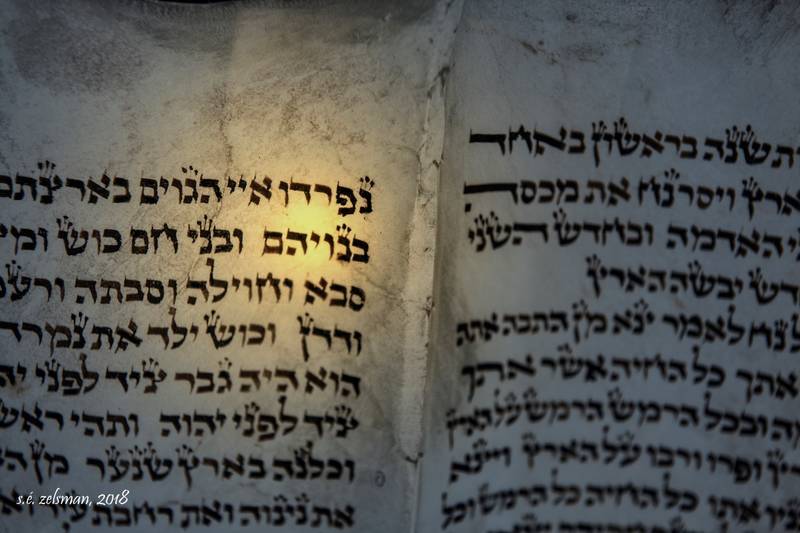
« error and influence »
Here are 2 challenges for you. See if you can spot the error that needed to be corrected, and see if you can spot the Sephardi influence in the original ktav. The answers are found below.

« error (corrected) and influence »
The correction made was to the first word in the second line of the amud (page) on the left. The second letter was a ‘nun’, but it is supposed to be a ‘gimmel’ because the correct word is, ‘b’goyeh-hem.’ How is it possible that such an error was made? Rabbi Zacks explains that it is possible that the error was made by the person who had effected a repair to the spot because it appears that there has been some restoration done. That person may have written the wrong letter, or it is possible that the ink smudged and made the ‘gimmel’ look like a ‘nun’.
Did you notice the Sephardi influence in some of the letters ‘lamed’ and ‘nun’ on this amud (page)?
Look at the image on the next page. It is an enlarged image of the incorrect letter. Do you agree with Rabbi Zacks or do you have a different thought?
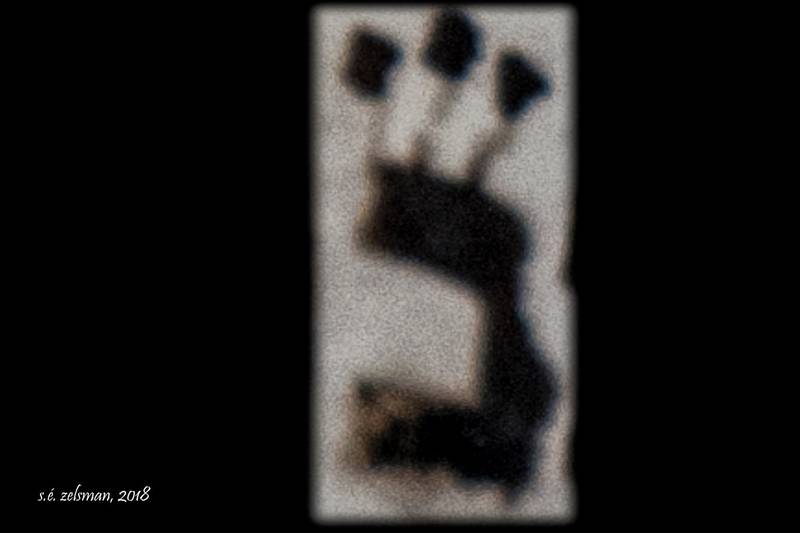
« incorrect letter »
For your reference, the correction was made on the word found in Genesis 10:5 where the descendants of Noah are mentioned.
* « precision in technique: » While Rabbi Zacks was working one day, he suddenly moved his hand, curved it and cupped it inward and then continued to make corrections to letters. This positioning of his hand appeared to be awkward and cumbersome. He explained that it was necessary at times to place his hand this way in order to avoid smudging letters and getting blots of caked ink on his hand. Caked ink on his hand could be dragged across the klaf or alter the shapes of letters, rendering them pasul.
June 5, 2018
The Restoration Begins
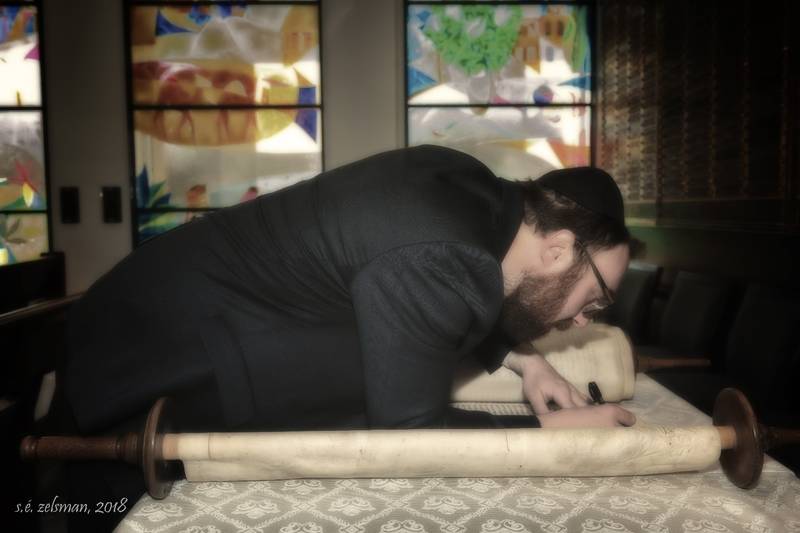
« the magiah »
On April 23, 2018, the repairs on our Czech Torah began. Rabbi Zacks explained that the goal of restoration was to make the Torah kosher so that we can use it, but to keep the Torah original. He would repair letters in the original ktav where possible, and not write over every letter so that the antiquity appearance and feel would be lost. If a letter has been oxidized and faded, for example, he would leave it as long as it adheres to halachic requirements.
As the restoration is unfolding, many things are coming to light about our Torah and the life cycle of Torah scrolls. We have already discussed our Torah’s singular style of ktav in the previous articles, but over the next articles, we will learn about mysteries of previous repairs that we are noticing and how Rabbi Zacks painstakingly and meticulously ponders the intent not only of the original sofer but of the soferim who made corrections. In this way, he can make repairs that keep our Torah in its present state and not disturb its history.
Our Czech Torah has a life cycle story that we do not know other than it is over 300 years old, was catalogued and stored by the Jewish Community in Prague in 1942 in the hopes that they would be preserved from the Nazis and brought back to life when the Nazis fell. Given that it is over 300 years old, it would have been in existence since the 1700s. To give you a sense of events that unfolded during the life of our Torah, here is a brief timeline of April 23 occurrences:
Apr 23, 1789: President-elect George Washington moves into the first executive mansion— The Franklin House in New York
Apr 23, 1791: James Buchanan, 15th US president was born
Apr 23, 1850: William Wordsworth, English poet, died
Apr 23, 1851: Canada issued its first postage stamp, the Three-Penny Beaver on Apr 6, 2018, a three penny beaver stamp with a cancelled stamp mark sold for 1035 $ at an auction
Apr 23, 1891: Jews were expelled from Moscow
Apr 23, 1928: American actress, Shirley Temple Black was born
Apr 23, 1936: Roy Orbison was born
Apr 23, 1938: Germans in the Sudetenland of Czechoslovakia demanded self-government
Apr 23, 1941: The Greek army surrendered to the Nazis
Apr 23, 1942: Bombing of Exter by the Luftwaffe
Apr 23, 1945: Liberation of the Flossenburg concentration camp Soviet Army fought its way into Berlin
Apr 23, 1954: Hank Aaron hits his first home run
Apr 23, 1956: US Supreme court ended race segregation on buses
Apr 23, 1969: Sirhan Sirhan was sentenced to death for the assassination of Senator Robert Kennedy; however, the sentence was later reduced to life imprisonment
Apr 23, 1986: Otto Preminger, Jewish Austrian actor/producer/director who fled Austria before WW II, died
Apr 23, 1987: Chrylser buys Lamborghini
Apr 23, 2000: King Abdullah II of Jordan made his first state visit to Israel
Apr 23, 2001: Bomb blast near Tel Aviv injured 4 people; this was the 3rd bomb blast in 2 days
Apr 23, 2003: WHO (World Health Organization) added Toronto to its list of places to avoid because of SARS
Apr 23, 2014: PA and Hamas sign agreement to create a Palestinian unity government
This article is the third in a series of short photo essays to help our community members see and learn with us. We welcome you in being part of the journey of the Czech Torah Restoration Project at Beth Emeth Bais Yehuda. Please contact the shul office at 416 633 3838.
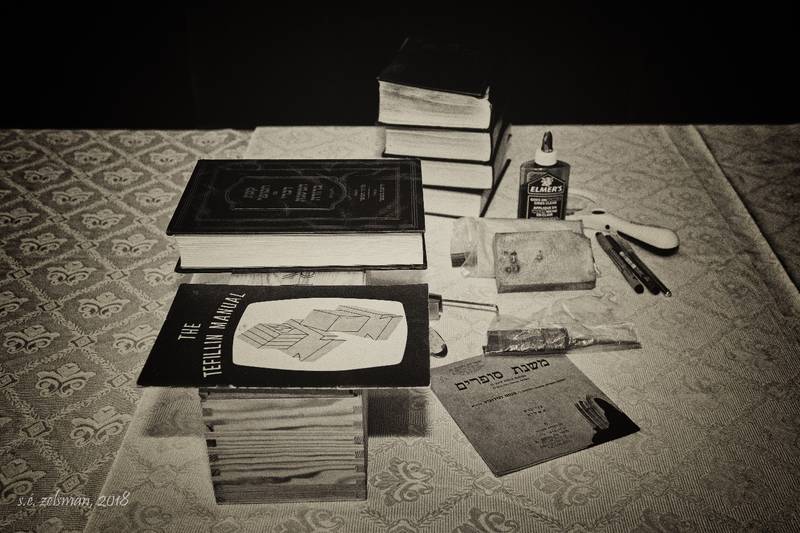
« the magiah’s tools »
The photograph shows the tools and sources that the magiah uses when repairing a Torah. These include pens, a scalpel, sandpaper, ink and printed resources to consult with respect to halachic practices.
A question arises regarding the use of a pen as opposed to a quill or reed. Rabbi Zacks explains that pens became common practice as early as the 1840s. Also, the writing that he is doing is repairing and not writing fresh. The pen is better to suited to write over letters where necessary and makes it easier to avoid puncturing the parchment. When one is repairing, one is trying to make sure that the repairs are maintained for a long period.
Rabbi Zacks explains that Rambam stated that ink must be black. The ink that is used in repairing is a carbon based ink. It is synthetic, jet black and will stay better on the parchment than the ink used to write the Torah itself, which, over time, can crumble. Carbon based ink is also easier to write over the existing ink.
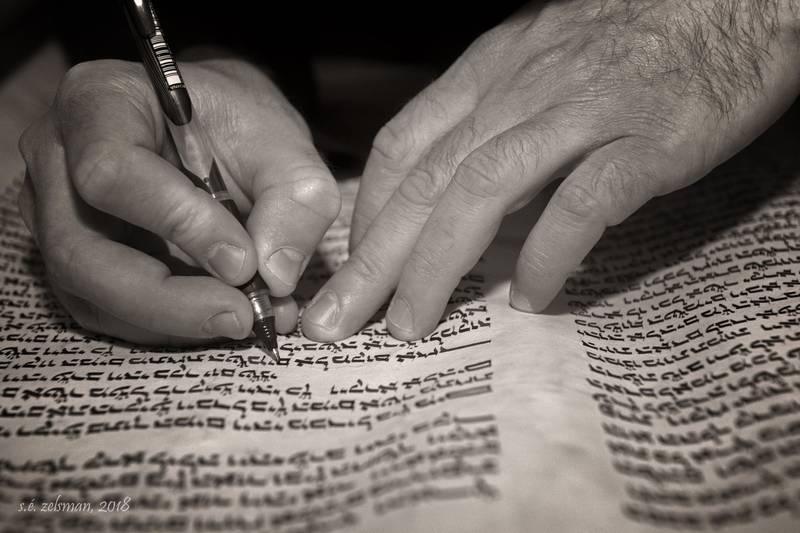
« correcting a letter »
Given the age of the Torah, the ink may have flaked away, leaving a letter not fully intact. A pen is used to fill in empty spaces, reshape a letter, or as will be seen in future articles, to rewrite a letter entirely.
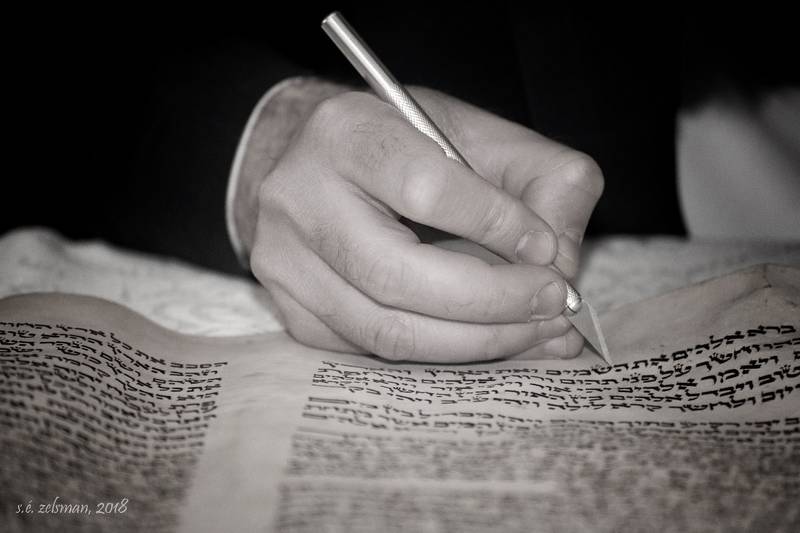
« correcting spacing »
Letters must not touch; klaf (parchment) must be around every letter. Here, our Magiah uses a scalpel to scractch out an area where two letters are touching. He must be very careful as to not alter a letter’s shape and, chas v’chalila, puncture the klaf.
What can cause letters to touch? It could be something so fine as a smudge from the original ink when the sofer was scribing the Torah or a blot from the ink spreading. Rabbi Zacks often uses a magnifying glass because the connections can be so minute as to be barely visible to the naked eye. Even if the one of the strokes in the tagin are touching each other, they must be separated.
Sometimes, an entire letter needs to be scratched out and rewritten. Sometimes, it’s a whole word or group of words. We will see examples in upcoming articles.
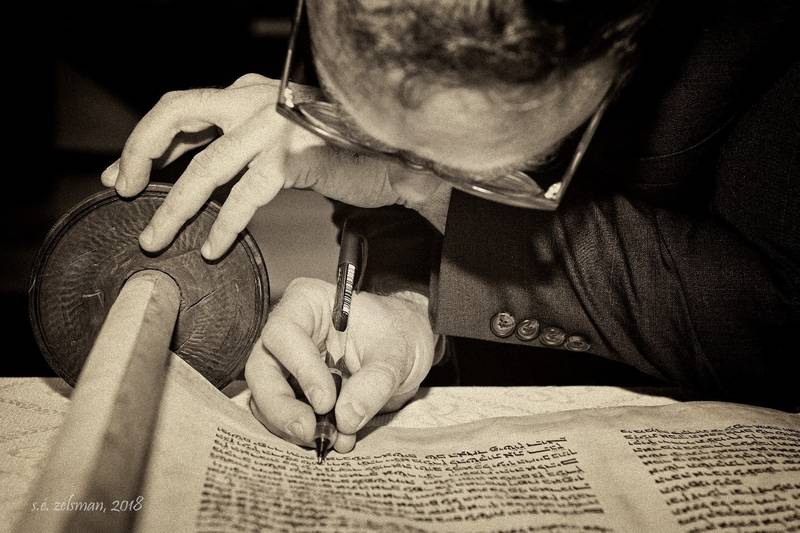
« correcting letters »
Word by word, line by line, the Magiah examines, corrects and repairs to ensure the Torah is kosher.
May 25, 2018
A sefer Torah contains precisely 304, 805 Hebrew letters in a special script (ktav), all following a myriad of halachic rules where the major halacha are found in the Talmud and the Masechet Soferim (The Tractate of the Scribes). The letters are in Ktav Ashurit, and we note differences in calligraphy; for example, the calligraphy differs between Ashkenazi and Sephardi Torah scrolls. There are also differences in the writing implements used. An Ashkenazi scribe (sofer) will use quills whereas a Sephardi sofer will use reeds.
Beresheit - May 15, 2018
« naděje na návrat » (hope for return)*
 |
| Pei lefufa |
A Torah gives clues to its approximate age. Rabbi Zacks explains that our Torah shows wear of the parchment—browning from age and oxidation of the letters. More significantly, the Halachic style used in this Torah predates the standardized style of writing. In fact, it predates the Keseth Ha’Sofer—one of the earliest codifications of lettering. There are certain letters that do not align with any other script. For example, this Torah uses certain techniques (Pei lefufa—flipped (inside)) that are commonly found in Torah scrolls coming from this region. You find these techniques on Torah scrolls of this age or even older. Moreover, there are areas in the Torah where repairs have been done—not by the original sofer. These repairs show their age through oxidation, and they are more in line with standardized practices.
Sat, 25 October 2025
3 Cheshvan 5786
Today's Calendar
: 9:00am |
: 5:50pm |
| Havdalah : 7:07pm |
Upcoming Programs & Events
Oct 28 |
Oct 29 |
Oct 30 |
Oct 30 |
Nov 2 |
This week's Torah portion is Parshat Noach
| Shabbat, Oct 25 |
Candle Lighting
| Shabbat, Oct 25, 6:00pm |
Havdalah
| Motzei Shabbat, Oct 25, 7:07pm |
Shabbat Mevarchim
| Shabbat, Nov 15 |
@2025 Beth Emeth Bais Yehuda. All rights reserved. Questions? webmaster@beby.org
100 Elder Street, Toronto, Ontario M3H 5G7 416.633.3838
Privacy Settings | Privacy Policy | Member Terms
©2025 All rights reserved. Find out more about ShulCloud


